OCTOBER 2O24

WINNERS REVEALED
This year's 30 Under 30: The Next Generation
MADE IN BRITAIN
Shining a spotlight on its members
TAKING TO TV
Garden designers on the small screen

OCTOBER 2O24

WINNERS REVEALED
This year's 30 Under 30: The Next Generation
MADE IN BRITAIN
Shining a spotlight on its members
TAKING TO TV
Garden designers on the small screen

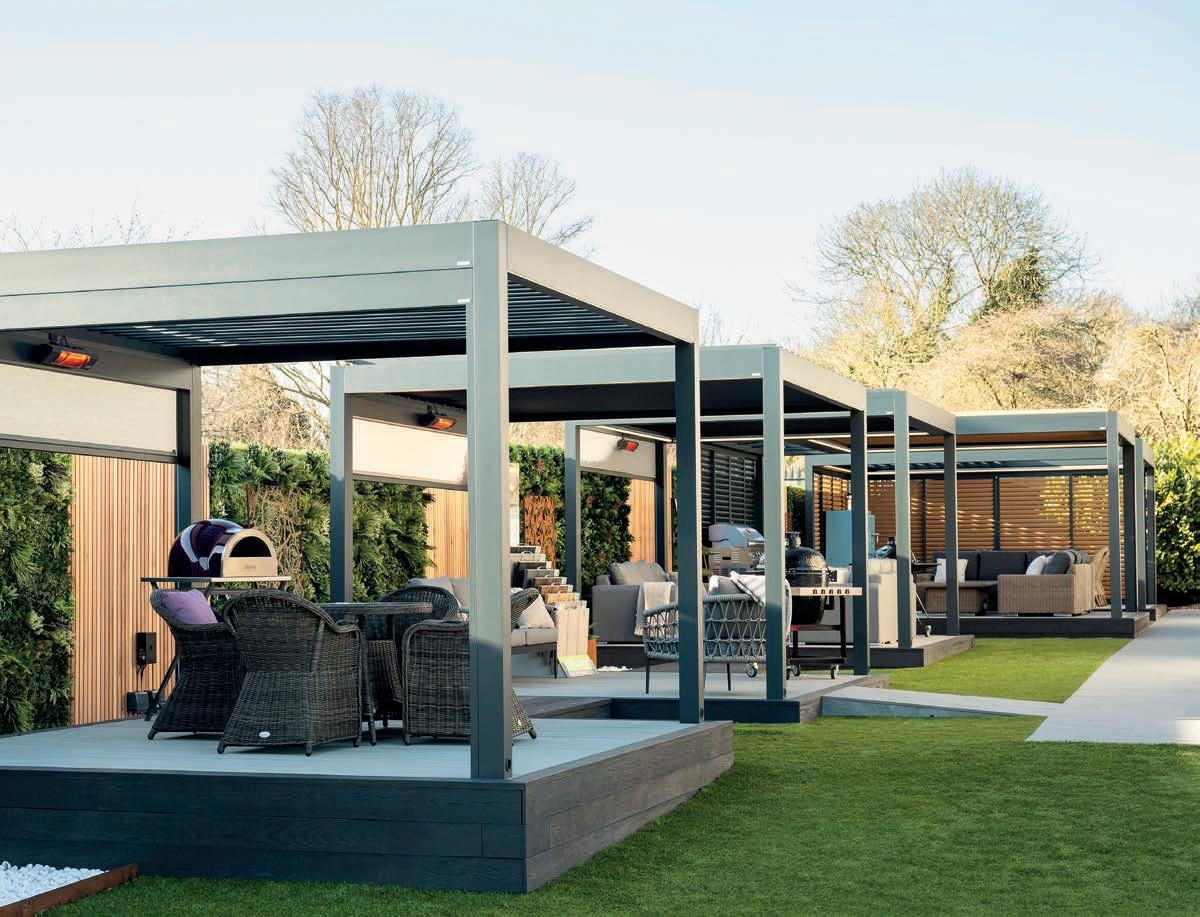

trade@cbsolarshading.co.uk
cbsolarshading.co.uk/trade
Eljays44 Ltd, BizSpace, Courtwick Lane, Littlehampton, West Sussex, BN17 7TL Tel: 01903 777 570
Features writer – Ashleigh Brown ashleigh.brown@eljays44.com
Features writer – Bethany Vann bethany.vann@eljays44.com Tel: 01903 959 394
Editorial assistant – Aidan Williams aidan.williams@eljays44.com Tel: 01903 777 570
Senior subeditor – Katrina Roy katrina.roy@eljays44.com Tel: 01903 777 570
Senior designer – Kara Thomas kara.thomas@eljays44.com
Sales executive – Lewis Everle lewis.everle@eljays44.com Tel: 01903 777 588
Sales executive – Ollie Finch ollie.finch@eljays44.com Tel: 01903 777 579
Horticulture Careers – Ollie Finch ollie.finch@eljays44.com Tel: 01903 777 579
Managing director – Jamie Wilkinson jamie.wilkinson@eljays44.com Tel: 01903 777 589
Divisional director – David Griffiths david.griffiths@eljays44.com Tel: 01903 777 584
Content director – Nina Mason nina.mason@eljays44.com Tel: 01903 959 393
Commercial director – Luke Chaplin luke.chaplin@eljays44.com Tel: 01903 777 582
Subscription enquiries – Laura Harris laura.harris@eljays44.com Tel: 01903 777 575
Printed by Stephens and George Ltd
Published by ©Eljays44 Ltd – Connecting Horticulture. Pro Landscaper’s content is available for licensing overseas. Contact jamie.wilkinson@eljays44.com
Pro Landscaper is published 12 times per year by Eljays44 Ltd. The 2024 subscription price is £128. Subscription records are maintained at Eljays44 Ltd, BizSpace, Courtwick Lane, Littlehampton, West Sussex, BN17 7TL, UK. Articles and information contained in this publication are the copyright of Eljays44 Ltd and may not be reproduced in any form without the written permission of the publishers. The publishers cannot accept responsibility for loss of, or damage to, uncommissioned photographs or manuscripts.
Whilst every effort has been made to maintain the integrity of our advertisers, we accept no responsibility for any problem, complaints, or subsequent litigation arising from readers’ responses to advertisements in the magazine. We also wish to emphasise that views expressed by editorial contributors are not necessarily those of the publishers. Reproduction of any part of this magazine is strictly forbidden.
Pro Landscaper is proud to be an Accredited Supplier member of BALI
Pro Landscaper is proud to be an associate member of the APL

It will hopefully be obvious to most that we’re not ones for standing still. Playing it safe makes us fidgety, and FutureScape is possibly the best example for this. For a start, we’re keeping everyone on their toes by hosting it a whole month earlier, on 15 and 16 October. On top of that, we’re making its co-located shows –Public Spaces Expo and the Outdoor Living & Wellness Expo – bigger and better than ever with a plethora of new features. There’s the Garden of the Future led by Utopia Landscapes, Landscape Performance Live hosted by Hyphae Learning, and the first StoneScape Expo, to name a few.
We’re not the only ones focused on moving forward, though. Those who have been shortlisted for this year’s Pro Landscaper Sustainability & Biodiversity Awards (page 10) are looking to make a difference. They’re exploring innovations and trying old and new methods, all with the intention of reducing their environmental impact and helping the landscaping industry become even more ‘green’.
Then there’s the winners of Pro Landscaper’s 30 Under 30: The Next Generation (page 71). They’re looking ahead to see how they can shape the industry and leave their mark. This year is a milestone year for this initiative, where we recognise rising stars, and we’re now celebrating the total alumni reaching an astonishing 300.
We’re always open to new ideas as well. So, why not stop by our stand at FutureScape and let us know what else you’d like to see from your favourite magazine and trade show? See you there – and in the meantime, enjoy this month’s Four Nations Special!

13
How can I keep track of the carbon footprint of my design?
It’s difficult but there are ways to measure and reduce your impact, explains Jilayne Rickards
14
Becoming the best version of yourself
Hyphae Learning’s Sam Grayson sets out five areas to focus on for enhancing your business’ performance
31 Standing Strong
Pro Landscaper Business Award winner Marc Murray on raising the bar for landscaping in Scotland


42
Biodiversity Goals
Idverde has been working with Manchester City FC for the last eight years, creating habitats on the estate to attract local wildlife
46
Sustainable Serenity
The environment was at the heart of this Irish garden created by Lavender Landscapes, which blended contemporary style with natural materials
51
Nestled in the Heart of Edinburgh
Stephen Ogilvie Ltd has designed and built a jaw-dropping family garden in the centre of the Scottish capital
71
Pro Landscaper’s 30 Under 30: The Next Generation
Discover this year’s 30 rising stars, who bring the total to 300 winners since the initiative was launched in 2015
84
Made in Britain special
The trademark recognises British manufacturers – discover some of the products made close to home
93
Taking to TV
Garden designers are becoming small screen stars and striving to influence how the profession is seen by the public
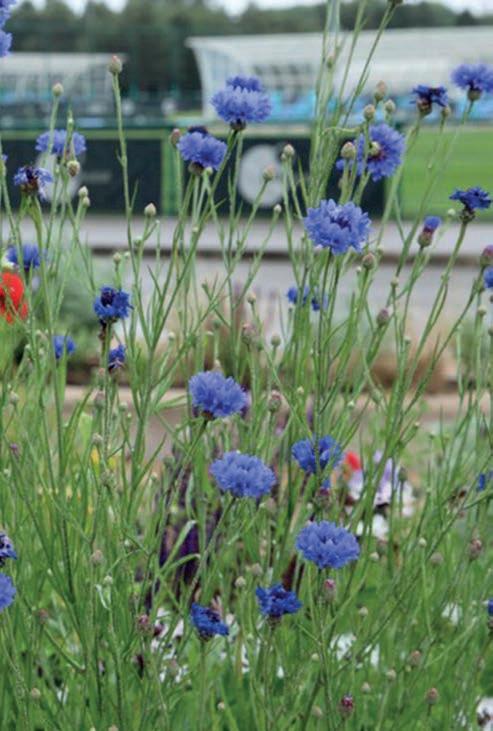
103
How is climate change affecting planting choices in Scotland?
A rapidly changing climate is influencing plant selection in Scotland, explains Rachel Bailey
108
Time to Plan: Plant Trees and Get Messy With tree planting season almost here, Mark Straver shares his tips for planning ahead and encourages a ‘messier’ approach
115
Five Minutes With: Kersten Catella Wyevale Nurseries’ sales director is one of the newest members of the board for the British Association of Landscape Industries
Pro Landscaper Sustainability & Biodiversity Awards 2024
The shortlist of the greenest companies, projects and individuals has been announced
27
Share the Load
Outdoor Living Gardens’ founder John Tallis has spent the last two years building his company’s reputation from scratch
37
On the Road to Success
Buiding alliances and receiving support from the Welsh government have been pivotal for Inscapes, enabling it to grow



THIS YEAR’S NATIONAL LANDSCAPE AWARD WINNERS REVEALED

The winners of the National Landscape Awards have been announced, with 79 accolades going out to 56 members across 24 categories.
Run by the British Association of Landscape Industries (BALI), it follows a summer of site visits to the UK-based entries and three days of debate by the judges.
Assisting with the deliberations were BALI chief executive Wayne Grills and events project manager Emily Feeney.
“These schemes, and our members, showcase meticulous attention to detail, innovative design, and a profound respect

Almost half (48%) of companies operating in affected areas have said they were impacted by the Ultra Low Emission Zone (ULEZ) expansion in August last year, according to a recent survey by Pro Landscaper.
A staggering 80% of these reported their profit margins reducing as a result and more than half (53%) said they had experienced a major increase in operational costs. A fifth also noted a reduction in their turnover.
As of 29 August 2023, all London boroughs are included in the ULEZ,
which was first introduced five years ago as a measure for tackling air pollution.
It requires drivers of non-compliant vehicles to pay £12.50 per day to travel in these areas. Though most petrol vehicles under 16 years old and diesel vehicles under six years old are likely compliant with the emission standards, the expansion a year ago has seemingly taken its toll on landscaping companies.
A fifth (19%) said they now limit their operations in ULEZ areas, whilst others have been forced to adjust their pricing in affected areas to counteract the charge.
for the natural environment,” says Grills. “Each project reflects the highest standards of the craft, resulting in landscapes that are both beautiful and enduring.”
It has been a busy month for BALI, which has appointed its new national chair and vice-chair, alongside five new board directors at its AGM.
Adrian Wickham will succeed Tessa Johnstone as national chair and thanked her for the energy she gave to the role, while Matt Nokes has been appointed as vice-chair. bali.org.uk

The Nurture Group has completed its 49th acquisition with a deal for Hortech, an environmental services provider. Hortech will trade under the Nurture Landscapes brand which will help underpin its sustainability and environmental services priorities.
“As a carbon neutral business proud of our compliance with the global PAS 2060 standard, this is the perfect marriage for us as we reinforce our environmental service lines across our UK network,” says Peter Fane, executive chairman and founder of the Nurture Group.
It follows the acquisition of Spacecare in August and is Nurture’s 49th acquisition since its formation in 2008.
Hortech director Duncan Jones spoke of how the two companies are a natural fit. “We share Nurture Group’s passion for delivering first-class service, and our portfolio aligns perfectly with theirs.” hortech.co.uk
UK horticulture businesses are facing new Brexit inspection charges amid concerns about biosecurity as the Common User Charge (CUC) is introduced. It has been implemented at Sevington, the government’s £147m Border Control Post, for plant imports from the EU, placing increased financial pressure on businesses,

Chris Wellbelove has been appointed managing director of Blakedown Landscapes, as he continues his progression within the company.
Wellbelove has been an integral part of Blakedown Landscapes over his 15-year career at the company, so he is well-prepared to assume the new leadership role, says Blakedown.
particularly smaller ones. Despite being intended to help finance biosecurity measures, the level of inspections remains low, leading to worries about whether the checks adequately protect UK biosecurity.
Sally Cullimore, technical policy manager at the Horticultural Trades Association (HTA), says: “As discussions continue and the peak import season for trees approaches, there is an urgent need for the government to resolve these issues and provide clearer communication, address operational challenges, and ensure that they achieve their intended biosecurity goals without unduly burdening UK businesses.” hta.org.uk
He will lead and support the management team in enhancing its operational strengths and nurturing its positive reputation across the industry.
“I am looking forward to taking on the role of managing director and working with our talented team to build on the solid foundation we’ve established,” says Wellbelove.

This strategic appointment marks an “exciting” step forward for the company, reinforcing its commitment to maintaining its strong market position.
Grounds maintenance provider Tivoli has unveiled its first sustainability report with promising signs for the company.
“While this is an exciting new chapter, it’s business as usual. We are fully committed to maintaining our high standards, fostering innovation, and delivering outstanding results for our clients.”
Steve Buckingham, who has led as managing director, will continue to play a key role within the Blakedown Group. blakedown.co.uk

It provides an overview of sustainability initiatives across the business from 1 April 2023 to 31 March 2024 and focuses on four key themes: community, technology, people and
environment, each with two areas of action.
The company aims to be net zero by 2030 for its scope one and scope two emissions. It also predicts its carbon emissions will decrease over the next five years by 50% on its baseline by 2027, and the report shows it’s on track.


ROMY RAWLINGS: SUSTAINABILITY HAS TO BE FOR EVERYONE
Romy Rawlings, speaking after launching the website for DeepGreen, says that when it comes to sustainability, it must be for everyone for it to succeed.


LANDFORM CONSULTANTS TO LAUNCH A NEW COLLABORATIVE VENTURE
Mark Gregory, managing director of Landform Consultants, speaks to us about the Glasshouse Collective – a fusion of teaching, collaboration and conversations, all within a high-end setting.


DANNY CLARKE: “WHAT HAPPENED TO ME WAS ONE IN A MILLION”
The host of this year’s Land-based and Environment Learner (LBEL) of the Year Awards, Danny Clarke, shares his unique pathway into horticulture and being discovered for the small screen.
The report highlights a new horticultural garden which was built for the residents of homeless charity New Hope in Watford, Hertfordshire and how it supported the development of Ashdown Vale Allotments in Barnham, West Sussex.
Nicola Keach, chief executive officer, says: “This is our first sustainability report; a milestone that reflects our deep commitment to integrating sustainability into every aspect of our business.” tivoliservices.com
With sustainability, biodiversity, and support for the landscaping and horticulture industries on the agenda, the recent election results bring new opportunities. What actions can the new government take to advance these priorities and benefit our nation?






FTTUK’s leading children’s
ollowing the recent election results, there are several key areas where the new government can make significant contributions to sustainability, biodiversity, and support for the industry, particularly focusing on children's gardening:
1. Introducing gardening and horticulture as a core component of the school curriculum can educate the next generation about sustainability and biodiversity from a young age. This
he shift in thinking at government level that I believe is crucial is recognising that effective long-term maintenance is key to ensuring good quality, biodiverse green infrastructure stays that way. Poor quality green spaces provide fewer benefits – both to the environment and to society.
The shift in thinking at government level that I believe is crucial is recognising that effective long-term maintenance is key to ensuring good quality
We need to see effective policing of Biodiversity Net Gain, and good quality landscapes treated as a priority when implementing the ambitious housebuilding figures that have been mooted. Let's wait and see!
he horticultural sector, a beacon of resilience in the face of change and uncertainty, consistently adapts to the ‘new normal’. Businesses – from landscapers to growers and retailers to suppliers – are all navigating and understanding consumer needs, dealing with changeable weather, addressing ongoing cost hikes, managing global trade issues, and complying with government regulations.
Now is certainly the time to work together, share information, and navigate change and challenge
Now is certainly the time to work together, share information, and navigate change and challenge. That is why the Horticultural Trades Association (HTA) team is collaborating with policymakers nationally, including those in devolved administrations, to highlight the sector’s value in delivering green spaces that drive economic growth and create healthier and wealthier communities. From last year’s Scottish Strategy to the welltimed Environmental Horticulture Manifesto and the recent Welsh Strategy, the HTA prioritises understanding and engaging with key stakeholders. We are advocating for horticulture and providing unwavering support to our members, ensuring they can sustain and grow their businesses with confidence.
This initiative can be instrumental in teaching an early appreciation for the environment
initiative can be instrumental in teaching an early appreciation for the environment and the importance of green spaces.
2. Allo cating funds to develop and maintain school gardens across the nation will ensure that children have hands on learning opportunities. These gardens can serve as outdoor classrooms where students learn to grow their own food, understand the importance of pollinators, and appreciate the role of plants in our ecosystem. Providing resources and training for teachers to integrate these gardens into their lesson plans is crucial.
3. To support the landscaping and horticulture industry, the government can launch campaigns to highlight the diverse career opportunities within the sector. This includes apprenticeship programmes and providing incentives for businesses to hire young people interested in horticulture. By showcasing the importance and rewards of a career in this field, the industry can attract more talent and ensure its growth and sustainability.
By addressing these areas, the new government can make substantial progress in promoting and supporting the horticulture industry, while also making a significant impact on children's education and wellbeing.




DESIGN PROJECT
CARLTON NATURAL SWIMMING POOL AND GARDEN

CLIMATE POSITIVE GARDEN, PAISLEY
RACHEL BAILEY GARDEN DESIGN LTD
PARK END THATCH ELLICAR
SUSAN YOUNG GARDEN DESIGN
SUPPLIER
FIRST BASE GROUND SCREWS
HILLIER NURSERIES LTD
PROVENDER NURSERIES LTD LANDSCAPING
THE RHS PEAT – FREE FEATURE GARDEN, HAMPTON COURT PALACE GARDEN FESTIVAL 2024. DESIGNED BY ARIT ANDERSON
BEAUFORT AND RAMPTON LANDSCAPES LTD
KNEPP WILDING ‘DOG WALKERS CAR PARK’ & KITCHEN
GRADUATE LANDSCAPES LTD
UNDER TREES STUDIOS
MONICA KNIGHT DESIGN
A FOUR SEASON SANCTUARY, STARTER GARDEN AT RHS HAMPTON COURT FESTIVAL 2024
TIM JENNINGS DESIGN. GREEN VISION LANDSCAPING
LANDSCAPE ARCHITECTURE STUDIO
HTA DESIGN LLP
MACFARLANE + ASSOCIATES OOBE
ATV CONTRACT SERVICES LTD
GRADUATE LANDSCAPES LTD
WATER GEMS ALBA LTD
SUSTAINABLE PRODUCT OF THE YEAR – SOFT LANDSCAPING
NET GAIN TOOL
JOE’S BLOOMS
INVERTEBRATE PLANTER
CARBON4GRASS RANGE
NICHE ORIGIN AMENITY SOLUTIONS
GREENBELT GROUP
IDVERDE UK
NURTURE LANDSCAPES LTD
GARDEN DESIGN COMPANY
HP GARDEN DESIGN
RACHEL BAILEY GARDEN DESIGN LTD
SUSTAINABLE PRODUCT OF THE YEAR – HARD LANDSCAPING
CARADON WALLING STONE
CARADON STONE
UTM® BY ETHICAL STONE® TERRAZZO
ETHICAL STONE
CUBIC OUTDOOR KITCHEN (C1 PURE) TREEPARKER
HALE CHAPELS’ GARDEN
GRADUATE LANDSCAPES LTD
ATELIER GARDENS, BERLIN
HARRIS BUGG STUDIO
HOLYROOD KIOSK, HOLYROOD STREET
MACFARLANE + ASSOCIATES
SUSTAINABILITY AND BIODIVERSITY LEADER
PETER NORTHCROFT
JOHN O’CONNER GROUNDS MAINTENANCE LTD
CHRISTINE LEUNG

NORTHSTOWE
CHINEHAM PARK
NURTURE LANDSCAPES LTD
KINGSWOOD FIELDS GREENBELT GROUP
QUALITY & SERVICE LTD (Q&S)
COMMERCIAL DESIGN PROJECT –TEMPORARY INSTALLATION
ECO OASIS GARDEN
DAN HARTLEY GARDEN DESIGN
ROOTSPACE GENERATION 2
GREENBLUE URBAN LTD
SHIRE OUTDOOR KITCHENS GREEN-TECH
STEINTEC TUFFBED 2-PACK BS 7533 TYPE 35 LOW
CARBON SUDS PERMEABLE BEDDING MORTAR
TUFFBAU LTD TRADING AS STEINTEC

LOTUS BROOK
DAVE TAYLOR
NURTURE LANDSCAPES LTD
NOEMI MERCURELLI
PC LANDSCAPES LTD
KAY GEOGHEGAN
‘THE FREEDOM FROM TORTURE GARDEN: A SANCTUARY FOR SURVIVORS’ DESIGNED BY EOGD IN COLLABORATION WITH SENSELESS ACTS OF BEAUTY
EMMA O’CONNELL GARDEN DESIGN
THE CLIMATE-FORWARD GARDEN
MELANIE HICK GARDEN DESIGN
TYLER GRANGE GROUP LTD MAINTENANCE CONTRACT
THE SOUNDS OF ADVENTURE GARDEN
WE LOVE PLANTS GARDEN DESIGN BY NIC HOWARD





Established 1864
As sustainability becomes increasingly important, the role of trees in combatting climate change, supporting bodiversity, and improving the environment has never been clearer.
Ready to make a sustainable choice? Get in touch to discover our British-grown trees for your project!




trees.hillier.co.uk


treesales@hillier.co.uk 01794 368 733
Download The Hillier Tree Guide
Your guide to our range of trees. Showing their form and size over 15, 25 and 50 years, plus helpful information on suggested usage for a variety of projects and locations.
Scan this QR code to download your copy today!
Hillier Trees: Supplying the landscaping industry for 160 years.



How can I keep track of the carbon footprint of my design?
Jilayne Rickards considers where to start and the solutions available
Most designers (including myself) are confused about how to calculate their carbon footprint for their designs. Having tried various online carbon calculators, there isn’t one that is specific to our industry that is easy to use – the best being Pathfinder, which is okay once you get the hang of it but still not particularly accurate. It does, however, highlight if items are high carbon so that we can address this accordingly. I use it at the very start of the design and add items as I go along, rather than loading all the information in at the end. On a positive note, there is a wonderful free-to-use app being developed at the moment (and due to be launched this year) that will help us to consider our approaches and which will, in turn, reduce carbon.
place to get quick answers. My feeling is that we need government to set legislation so that suppliers have to truthfully state the carbon footprint of their products (in much the same way as ingredients are shown on food labelling).
Time spent in researching carbon from suppliers and products can be frustrating as there is no industry standard and no easy go-to place to get quick answers
Key items I like to consider from the outset are reducing waste by keeping and re-using as much on site as possible (including water), minimal paving for concrete reduction and increased planting (cement having a very high carbon footprint, so substitute with cement-free alternatives if possible), sourcing local, natural products and preferably recycled (rather than imported manmade), which leads nicely into considering construction techniques. Ground screws for decking/offices/sheds, dry stone walling on compacted hardcore bases, and setts laid on sand bases can all help with reducing carbon.

Chair of the APL, Holly Youde, is a director at Urban Landscape Design in the North West and The Landscape Academy, a purpose built training centre dedicated to landscaping in the UK.

JAKE CATLING
Jake founded his domestic landscaping company, The Landscaping Consultants, aged just 24. He is now a BALI board director, host of the Landscape Performance Podcast, and has delivered various award-winning gardens and outdoor spaces.

KEN WHITE
Ken White, former chairman of the APL, leads the multi-award-winning Frosts Landscape Construction, which carries out large commercial and private estate projects across the UK.
Time spent – and therefore additional design costs – in researching carbon from suppliers and products can be frustrating as there is no industry standard and no easy go-to
Add ons from there include using local nurseries to reduce transport carbon, including a good mix of evergreen and deciduous trees and shrubs to absorb carbon, along with thoughts about how the planting scheme can support and increase biodiversity in the area.

So, in a nutshell, it’s really hard to calculate our carbon footprint for garden design, but by using the pointers above we can hopefully create stunning gardens without doing too much damage along the way and mitigating that damage with resilient planting. And until such time as there are easy-to-use, industryrelevant, standardised calculators, as well as legislation for supply information, we shall have to continue staggering about doing the best we can.

Rosemary has won numerous awards for her work, creating high quality gardens for both domestic and commercial clients. She is a fully registered member of the SGD and sits on the board of directors at BALI.

JILAYNE RICKARDS
Based in Cornwall, Jilayne Rickards is a multi-award-winning garden designer who puts sustainability and biodiversity at the heart of her designs, including her show gardens at Chelsea, both of which have been relocated to the Eden Project.
As a landscaping professional, you're not just shaping the outdoors; you're also shaping your future. In this demanding industry, your success hinges on more than just skill and hard work. It’s about optimising every aspect of your life – from your health to your mindset. Remember, the better you take care of yourself, the better you can serve your clients and grow your business. Let’s explore how you can become the best version of yourself, both on and off site.
In this industry, maintaining peak performance is essential. As a professional or business owner, your wellbeing is the foundation of your success. To thrive, focus on five key areas: sleep, diet, balance, exercise, and relationships.
Prioritise sleep:
The foundation of performance
Sleep is the bedrock of your physical and mental health. In landscaping, where long hours and physical labour are common, quality sleep is essential for recovery and performance. Aim for seven to nine hours of sleep each night. Insufficient sleep can lead to decreased cognitive function, impaired motor skills, and increased susceptibility to stress and injury – all of which are detrimental in a physically demanding job. Establish a bedtime routine that helps you unwind, and avoid screens and heavy meals before bed.
Fuel your body with the right diet
Diet is crucial for maintaining high energy levels and overall wellbeing. Your body needs the right nutrients to perform optimally. A balanced diet rich in fruits, vegetables, lean proteins, and whole grains will provide the sustained energy you need. Studies show that diets high in
processed foods and sugars can lead to energy crashes, reduced productivity, and long-term health issues. Stay hydrated, especially when working outdoors, to avoid fatigue and decreased cognitive function.
Achieve balance:
Work, life, and leisure
Balancing work with personal life is challenging but essential. The nature of landscaping often requires long hours, which can lead to burnout. Research indicates that a healthy work-life balance results in lower stress, higher job satisfaction, and better overall wellbeing. Set clear boundaries between work and personal time, and prioritise hobbies, family, and relaxation to recharge your mental and emotional batteries.
Incorporate regular exercise for physical and mental health
While landscaping is physically demanding, structured exercise is still crucial. Regular physical activity, like strength training and cardio, can enhance endurance, reduce injury risk, and improve overall fitness. Exercise is also a powerful stress reliever. A study published in The Lancet Psychiatry found that regular exercise significantly reduces days of poor mental health. Activities like yoga or swimming can complement the physical demands of landscaping by promoting flexibility and reducing muscle strain.
Cultivate quality relationships
Relationships are integral to your success and happiness. Positive relationships with employees, clients, and industry peers foster a supportive work environment and drive business growth. Strong social connections are associated with lower rates of anxiety and depression, higher
self-esteem, and greater longevity.
On a personal level, spending quality time with loved ones provides emotional support and reduces stress. Cultivate a network of peers who understand the unique challenges of the landscaping industry.
Being the best version of yourself requires a holistic approach that addresses both physical and mental wellbeing. The more you invest in your wellbeing, the more you’ll be able to invest in your work and the people around you. If you are interested in this topic further, I would suggest the below podcast and book.


is the industry's first all-in-one digital knowledge hub. Combining expert knowledge from the industry to give business owners the place to go to upskill and empower their teams.
Check out the Landscape Performance Podcast, with Catling and Grayson as the hosts, on Spotify, Google & YouTube

● The high cost of currently specified turf with wildflowers leads to substitution with on-site seeding and this has predictably poor outcomes.
● Developers are seeking an affordable, instant greening solution for sales areas and public open spaces, but they are moving away from using amenity turf to achieve this.
● BNG legislation is significantly boosting demand, requiring growers to ensure they can meet this increased need over the long term.


To produce an affordable, pollinatorfriendly species rich turf that closely matches currently specified mixes, while avoiding the use of plastic reinforcement or imported growing mediums.
Additionally, the turf needs to be supplied in easy-to-handle rolls rather than awkward slabs.
Grasslands have pioneered the development of field grown turves containing wildflowers, using fine turf rolls as a carrier medium for the desired mixes.
Mechanisation has driven down production, harvesting and handling costs, reducing the purchase price for contractors.
Special Autumn rate of £5.50/m2 plus delivery (both subject to VAT).
While the work of professional landscapers
continues to evolve and adapt to unpredictable climatic patterns, one thing remains the same: Toro always helps get the job done.
As the Toro distributor for the UK, Reesink Turfcare is proud to support landscaping professionals with innovative tools that simplify operations.
In particular, the Toro range of groundscare mowers offers durable and efficient machines for a wide variety of terrains, landscapes and grass types. There’s a model for all needs that delivers impeccable results every time.
When it comes to largescale grass cutting, the Toro Groundsmaster 3300 provides unparalleled productivity. This out-front rotary mower with all-round viewing boasts a powerful 37.4 HP engine which, combined with its CrossTrax all-wheel drive and flail deck option, accelerates mowing operations even in the toughest terrain while maintaining flawless cut quality with coarse, wet and long grass.

With a max ground speed of 15mph it can quickly reach remote job sites, and the adjustable seating, easy access controls and optional heated cab means it’s comfortable for extended hours of cutting and supports long periods of productivity.
Electric machines like Toro’s Groundsmaster e3200, on the other hand, offer similar features with the added benefits of battery power without compromising on performance.

This out-front rotary mower can be powered by up to 17 HyperCell batteries to achieve all-day runtime whenever demanding projects require it, and the Smart Power system regulates mowing speed to optimise cutting efficiency in all conditions.
In addition, the battery reserve feature gives you the power you need to always reach the recharging station, and the on-board 3.3kW charger can prepare you for another full day with just an overnight charge. Thanks to a turning circle that allows agile movement between trees, flowerbeds and ornamental displays, this model can also be a good choice in tight areas.
Moreover, the Groundsmaster e3200 operates with zero emissions, helping support a cleaner environment and comply with the latest ESG regulations. Its electric motor
makes it significantly quieter than diesel models and perfect for noise-sensitive applications such as early morning mowing. A mower that achieves more with less is the Toro LT-F3000. The versatile design of this triple flail mower cuts easily through long, coarse grass, and with its cylinder attachment can mow short grass with precision. This model enables superior time and cost savings when reducing the frequency of cuts – as little as five or six times per season – while still delivering a superb finish. In addition, the LT-F3000 can lower expenses thanks to affordable parts and easy servicing, allowing you to get big results even with modest budgets.

To learn more about how Reesink Turfcare can support your mowing operations, visit reesinkturfcare.co.uk, call 01480 226800 or email info@reesinkturfcare.co.uk.
Marius Stäcker on harnessing mobile technology to boost productivity and enhance service

The gardening and landscaping industry is ripe for technological transformation in today's fast-paced digital world. Research from the Landscape Institute (LI) shows that more than 49,000 UK businesses are facing chronic skills shortages. Achieving greater productivity to counter this challenge and meet increasing demand for sustainable spaces is critical. Harnessing mobile technology's real-time capabilities and cloud functionality can significantly improve operations, customer service, and overall efficiency.
Improving operational flexibility
In a weather-dependent industry, operational efficiency and flexibility are key. Getting the right tools and personnel on-site within weather windows is critical, while having teams spread across multiple sites creates job management challenges.
Mobile technology enables greater flexibility and responsiveness. Real-time weather updates help adjust schedules to avoid unfeasible conditions, while real-time updates allow for last minute plan changes –ensuring everyone is kept up to date. Optimised job scheduling reduces fuel consumption and travel time, increasing productivity and allowing teams to complete more jobs. This increased flexibility improves service quality and helps you adapt more effectively to market changes and customer demands.
Boosting team communications
An advantage of mobile technology is its ability to digitise paperwork and streamline administrative tasks. Cloud-based software and mobile apps can generate and store digital contracts, capture electronic signatures, track job durations, and create digital invoices, speeding up payment processes. Lost or damaged documents are a common concern for landscapers who are working in varied weather conditions and visiting multiple sites throughout the day. Digital solutions reduce paper usage and enhance organisation – freeing up valuable time to redirect back into the business.
These solutions offer powerful data management and analysis capabilities that allow you to collect and store vast amounts of information in one centralised location accessible from any device. Analysing this data offers valuable insights into business operations, such as peak season staffing adjustments, profit-driven pricing optimisation, or employee productivity to improve training and resource allocation. Leveraging these insights enables data-driven decisions that will enhance efficiency and profitability.
It's not often that your whole team is in the same room, so being able to share client information and job updates remotely makes it easier to understand workloads, reward good work, and be prepared for any situation, even when plans change at the last minute. Cloud-based software is user-friendly, scalable, and flexible – far surpassing traditional desktop tools like Excel and Word.
Mobile technology allows for instant communication between you and your clients. Our research found that customers value reliability (75%), trustworthiness (73%), professionalism (65%), and overall service experience (60%). Digitising diary management reduces the chance of missing appointments and job sheets, or automated SMS reminders show clients that they're a priority. User-friendly mobile software makes it easier for landscapers to navigate customer requests, improving satisfaction and enabling prompt responses to inquiries and concerns.
Bristol-based Just Plants uses job management software on its mobile devices and PCs/laptops to record site visits and work completed so that client job sheets are easy to complete and send. It also tracks PPE and health and safety checks for internal use. For director Adam Bailey, the tool helps enormously with scheduling, keeping jobs on track, time management, and accountability across the team and with customers.
Like Just Plants, by embracing mobile technology, you can transform operations, positioning yourself at the forefront of your industry and ready to meet the challenges and opportunities of the digital age.

MARIUS STÄCKER
Marius Stäcker is the CEO of ToolTime, which he founded with Marcel Mansfeld in Berlin in 2018 to make everyday work easier for tradesmen. The tool uses cloud-based software with which administrative processes are digitised and mapped in a central operating system. This not only puts an end to the paperwork, but also allows all operational processes to be carried out more efficiently. It covers functions such as working time recording, appointment planning, construction site documentation or creating offers and invoices. tooltime.app/uk







Boomkwekerij Ebben in Cuijk is sinds 1862 actief als producent van duurzaam geteelde bomen en andere beplanting voor de realisatie van nationale en internationale groenprojecten. Met een veelzijdige en bijzondere collectie bomen en heesters voor elk denkbare toepassing weten we ieder groenproject te transformeren tot een buitenruimte van formaat.
Boomkwekerij Ebben in Cuijk is sinds 1862 actief als producent van duurzaam geteelde bomen en andere beplanting voor de realisatie van nationale en internationale groenprojecten. Met een veelzijdige en bijzondere collectie bomen en heesters voor elk denkbare toepassing weten we ieder groenproject te transformeren tot een buitenruimte van formaat.
Boomkwekerij Ebben in Cuijk is sinds 1862 actief als producent van duurzaam geteelde bomen en andere beplanting voor de realisatie van nationale en internationale groenprojecten. Met een veelzijdige en bijzondere collectie bomen en heesters voor elk denkbare toepassing weten we ieder groenproject te transformeren tot een buitenruimte van formaat.
Ebben Tree nursery has been active since 1862 as a producer of sustainably cultivated trees and other planting for the realisation of national and international green projects. With a versatile and special collection of trees and shrubs for every conceivable application, we know how to transform every green project into an outdoor space that makes an impact.
Boomkwekerij Ebben in Cuijk is sinds 1862 actief als producent van duurzaam geteelde bomen en andere beplanting voor de realisatie van nationale en internationale groenprojecten. Met een veelzijdige en bijzondere collectie bomen en heesters voor elk denkbare toepassing weten we ieder groenproject te transformeren tot een buitenruimte van formaat.
Vraag onze experts voor advies over het juiste groen voor uw project. Klimaatbomen, klimbomen of bomen met een speciale kleur, vorm, hoogte of breedte; we helpen u graag. Zelf aan de slag? Stel met enkele klikken het perfecte assortiment samen met de bomentool treeebb.com
Vraag onze experts voor advies over het juiste groen voor uw project. Klimaatbomen, klimbomen of bomen met een speciale kleur, vorm, hoogte of breedte; we helpen u graag. Zelf aan de slag? Stel met enkele klikken het perfecte assortiment samen met de bomentool treeebb.com
Vraag onze experts voor advies over het juiste groen voor uw project. Klimaatbomen, klimbomen of bomen met een speciale kleur, vorm, hoogte of breedte; we helpen u graag. Zelf aan de slag? Stel met enkele klikken het perfecte assortiment samen met de bomentool treeebb.com
Want to get to know us? Come and visit our 550-hectare nurseries and experience our 1.400 m2 of roof gardens with fruit trees, herbs and a tree house. We invite you to step into our green world and ask our experts for advice on the right greenery for your project. Climate trees, climbing trees or trees with a special colour, shape or characteristics; we are happy to help you. You can also put together the perfect assortment yourself in just a few clicks with the tree moodboard tool treeebb.com
Vraag onze experts voor advies over het juiste groen voor uw project. Klimaatbomen, klimbomen of bomen met een speciale kleur, vorm, hoogte of breedte; we helpen u graag. Zelf aan de slag? Stel met enkele klikken het perfecte assortiment samen met de bomentool treeebb.com


Boomkwekerij Ebben | Beerseweg 45 | 5431 LB Cuijk T +31 485 312021 | info@ebben.nl
Ebben Tree Nursery | Beerseweg 45 | 5431 LB Cuijk – The Netherlands
Boomkwekerij Ebben | Beerseweg 45 | 5431 LB Cuijk
www.treeebb.com
T +31 485 312021 | info@ebben.nl | www.ebben.nl | www.treeebb.nl

Ihad a recent expert witness commission regarding gravel stabilisation grids. After doing some extensive research, I thought I’d share some of my findings – and quality is absolutely key.
Gravel stabilisation has rapidly emerged as a go-to solution in the UK for creating stable, durable surfaces, particularly in high-traffic areas such as driveways, pathways, and patios. This method utilises gravel grids to secure gravel in place, thereby reducing the need for ongoing maintenance and extending the lifespan of the surface.
The increasing popularity of gravel stabilisation can be attributed to several factors, including its compliance with sustainable drainage systems (SuDS) regulations, which are becoming more stringent due to local council requirements (and will be mandatory with the eventual implementation of Schedule 3).
Gravel grids help to make surfaces compliant with the Disability Discrimination Act (DDA) too, ensuring they are suitable for wheelchair users and those with walking aids. The method also offers a cost-effective solution in light of the ongoing cost of living crisis, providing an affordable yet durable option for property owners.
As an independent reviewer, it’s important to delve deeper into the various aspects that contribute to the effectiveness of gravel
stabilisation, including the design and material quality of gravel grids.
Gareth Wilson outlines what landscapers need to be considering when choosing gravel stabilisation grids
Gravel stabilisation is fundamentally about maintaining surface integrity by preventing gravel migration. When gravel remains locked in place, the surface remains smooth, level, and visually appealing, even under heavy use. The key to achieving this lies in the design and quality of the gravel grids employed.
The distinction between open cell and closed cell grid designs is critical when evaluating the effectiveness of a gravel stabilisation system.
frequent use or over time if the sub-base was to move slightly.
Closed cell designs, on the other hand, incorporate some form of base, often made of geotextile or perforated plastic. This base serves as a barrier, preventing gravel from migrating underneath the grid and ensuring that the aggregate remains securely in place within the cells. The result is a tray-like structure that holds the gravel, providing a stable and long-lasting surface.
Closed cell designs, while more expensive to produce, offer significant advantages in terms of performance and longevity
Open cell grids are typically smaller tiles without a base, often employed for both grass and gravel surfaces. The design’s primary appeal lies in its cost-effectiveness; manufacturing these grids is less expensive, making them an attractive option for budget-conscious projects. However, the open nature of these grids introduces significant performance drawbacks.
Without a base, gravel can easily slip beneath the grid walls, causing the grids to lift and become exposed over time. This not only disrupts the surface’s aesthetic appeal but also creates potential safety hazards and long-term durability issues. The risk of grid displacement is particularly high in areas subjected to
Closed cell designs, while more expensive to produce, offer significant advantages in terms of performance and longevity. The added stability provided by the base is particularly beneficial in high-traffic areas, where the risk of grid displacement and surface degradation is higher.
Material selection plays a crucial role in the effectiveness and durability of gravel stabilisation systems. Two primary materials dominate the market: Polypropylene (PP) and High-Density Polyethylene (HDPE). Each material has distinct properties that affect its performance in gravel grid applications.

Polypropylene is a popular material for gravel grids due to its strength and flexibility under standard conditions. However, PP has a significant limitation: its performance deteriorates sharply in cold weather. At temperatures around 0°C or lower, PP becomes brittle, losing its flexibility and becoming prone to cracking. This characteristic makes PP a less reliable option in environments where freezing temperatures are common, as its structural integrity can be compromised.

High-density polyethylene (HDPE) is generally considered the superior material for gravel grids, especially in climates with variable or harsh weather conditions. HDPE is known for its high strength-to-weight ratio, durability, and UV stability. Unlike PP, HDPE maintains its flexibility and strength even in cold temperatures, making it an ideal choice for gravel grids that need to withstand heavy loads and prolonged exposure to the elements.
HDPE is also resistance to cracking and its ability to endure environmental stressors without degrading over time contribute to its reputation as the material of choice for high-quality gravel stabilisation systems.
of connections and adjustments required. This not only speeds up the installation process but can also improve overall surface uniformity, as fewer seams mean fewer potential weak points.
For contractors looking to maximise efficiency and minimise time on the job, opting for larger grid panels is usually the better choice
While HDPE is highly regarded, low-density polyethylene (LDPE) is another material that, while more expensive, offers enhanced flexibility and impact resistance. LDPE is particularly suited for applications subject to extreme stress, such as truck yards or areas with frequent heavy goods vehicle (HGV) turning. However, due to its higher cost, LDPE is generally reserved for industrial or commercial settings and is not necessary for most domestic driveways or car parks, where HDPE provides more than adequate performance.
From a contractor’s perspective, larger panel sizes are often preferable because they allow for faster installation, enabling more grid to be laid down in a shorter amount of time. This can be particularly advantageous on larger projects, where time is a significant factor.
Larger panels cover more surface area with each placement, reducing the number
On the other hand, smaller panels – while potentially easier to transport and handle –take longer to install. The increased number of individual panels means more time spent aligning and securing them, which can add considerable labor costs to a project. Therefore, for contractors looking to maximise efficiency and minimise time on the job, opting for larger grid panels is usually the better choice.
When considering gravel grids, one often overlooked aspect is the method used to attach the geotextile membrane to the grid. This membrane is essential in closed cell designs, as it prevents gravel migration and enhances surface stability.
Geotextile membranes can be attached to the grid base using either heat welding or adhesive glues. It is imperative to opt for grids where the membrane is heat-welded rather than glued. Heat welding fuses the membrane to the base, creating a bond that is both strong and durable. This method ensures that the membrane remains securely attached, even in wet conditions or over extended periods of use.
In contrast, glued membranes are susceptible to breakdown when exposed to moisture. Over time, the glue can deteriorate, leading to the detachment of the membrane from the grid base. This not only compromises the effectiveness of the gravel stabilisation but also increases maintenance costs and reduces the overall lifespan of the surface.
So, there are a few factors to consider when choosing which gravel grids to purchase:
Design type: Closed cell designs with some form of base are generally superior for long-term performance and stability, particularly in high-traffic areas.
Material selection: HDPE is the preferred material for its durability, flexibility, and resistance to environmental stressors, making it suitable for a wide range of climates.
Panel size: Larger grid panels are recommended for contractors seeking to optimise installation speed and reduce time on the job, especially on larger projects.
Construction quality: Ensure that geotextile membranes are heat-welded to the grid base. This method offers superior durability compared to glued alternatives, particularly in wet or challenging conditions.
Gravel stabilisation is a highly effective method for creating durable, low-maintenance, and accessible surfaces. The compliance with SuDS and DDA requirements also enhances its appeal, particularly in light of new regulations and economic pressures. Just be sure to consider the all of the above!

Leaving college at 17, Gareth has worked in the landscape industry since 1989. Progressing onto high-end projects, he has picked up seven RHS gold medals. He is a member of multiple professional bodies. He provides technical and product advice to large companies, mentors and trains contractors and garden designers in landscape construction and on show gardens logistics across the UK. Gareth also provides mediation services, he is a member of the BS7533:102 committee and is an industry awards judge.
gkwilsonlandscaping.co.uk


Sustainable timber solutions for the built environment with limitless design potential. From new designs to retrofits, the modular WoodBlocX system provides unrivalled versatility.



Create an instant plastic-free wildflower meadow and support Biodiversity Net Gain with our innovative solution. Our product allows you to effortlessly transform any space into a vibrant and biodiverse ecosystem, without the need for harmful plastic materials. Join us in promoting sustainability and biodiversity with our easy-to-use and environmentally friendly solution


There’s more exhibitors than ever to see at this year’s FutureScape – here's a handful of unmissable stands
BOOM & BONHEUR
Boom & Bonheur is a tree nursery that specialises in out-of-the-ordinary shapes and sizes. It has supplied many projects for well-known places like Disney, Versailles, Jubilee Gardens and the RHS Chelsea Flower Show, as well as lesser-known spaces such as private properties, estates, parks, and public spaces. With over 1,600 acres of specimen trees, shrubs, shapes and multistem trees, it can provide a unique selection of style and atmosphere for all projects. Its specialists will be happy to advise you on the assortment that fits the climate, location, and atmosphere of the design. The team looks forward to meeting you!
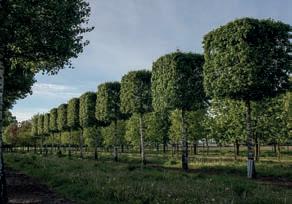
boomkwekerij-lappen.com
The EverEdge team is excited to join FutureScape once again. This year, as well as its standard range of steel lawn edging products, it will be bringing products that are targeted specifically at the trade including its hugely popular EverEdge Titan range of heavy-duty steel edging, EverEdge steel planters and new to the range Hydra. Hydra is a 4mm thick steel edge with a rolled top edge giving a 12mm thick top profile. EverEdge Hydra is designed for projects where concrete kerbs lack the aesthetic required. EverEdge is looking forward to seeing some of its customers face-to-face, and giving them an opportunity to get their hands on some of the products they may have seen online or in magazines but have not, as of yet, had the opportunity to install. everedge.co.uk

Visit Gardengate Group to see why, as one of Europe’s largest manufacturers in its sector, it is a leading force in the industry. Its stand will showcase its innovative premium aluminium products, including gates, fences, pergolas, entrance doors, carports and door canopies. Discover how Gardengate Group’s high-quality, weather-resistant solutions blend durability, style, and eco-friendliness. With nearly three decades of expertise, it is redefining sustainable, highperformance housing solutions. Drop by to explore its latest innovations and experience how its products can enhance any property. gardengate.group


Visit Green-tech to discover its awardwinning range of products and solutions to help transform landscapes with cutting-edge products and a commitment to biodiversity and sustainability. Green-tech is showcasing its range of biodegradable tree-planting shelters and the John Chambers Wildflower Seed. Also being profiled is TreeParker®, a versatile urban tree planting and water management cell system that is distributed exclusively in the UK by Green-tech, and offers a smart combination of green, grey, and blue to address the challenges of urban tree planting. green-tech.co.uk
Visit Kebur at Stand S90 for expert, one-to-one advice on your landscaping project. No matter what stage your project is at, Kebur has everything you need to bring your vision to life from the ground up. Explore its extensive range of top-quality hard landscaping products, including Sinai Pearl limestone setts, Purbeck walling, and porcelain paving. With its dedicated account support, competitive pricing, bespoke sourcing and quick deliveries, learn how Kebur’s trade accounts will help you achieve project success. Plus, don’t miss Millboard showcasing its premium decking and cladding. Elevate your outdoor space and discover the best in landscaping supplies. kebur.co.uk

Stand S90
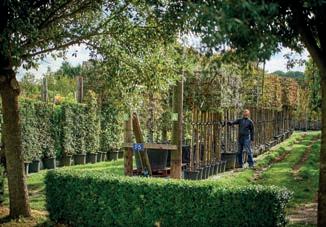
Provender Nurseries, established in 2003, is well known for its impressive range of plants available to the horticultural trade at wholesale prices. With biosecurity, choice and quality at the core of Provender’s principles, members of its knowledgeable team will be on hand to discuss plant options for you for the year ahead. Showcased on its stand, L30, is a range of some of the excellent tree choices to be found at its 18-acre nursery in Kent. provendernurseries.co.uk
Established in 2006, Rainwater Harvesting is one of the UK’s leading manufacturers and suppliers of rainwater harvesting equipment. Rainwater harvesting is the process of taking rainwater from the roof, down your downpipe into a storage tank. This water can be used for your washing machines, toilets, watering your plants and washing your cars. The company will be showcasing its rainwater equipment nd accessories. By visiting it, you'll discover cutting-edge technologies and practical applications that can help you save water, reduce costs, and contribute to a greener future. rainwaterharvesting.co.uk


Landscapeplus is a trade-only supplier of outdoor lighting, irrigation and water feature systems, working with garden professionals across the UK. It is not just a one-stop-shop, and takes pride in being “so much more than a supplier”. Its nationwide training days allow Landscapeplus to share knowledge and give its customers the confidence to both design and install, aided by its free design support service. This year, it is very excited to be showcasing a brand-new product range beside a variety of hand-selected light fittings, housed within beautiful Corten planters. You’ll also be able to see some of the team presenting in the Lighting Theatre. landscapeplus.com
Q-railing – the premium brand in railing systems will be exhibiting at stand N50. As an innovator in the field of railing systems, Q-railing provides complete solutions that are instantly recognisable for their quality, unique design and excellent performance. For both indoor and outdoor, balustrades are functional and aesthetic highlights that will respond to your individual needs and your architectural preferences. q-railing.com/en-gb
Stand N50
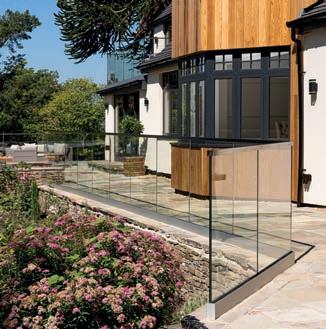
For nearly 40 years, Sovereign Turf has been a trusted leader in premium turf, renowned for unrivalled quality and exceptional customer service. Its turf is grown on the UK’s lightest, sandiest soils to guarantee turf that is lightweight, strong, and consistently high-quality all year-round. This year at FutureScape, it is excited to introduce Xeris, its innovative drought-tolerant turf with roots twice as deep as standard grasses. Designed to excel in water-stressed environments, Xeris is the perfect solution for greener, more resilient landscapes. Visit Sovereign Turf at Stand P64 with Country Supplies to learn more. sovereignturf.co.uk















Director of Outdoor Living Gardens, John Tallis joined the industry at only 15 years old, and has since gone on to establish his own renowned company in the heart of West Yorkshire


With centuries of history, England boasts a vast variety of landscapes, architecture, and opportunities, and garden designers can often face a contrasting selection of projects, ranging from period properties dating back to Victorian, Edwardian, or Tudor times. Clients may choose to modernise their spaces entirely, or maintain the garden in line with the original design. However,

according to John Tallis, this is not a luxury that all four nations get to experience.
Predominately working across Yorkshire, there once was a time when Tallis sought out to explore business opportunities within Wales, to coincide with family across the border, but was met with the realisation of how history and positioning has more of an effect on the Welsh landscapes available than he previously thought.
“We all deal with the same stresses, and that is one thing that unifies everywhere across the four nations,” Tallis comments. “Everyone’s got the same issues their facing – whether that be climate change or finances – we’re all overcoming similar problems and
building towards similar goals.
“I don’t believe that there is a major difference between the workload across the four nations,” says Tallis. “However, when I’ve worked on projects in Wales, what did stand out was the styles and the materials used.”
We’re all overcoming similar problems and building towards similar goals
Being a coastal nation, more so than others, the material and planting choices were completely different to what Tallis was used to when he would design in Yorkshire. Having to think about the effects of coastal erosion on hard landscaping is only one of the additional challenges that the other nations will face more often than England. It is because of the factors such as coastal
impact, that Tallis believes certain areas, within countries like Wales, have been restricted throughout history. Some towns and villages have been unable to change in their architecture and designs as they have been made to outlast the effects of local weather or location, whereas places in England vary more drastically. From similar areas on the coast to those more naturally protected from the weather by steeper landscapes, or vast areas of woodland, for example the North and South downs, creating its own microclimate for the landscape in-between.
The types of landscape therefore, as Tallis mentions, effect everything from the materials used to the planting schemes. Working across England, therefore, Tallis is not necessarily restricted in his work and can explore a wider variety of designs and materials.
Having started his business in September 2022, Outdoor Living Gardens is a design and build business working with two in-house designers, two teams of landscapers and a full-time office team managing behind the scenes. Tallis is comfortable working in new and challenging projects as he covers all aspects of garden design building, from

domestic gardens to working alongside architects and businesses on commercial projects to collaborate on new ideas with a fresh perspective.

yourself to others, but you’ve just got to take every opportunity that comes you’re way. Just the fact that 18 months, we’re still here, that’s what I’m most proud of.”
Having explored new business ventures in the West, Tallis has come to discover that opportunities are often dependent on location, and “inevitably, it comes down to population,” says Tallis.
We should be providing more support with education and finance to those who may not have the ability to travel
“Our dedication to delivering for our clients, the best possible results and experience, starts right from the initial consultation, all the way to the aftercare of your new garden,” says Tallis. “And I’d say my biggest achievement is getting the business to where it is today.
“I think sometimes it’s difficult to take a step back and look at where you actually got to from where you were and be proud of that. It’s easy to compare
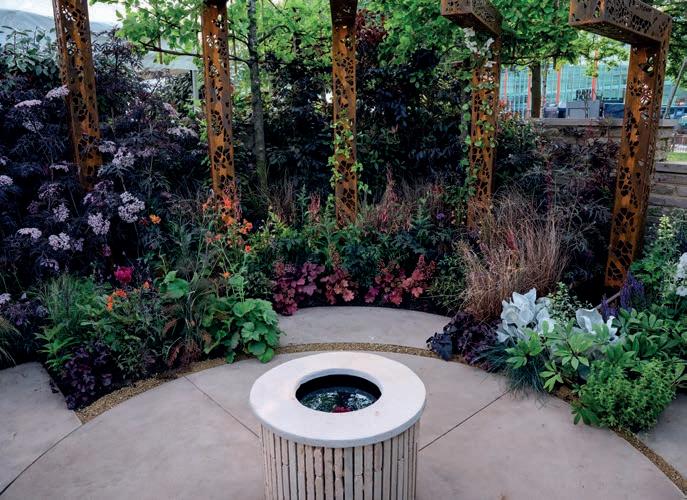
According to government statistics, there are approximately 72 million people across the four nations, with 56 million of those living within England. “And with a higher population, it means that we have more abundance of work and that’s an advantage in itself.”
Combine the volume with the variety of work, and England is seemingly at an advantage compared to the other nations, but Tallis is confident that the country can assist in providing more options and opportunities for its sister nations.

“Just the fact that all of the horticultural shows, awards and events are set up across England, automatically means that the opportunities here are greater,” says Tallis.
For those living and working in England, accessing these events can be as straightforward as jumping in the car and driving a few hours, but for those living across the water in Ireland for example, travel can be incredibly costly and isn’t always doable, especially when you’re just starting out in the industry.
“I think that in the realm nations, it is in our best interest to not segregate them. We should be providing more support with education and finance to those who may not have the ability to travel.”
Horticulture is not an industry that should be limited by convenience, but should be a community set up to aid others with a shared mindset and determination to make a difference to our natural world.
With 56 milllion people living in one nation alone, are there not enough opportunities to be shared and explored?















With a Renson louvered canopy, you enjoy outdoor living all year. The unique combination of design, quality and ultimate comfort. With endless possibilities for personalisation, you create your own unique outdoor room space. Appointment in your garden.












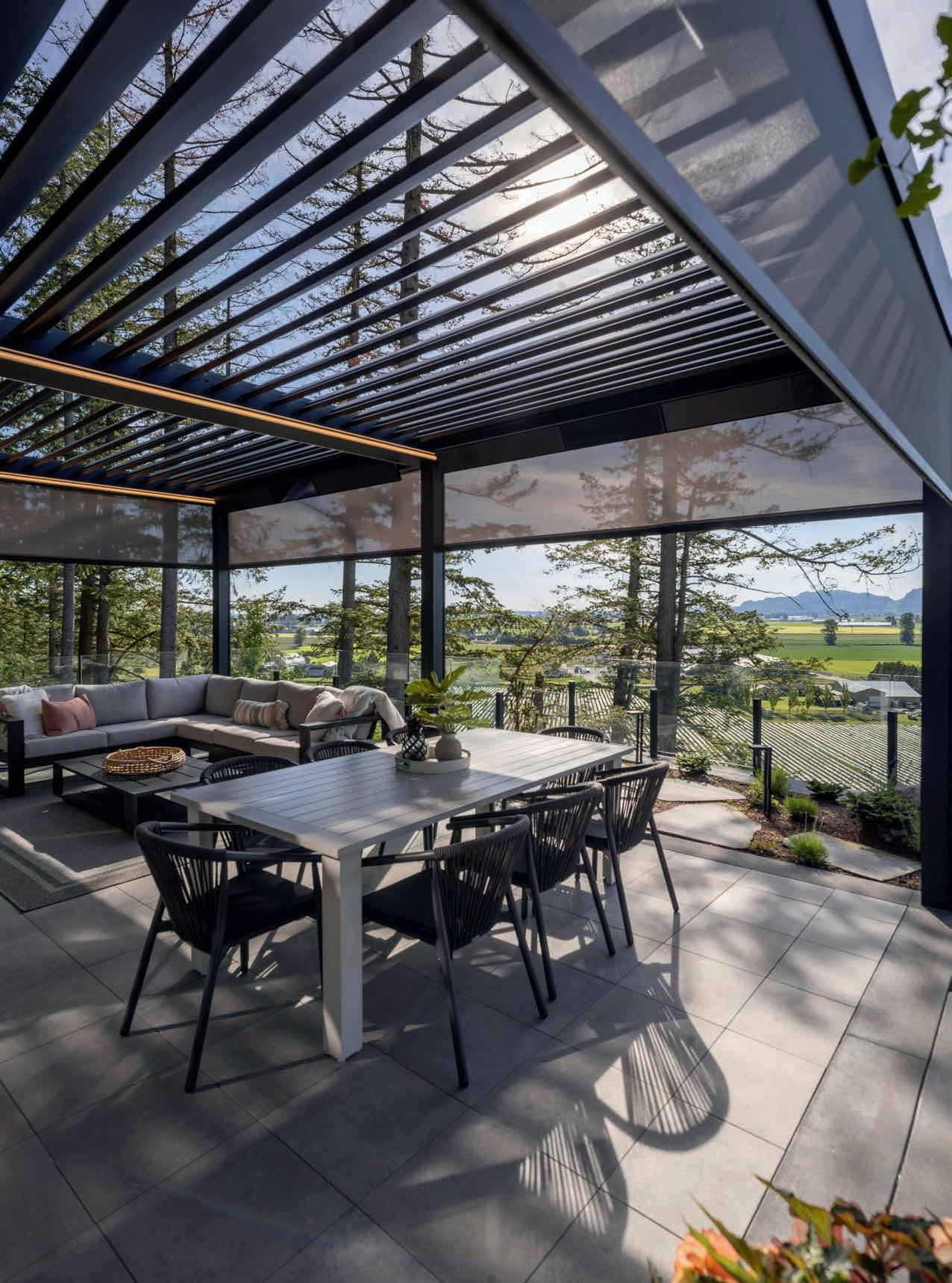

he most northern of the four nations, Scotland is renowned for its diverse range of landscapes. Highlands and lowlands, urban and coastal; together they create the distinctive backdrop of Scottish living.
And having announced its campaign to become the world’s first Rewilding Nation, the Scottish government is set to commit to nature recovery across 30% of the country to benefit nature, climate, and people.
Despite this being a huge step for biodiversity and landscaping, when it comes to domestic landscaping Marc Murray, managing director of Murray Landscapes LTD, would say that Scotland is way behind.
Having many friends scattered throughout the four nations, when it comes to landscaping as a whole, Murray believes that Scotland has less suppliers, less awareness of the industry and much lower budgets available.
“The majority of our supplies are shipped up from England,” says Murray. Whether it’s paving, artificial grass, pergolas, or garden furniture, Murray finds that wait times often exceed three days and can be increasingly expensive when adding on delivery charges – not to mention the negative impact it has on the environment when arctic lorries are driving up and down the country.
Possibly the most naturally challenged nation, in terms of weather and accessibility, yet landscapers, Murray Landscapes LTD, continue to push the limits of possibility

I have had the vision of raising the bar for landscaping in Scotland, which I think we are achieving, and in the future, want to pass on these skills and knowledge to the next generation
“Most of the time, we work with the same suppliers,” says Murray. “Having built a good
and long-lasting relationship, we know who we can trust and rely on for a good service every time.”
According to Murray, the industry is generally more prominent in the south of the UK, with events such as the RHS Chelsea Flower Show and Hampton Court Palace Garden festival taking place, “as well as exhibitions such as Futurescape, taking place further south.”
By building strong relationships with key

personalities within the industry and creating partnerships, conversations can begin about bringing similar events north of the border.
As a result of these challenges that Murray Landscapes has encountered, many changes have had to be made, including some very difficult business decisions, “however these decisions have helped to shape who we are now and who we continue to be in the future,” says Murray.
Murray Landscapes is now a multiaward-winning landscaping company based in Motherwell and operating throughout central Scotland. It specialises in designing and creating modern outdoor living spaces for its high-net-worth clients and professional grounds maintenance services for the public sector local housing associations and B2B.
“Our luxury landscaping projects see us work with some high-profile clients,” says Murray. “Most recently, we have Liam Kelly, Scottish international goalkeeper, and Brendan Rogers, Glasgow Celtic first team coach, among the clients awaiting design work.”

This year has already seen Murray Landscapes secure several small commercial civil and groundwork projects for our regular long-term ground maintenance clients which will see the business venture into a new field, supplying and installing bike shelters, smoking shelters, outside gym equipment, safety barriers, gates, and signage.
Despite the landscaping industry in Scotland becoming overcrowded, according to Murray, he feels as though there is less competition in Scotland as a high quality service provider, compared to England.
“Since Covid, a lot of trades turned its head to landscaping and I’m sure this happened all over the UK. However, it frustrates me when the quality isn’t maintained,” says Murray. “I have had the vision of raising the bar for landscaping in Scotland, which I think we are achieving, and in the future, want to pass on these skills and knowledge to the next generation.”

All are challenges that the Scottish nation aim to overcome on a daily basis, all in favour of its environment.

The main difference between the nations however, according to Murray, is the poor weather conditions.
“Scotland is generally the wettest and the coldest country in the four nation, and this brings its challenges throughout the year and affects several aspects of the business daily –especially efficiency,” says Murray.
We believe that one of our key purposes is to create the next generation of landscapers
According to the Met Office, the wettest parts of the UK are concentrated in mountainous regions with Snowdonia, the Lake District and the Scottish Highlands all receiving more than four metres of rainfall in a year. This naturally causes a plethora of issues for landscapers in these regions as rain can delay work, damage supplies, and effect the growth of establishing planting.
As Murray Landscapes continues to grow, it has taken the opportunity to renew a long-term five-year lease at its premises, which will undergo significant transformation both inside and out, to create the ultimate HQ for the business and its team – complete with an efficiently organised yard, including mini recycling centre, office, design studio, meeting room, and training facility.
Murray Landscapes is on a clear mission to make an impact for the future. “We believe that one of our key purposes is to
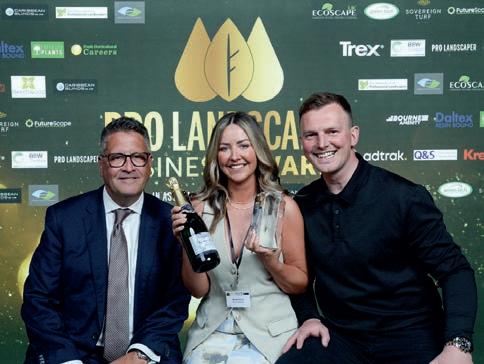


create the next generation of landscapers, and we dedicate funds, time, and expertise to help to make this happen.”
Backed by a growing training budget, Murray Landscapes supports the development of its team through training programmes, on-the-job training, and annual appraisals, where Murray will discuss not only performance but also development needs to enable each team member to thrive.
“All of this builds an enthusiastic, growing nucleus of highly skilled landscapers who enjoy working in this sector and will contribute to the quality of work and service which the sector delivers to its customers,” concludes Murray.

We want to partner with you to create the perfect bespoke garden room for your clients and your design. You can lean on our expertise in construction and installation whilst having the freedom to put your stamp on the look and feel.



With over 40 years of expertise, we can partner with you to create the perfect customised garden building with a 10-year warranty to seamlessly fit into your garden design.
You can decide on the materials, colours, size, and style to create a bespoke garden building that perfectly complements your designs.
‘Bakers have an outstanding commitment to quality and are hugely valued by our team. When specifying an outdoor room for our clients, we feel confident that they will be thoughtfully considered and harmonised into our overall schemes.’

What’s next?
Discover more inspiration for garden designers, landscapers and homeowners.


Grateful for the opportunities he has encountered, garden designer and landscape architect, Peter Donegan, acknowledges some of the challenges Ireland faces with its smaller horticultural market
Ireland may be a country rich in history and culture, but one area where it is still growing is within its modern horticultural and landscaping sectors.
The country’s gardening heritage may date back to its earliest settlers, producing crops for harvest, before the introduction of plants from across the world and the Americas in the 16th century which then progressed to the development of landscape design in the 1700’s – but Ireland’s development within the industry seems to have slowed down in more recent years, according to garden designer, Peter Donegan.

Whilst The Royal Horticultural Society (RHS) was founded back in 1804, with shows and festivals such as the prestigious Chelsea Flower Show being hosted at the Royal Hospital Chelsea since 1913 – Ireland’s experience with such events is lesser known to those outside of the island.



The Royal Horticultural Society of Ireland (RHSI) may have been similarly founded in 1816, and is proudly affiliated with over 90 horticultural, gardening, and floral art societies and clubs, but whereas Chelsea draws in designers and visitors from across the globe, RHSI Bellebield and Russborough are still yet to receive the same level of recognition.
According to the RHSI, the society supposedly began when a meeting was held at the Rose Tavern, Donnybrook, Dublin with a group of estate gardeners who had met to drink beer and to worry about “the art of gardening falling away and rapidly declining.”
Resolving to exchange expertise and new ideas, the Horticultural Society of Ireland was set up for gardeners who had served their time and were “of good moral conduct.”
The RHSI was later distinguished throughout the 19th and early 20th centuries, and it focused on its shows and exhibitions across Ireland. Now, the modern RHSI is a mixture of amateur and professional gardeners who continue to be committed to education within the industry. So how has the industry seemingly since slowed down in Ireland in the 21st century?
Peter Donegan of Peter Donegan Garden Design started his journey into the industry at the age of 17 when he was assisting in the development of rooftop gardens in multistorey carparks across Dublin. Quickly learning how to work at a fast pace with a quality finish, the job had its limitations, so it wasn’t long before Donegan chose to run


away with his creative imagination and start up his own garden design company. Now, he takes on between 20 and 30 different projects every year, with his professional reputation now providing new challenges across Ireland, France, Australia, and the UK.
From 2019 to 2022 Donegan assumed the role of series garden designer for Ireland’s most watched TV show, RTE’s DIY SOS The Big Build, which he remains a frequent feature of to this day.
He was also selected to represent Ireland to design and realise the WW1 Centenary Peace Garden at Château de Péronne in 2018, before returning in 2022 to design second inaugurated garden at the 13th Century castle known as the “Historial de la Grande Guerre” – home to Europe’s largest war museum.

But it was in 2023 that Donegan was taken across the globe, becoming the first Irish landscape architect invited and accepted to design at Melbourne International Flower and Garden Show, the Southern Hemisphere’s largest and most prestigious flower show where he won gold.
Donegan then returned to MIFGS earlier this year as a garden judge, and to design the show’s featured garden, winning The People’s Choice Award. So why is it that Donegan has found himself away from home soil so frequently? “If you take it from a population perspective, it’s all logic,” says Donegan.
“If you’re a designer, landscaper, gardener, or contractor, based in Dublin, there’s a population of about 1.5 million people and a population of just over five million in the whole of Ireland.
The second you’re offered a seat on a rocket ship, don’t ask which seat, just get on
“If Northern Ireland, for example, has a population of 1.5, and then you go to London where it’s nine billion, it’s all about the ratio so it makes more sense to take your business to where the people are.”
Population also puts demand into perspective. Despite both the RHS and RHSI dating back to a similar period, the demand has grown stronger in England

especially, compared to Ireland, both in terms of work and shows. To put this into perspective, the RHSI Bellefield takes place on the two-acre walled garden and parkland, whereas RHS Chelsea is within an eleven-acre showground.
It is understandable as to why industry professionals may prefer to travel further afield to access a wider variety of opportunities rather than settle on home turf and fight competitors for the limited clientele.
And for those just starting out in the industry or looking to transport their skills across the four nations to exploit the opportunities “across the pond,” Donegan has two key pieces of advice: “Never be afraid to reach out – pop an email, pick up the phone and say can I have a chat?
“And then, the second you’re offered a seat on a rocket ship, don’t ask which seat, just get on.”
1 Melbourne International Flower and Garden Show 2023, first-ever Irish Gold
2 Château de Péronne and Peace Garden in a dried up moat
3 A place to eat and converse where the castles columns once fell
4 Martin Semken, Peter Donegan MSGD and Dean Cartwright, Gold medal MiFGS
5 The Corten Grand Piano BBQ and raised planter for DIY SOS for RTE Television
6 The Veterans Garden and People’s Choice Award, Melbourne 2024




Combining style with extreme durability, KönigOutdoor kitchen cabinetry is created using sintered stone external surfaces and an internal weatherproof structure.
Each KönigOutdoor kitchen is made to order in Britain with turnkey advice and support available for you and your client, from design through to aftercare.
www.konigoutdoor.co.uk sales@konigoutdoor.co.uk

Synergy and networking lie at the heart of Inscapes as it has continued to develop its reach and relationships across Wales over the last two decades
An area that covers 20,800 square kilometres, Wales has a varied geography with contrasting flat coastal plains, valleys, and mountain ranges, providing a mixed range of landscaping opportunities across the country.
With three national parks and five areas of outstanding natural beauty, which cover a quarter of the land mass of Wales, the country is also now 90% agriculture, according to statistics from the Welsh government, ranging from crops to livestock.

Born on a farm and trained in agriculture, Gareth Rees now spends the majority of his time running the business and looking for opportunities. These range from sports clubs, stadiums, and golf courses to construction companies, national and local government and councils, and private clients – including large residential properties.
His upbringing instilled a deep understanding and appreciation of the agricultural and horticultural sectors, but his first venture into the world of business, however, was road transport.
“Given my agricultural background, much
of our transport work involved servicing the agricultural and horticultural markets,” says Rees. “We were fortunate to have a substantial yard located very close to the M4 which provided us with excellent logistical advantages.”
It was then around 25 years ago when Inturf, a company specialising in high quality turf, set up a depot in Rees’ yard, and at that time, the quality of its product was unmatched in Wales, so this collaboration marked the beginning of a significant business relationship between the pair.
We were fortunate to have a substantial yard located very close to the M4 which provided us with excellent logistical advantages
“We started transporting turf for Inturf and through this partnership, I developed a strong friendship with the Edwards family, especially Derek Edwards,” says Rees.
In 1998, Inturf was awarded the contract to grow and install the pitch at the Millennium Stadium in Cardiff –this was a new system at the time using pallets but given that it required 200 artic lorries to move the pitch in and out of the stadium, for Rees it was as much a logistical challenge as a horticultural one.
“We worked on this project with Inturf and that’s what set me off in the industry.” As the turf depot sales grew, the focus of the business shifted, and Rees set up Inscapes.
“The partnership with Inturf isn’t just about business; it’s about shared values, friendship, mutual respect, and a commitment to excellence,” says Rees.


Inscapes is now an established sports and commercial landscaping business, which offers services from design to full construction and maintenance. With its nationwide irrigation

installation and drainage specialist services, and arboriculture & hire division embedded in the business, it works from locations in Bridgend, Shrewsbury, Newbury, Virginia Water, and Tring, with its head office in Bridgend also selling turf, soil, barks, and irrigation equipment into the landscape trade.
advancements in marketing technology. Alongside this, another great asset to businesses in Wales has been the Development Bank of Wales. “They have been a great supporter of our growth providing the necessary capital to expand our operations. The support and mentoring the Development Bank provided us was exceptional,” comments Rees.
But it is the extensive road network that Rees says has significantly enhanced his ability to conduct business nationwide.
The advantage of working in South Wales lies significantly in the exceptional transport network
Predominantly based in Wales, Rees mentions how when the business started, it received valuable support and guidance from the Welsh government.
“This assistance was pivotal in enabling us to explore new markets that would have otherwise been beyond our reach,” says Rees.
Additionally, the relationship between the Welsh Government and the Massachusetts Institute of Technology (MIT) in Boston was instrumental for Rees as the partnership allowed him to travel to MIT, where he gained invaluable insights into the latest
“Our strategic proximity to London facilitates our operations in that market, making it easily accessible and manageable for us,” says Rees.
But despite this broader reach, Inscapes’ work in Wales still constitutes approximately 50% of its total turnover, underscoring the importance of its local market.
“The advantage of working in South Wales lies significantly in the exceptional transport network,” says Rees. Access to this robust infrastructure provides numerous benefits for businesses operating in the region.
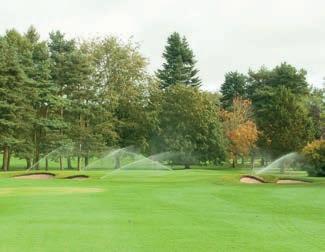
South Wales boasts an extensive network of major roadways, including the M4 motorway, which runs across the southern
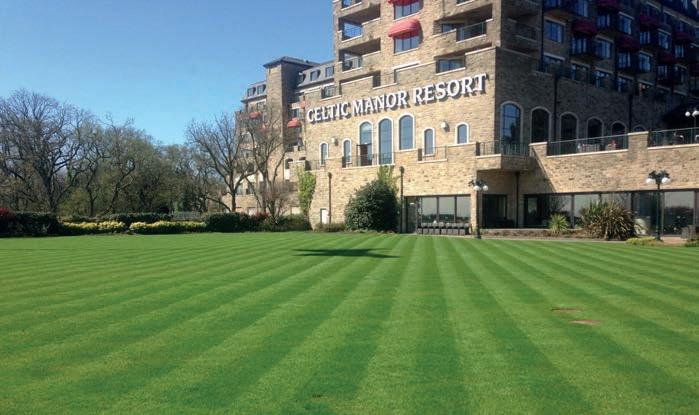

part of the country and connects Inscapes directly to key cities such as Cardiff, Newport, Swansea, as well as London and other major hubs in England. “We also have a well-connected rail network that complements the road system.”
The comprehensive transport network in South Wales not only supports efficient logistics but also attracts businesses and investments to the region, creating a competitive edge by enabling companies to operate with greater flexibility and responsiveness.
With plans to now build a young management team in the hopes that the business could be sold to either the management team or another enterprise, Inscapes is determined to ensure its succession and continue its status across Wales.
1 Parliament Square Gardens lawn installation
2 The Vale Resort renovations
3 Golf course irrigation
4 Inscap es Arboriculture
5 Celtic Manor roof garden renovation





The original all-weather sweep-in jointing compound.






The ease of the EASYJoint with contemporary colours of grout. For natural & porcelain paving.








N2 outdoor collection Dining Set and Lounge Set in light teak.
H1 In & Outdoor Rug in Champagne.
NTHDEGREE_UK
NTHDEGREECLERKENWELL
Nth Degree is a homeware brand with a mission to elevate the standard of luxury outdoor furniture by integrating uncompromising quality and breathtaking design. At Nth Degree we bring indoor living outside with our carefully curated collection of water repellent, versatile and durable furniture and accessories, creating a seamless transition between your garden and living space.




IMPLEMENTATION OF BIODIVERSITY AND ECOLOGY PROMOTION AT MANCHESTER CITY FOOTBALL CLUB
Manchester City Football Club, established in 1880, is a premier league football club based in Manchester, England. Known for its rich history and passionate fanbase, City has achieved significant success, winning multiple Premier League titles, FA Cups, and League Cups, both home at its Etihad Stadium and away.
Hired by the club in 2016 to maintain and enhance the biodiversity and ecology throughout the site as part of ongoing improvements to the estate, idverde has been working with Manchester City Football Club to make the site more attractive and suitable for local wildlife.



Including the maintenance of trees, grass, wildflower meadow, shrub beds and hedging, idverde also chose to complement the evergreen shrub planting it inherited by shifting to native and pollinator rich planting as well as drought tolerant where possible, including varieties of Siberian bugloss (Brunnera macrophylla), Carpet Bugle (Ajuga reptans), and Perennial Cornflower (Centaurea montana).
idverde planted a variety of native grasses, wildflowers, shrubs, and trees, ensuring they were well suited to our local climate and soil conditions, using a combination of native and diverse species. Its planting schedule ensured continuous blooming, supporting various pollinators throughout the year. It introduced pollinator gardens around the facility peripheries too, which now attract bees, butterflies, and other pollinators, enhancing biodiversity. These gardens feature a diverse mix of nectar-rich plants, providing food sources across seasons.
The inclusion of perennial flower beds and buffer zones along pathways and in between pitch areas have also created additional habitats; these areas now thrive with a mix of grasses and wildflowers, fostering a diverse ecosystem.
The reduction of water through drought resistant planting was key to the sustainability of the project as well as the recycling of site materials to improve soil.
idverde tailored its soil amendment strategy based on a series of soil testing and analysis through a soil restoration and health
improvement scheme which identified nutrient deficiencies and pH imbalances. By then enriching the soil with organic matter, including compost and manure, significantly improving soil structure and fertility and by recycling renovated pitch soils, this has meant that less waste material is going to landfill and can be stored and reused onsite to replenish poorly drained and nutrient deprived flower beds.
Mycorrhizal fungi and beneficial microbes were also introduced to boost plant nutrient uptake and improved soil structure. These beneficial microbial inoculants have increased soil biodiversity and health.
The synopsis of its strategy was to implement change. idverde is striving to
transform the landscape to increase biodiversity and promote ecology, while maintaining the professional standards expected in a football environment. This comprehensive initiative not only involved soil restoration, native planting, sustainable management practices, habitat enhancement, community engagement, and continuous monitoring, but operating in a professional football environment, on a very busy site where uniformity had been the norm.
idverde had to work with poor soils in need of restoration, and work with a flexible maintenance and build schedule.
To increase the sustainability of the site, reduced mowing, and no-mow zones were introduced to allow natural growth, providing

habitats for various species. A reduced mowing schedule in non-playing areas has also promoted the establishment of wildflowers and grasses.
Its Integrated Pest Management (IPM) practices have successfully managed pests using eco-friendly methods, reducing reliance on chemical pesticides, and the introduction of beneficial insects and companion planting has naturally deterred pests. It has also enhanced habitat features with installation of bird and bat houses around the facility, which have encouraged these species, again, aiding in natural pest control.
Positioned in quiet, undisturbed areas, these houses have seen high occupancy rates, with 11 Solitary Bee posts also positioned strategically around site where pollinator rich species have been propagated. Similarly, dead wood piles have been placed to provide habitats for insects, reptiles, and small mammals, blending seamlessly into the landscape, maintaining aesthetic appeal.
Small ponds and wetland areas support amphibians, birds, and other wildlife and have been wellmaintained and integrated into the landscape, avoiding waterlogging of pedestrian areas.
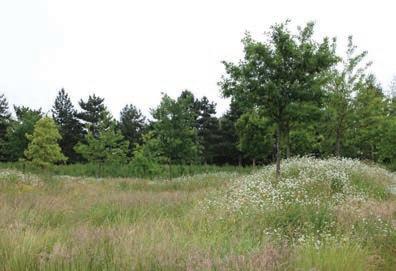
Community and education initiatives were key to the success of this project and its future, and included a series of workshops and seminars for staff, players, and the local community by idverde, to showcase the importance of biodiversity and sustainable practices.
idverde also invited local schools and community groups to actively participate in planting and maintenance activities, preparing the landscape for the future generations.
idverde’s volunteer programmes have similarly seen enthusiastic participation from club and contractor staff, fostering a sense of community ownership, with volunteers assisting with planting, maintenance, and monitoring, ensuring the

sustainability of its initiatives.
With regular monitoring, idverde has been provided with valuable data on soil health, plant growth, and overall biodiversity. All its habitat creation projects are driven by growth and a demonstration of targeted species increase, so this data has informed ongoing adjustments and improvements to our management practices.
idverde stays updated with the latest research and best practices in landscape management and biodiversity, and has a willingness to adapt and evolve practices based on new insights.
The comprehensive implementation of these strategies has significantly increased biodiversity and promoted ecology at Man City. idverde’s commitment to sustainable practices and community involvement has not only enhanced the environmental value of our facilities but also fostered a greater sense of stewardship among staff and the local community.

Proud of the positive impact it has made and remaining dedicated to continuous improvement in its ecological efforts, idverde continues to work to maintain its efforts at the Manchester City Football Club.
ABOUT
idverde is a UK and Europe leading provider of grounds maintenance services and landscape creation projects. idverde offers a holistic range of services to support the creation, maintenance, and management of landscapes throughout the UK. With extensive experience working with both public and private sector clients, it delivers bespoke solutions for each project’s unique challenges. idverde.co.uk

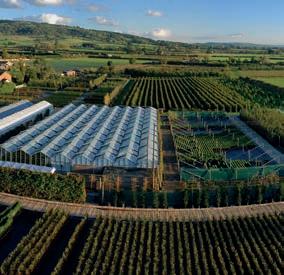
Readyhedge hedging plants, like the mixed native hedging shown here, are container-grown in the UK and fully acclimatised to UK conditions. With over 20 years’ expertise, Readyhedge delivers hedging to rely on, wherever you are.

Project value
€250k
Build time 16 weeks
Size of project 750m2
Awards
Pro Landscaper 2024
Shortlisted Garden Design Company


This project transformed the garden into a functional, aesthetically pleasing space that complemented the architecture and enhanced outdoor living. Designed by Shane Murphy of Lavender Landscapes, it features a blend of natural materials and modern elements for a harmonious area, ideal for relaxation, entertainment, and enjoying nature.
The design and build of this project fulfilled the brief by seamlessly integrating high quality, durable materials like locally sourced Blarney black gravel, black Siberian larch, and Kilkenny limestone to create a cohesive outdoor space.
The project also included construction and installation of a timber cabin and a pergola, placed
COGNITIVE SUSTAINABILITY
to maximise functionality and visual appeal.
Combined with the grid matting and gravel pathways, along with the elegant stepping stones and hand-built limestone step, these connected various garden elements harmoniously.
Groundworks, electrical ducting, meticulous soil, and material repurposing ensured a solid foundation for the intricate design features, such as the decorative water features and limestone steps.
The carefully selected lighting and planting worked to elevate the ambiance. For the soft landscaping and planting, Lavender Landscapes focused on creating a lush, diverse, and visually captivating environment. Using a variety of plant species which were selected to ensure year-round
interest and texture, the key plantings included the graceful Miscanthus sinensis ‘Morning Light’ and the elegant Osmanthus Zelkova serrata pruned multi-stem tree.
Seasonal colour was introduced with Anemones and vibrant Geums, while structure and privacy were provided by three grown Taxus elements.

Bold evergreen structures were placed throughout the garden, ensuring visual interest and strong architectural elements year-round. The project also featured a rich understory of ferns, such as Dryopteris erythrosora, combined with ground covers like Liriope muscari, and Thymus under the pergola. Hidden areas, such as the side of the house and the planting around the pergola, added elements of mystery and discovery.
Strategically placed Hydrangea aspera, Trachelospermum jasminodes and Viburnum opulus ‘Roseum’ added layers of beauty and fragrance, and a “scented hideaway” was enhanced with overhead Trachelospermum jasminodes, sarcococca confusa, sarcococca ruscifolia, and rosemary.
The lighting design highlighted these features, with lights bouncing off the water to create an enchanting atmosphere during the evening hours.
This thoughtful blend of perennials, shrubs, and ornamental grasses, combined with strategic lighting and bold evergreens, create a vibrant and sustainable planting scheme.
Lavender Landscapes ensured that the garden design and build project emphasised sustainability

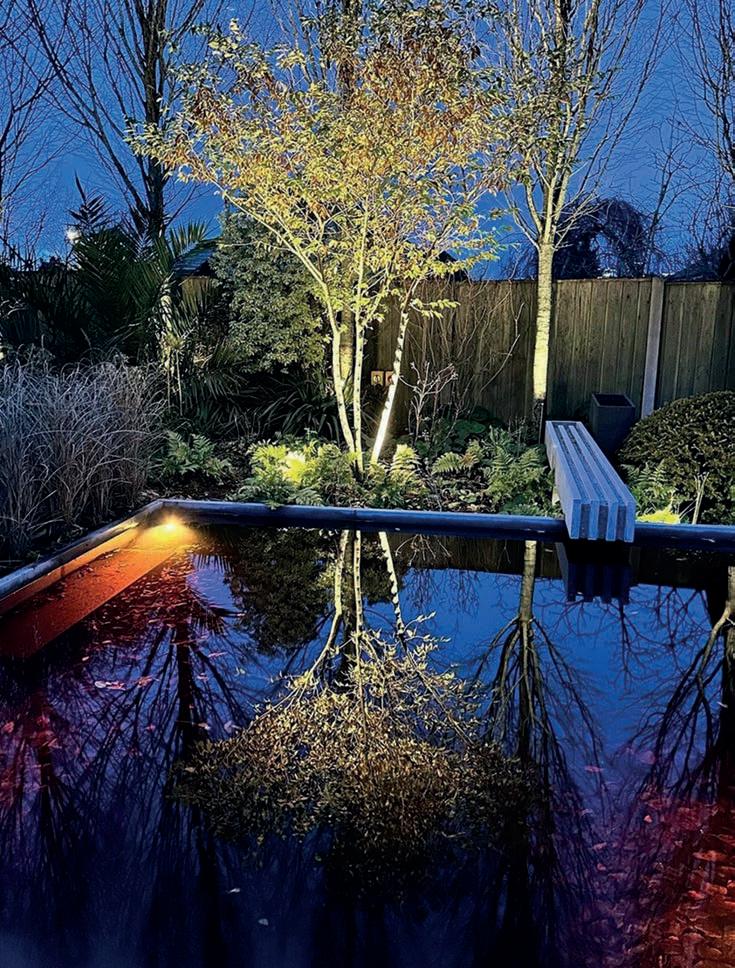
through the use of durable, natural materials and eco-friendly practices. Black Siberian larch and Kilkenny limestone were chosen for its longevity and minimal environmental impact. The project also incorporated efficient waste removal and groundworks processes to reduce landfill use.
Sustainable planting practices included the selection of drought-tolerant species, like the previously mentioned Miscanthus sinensis ‘Morning Light’ and Trachelospermum jasminodes which require less water and maintenance. Additionally, electrical ducting was installed to support energyefficient lighting solutions.
1 A stunning south-facing view of the rear garden
2 Front driveway adorned with vibrant seasonal colours
3 Rodgersia pinnata adds a touch of lush greenery
4 A captivating Kilkenny limestone water feature
5 The locally-sourced Kilkenny limestone paving

A key feature of the garden is the cabin with a living roof. This green roof supports the ecosystem by providing a habitat for various plant and insect species, which aids local biodiversity. It also helps reduce water wastage by absorbing rainwater, thereby minimising runoff and alleviating stormwater management issues. The live roof contributes to better insulation for the cabin, reducing the need for additional heating or cooling and promoting energy efficiency.
Moreover, the project adhered to the zero waste and no soil removal policy set out by Lavender Landscapes, by repurposing existing earth to build up layers and create varying elevations in the garden. This approach not only minimised waste but also ensured that the garden integrated seamlessly with the natural terrain.

Throughout the project, several challenges were encountered and successfully overcome. Plant sourcing proved difficult for some varieties, necessitating the selection of substitutes with similar height, spread and colour to maintain the design’s integrity.
The installation of water features posed typical plumbing challenges, requiring careful planning to account for heavy rainfall, drought, and evaporation, ensuring the features functioned efficiently in varying climate conditions.
Additionally, on-site adjustments to plant placement and quantities were made using
professional experience, ensuring optimal growth and aesthetic appeal. These adaptive strategies and expert decisions allowed the project to be completed seamlessly, meeting both design and environmental requirements.
Overall, the project aimed to create a captivating and harmonious garden environment that evokes intrigue and mystery through a naturalistic and mixed planting scheme. Using a variety of vibrant colours, varied textures and bold, evergreen structures sourced locally ensure year-round beauty and sustainability, complementing robust architecture that seamlessly merges with surrounding buildings.
Lavender Landscapes successfully created a garden that met the client’s needs for relaxation, entertainment, and aesthetic pleasure, with overall views from both the lower and upper levels of the house.
The garden’s inviting pathways and intimate alcoves ensured a seamless flow throughout the space, and the striking water features, with their floating square designs, enhanced the tranquillity of the space too and serve as focal points in the garden. The water features also doubled as a source of fresh water for wildlife.
Lavender Landscapes worked to add elements that would ensure that the garden is not only beautiful and functional, but is also environmentally friendly and minimal aftercare for the clients.
REFERENCES
Plants
NZM Landscape Solutions nzm.ie
Cabin Lugarde Lugarde.com
Lighting
Hex Lighting hexlighting.ie
6 Kilkenny limestone paving creates a stunning entrance 7 A tranquil scene of the softly-lit pergola ABOUT
Lavender Landscapes is a community-loved and distinguished garden design and build company founded by the talented Shane Murphy in 2004. With his award-winning design skills and project management expertise, Murphy has been creating breathtaking outdoor spaces for over 20 years. lavenderlandscapes.ie
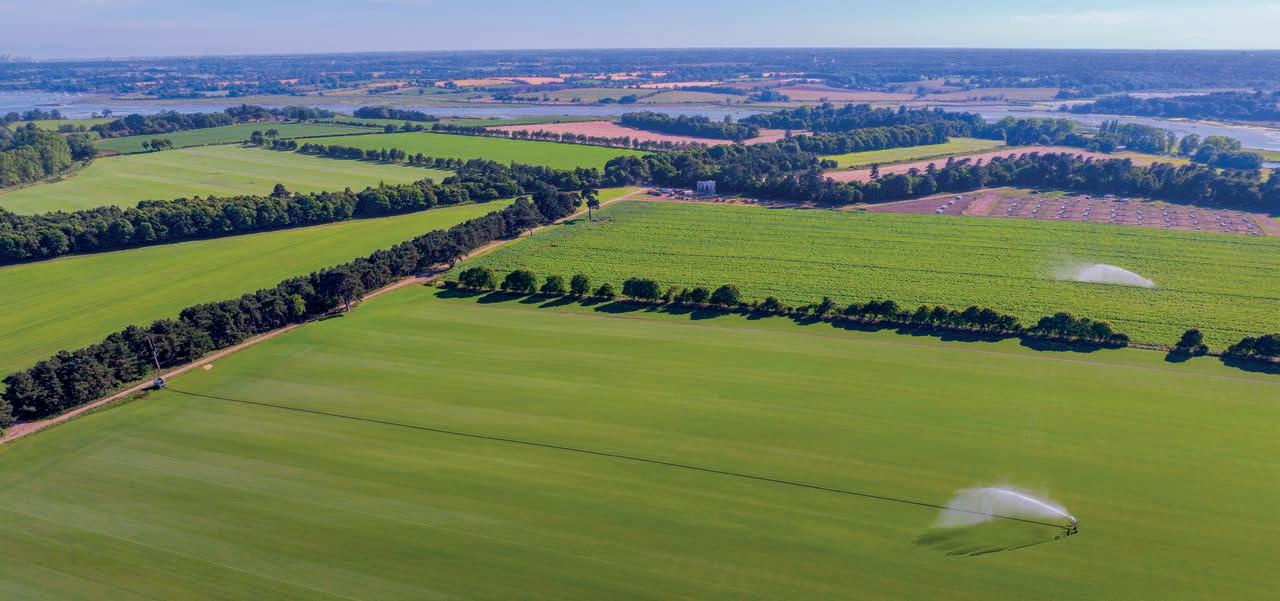



• Recognised for the deepest root growth in the industry
• Increased wear tolerance: ideal for high footfall areas
• Environmentally friendly turf solution: requiring less water, chemicals, and fertiliser once established
• Always plastic free
• Freshly cut and delivered within 24 hours







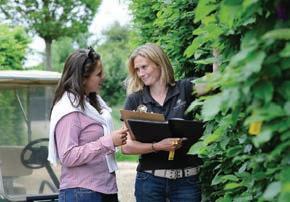



Project value
Over 250k
Build time
6 months
Size of project 1200m2
Awards
Bali National Landscape Award for Domestic Garden Construction over 250k

STEPHEN OGILVIE LTD
EDINBURGH FAMILY GARDEN
Stephen Ogilvie Ltd was commissioned on a design and build basis to create a family garden in the centre of Edinburgh. The garden was large, measuring to approximately 1200m2 and was largely laid to lawn. It sloped gently towards the back before a crumbling stone wall retained a section of un-useable space, densely planted with mature trees, and covered in ivy.
The clients had already made arrangements for a proportion of trees to be removed and a large garden room with a surrounding deck to be constructed within this raised section. For Stephen Ogilvie Ltd, the brief was straightforward and open ended, but the garden building involved numerous building structures and an intricate lighting scheme which extended its ground preparation phase and required
a high level of planning throughout the project.The new garden room was to be positioned in the wooded area at the rear, therefore careful consideration was required to connect this new space to the rest of the garden.
The design was to include a new stone wall, in a similar position to the existing, with steps connecting the garden room to a new seating area.
The design would explore layout options which included large sweeping curves to existing and proposed planting borders, exposed gaps along the boundary to be filled with specimen planting and a greenhouse to be replaced with a pergola structure alongside the new seating area. The curving dry stone walls required bespoke copes each of which was templated in plyboard before being sent to a local stone supplier.
The garden room, new patio and pergola were to be connected to the house by a new path which the Stephen Ogilvie team hoped would provide a sense of journey and encounter.
Paving at the house was to be replaced, with the potential for additional seating and dining spaces and lighting was added to bring additional life throughout the space.The design by Stephen Ogilvie was done in response to a large circular patio, positioned for all day sun, around which Corten steel which would wrap around in tiers to create an amphitheatre of terraced planting.





The soft landscaping makes extensive use of Taxus domes, from 40cm to 1.2m across and which provide a strong sense of cohesion throughout the scheme. The plant selections chosen by Stephen Ogilvie are aligned with the flow and layout of the garden, hedged lined borders and block planting near the property make way to informal, naturalistic and dramatic planting within the Corten terraces of the central patio.
Whilst the steel terracing required complex supports to strengthen each of the seven tiers creating the amphitheatre effect, this technical steelwork was formed and welded onsite with low tolerances so that the curve of each tier was shaped to the required varying supports, pins, and welds to create this durable structure.
These terraces would also integrate gravel steps to connect to the garden room and deck above.
Since the original design, the pergola developed into a glass-clad steel structure, with a louvred roof and integrated kitchen within.

Ogilvie did its upmost to use robust materials throughout the design, which are made to last.
The completed project included two separate dry-stone walls and over 200sqm of paving, Corten steel structures and metal edging. With such a large project, Stephen Ogilvie made sure to make the most of every given opportunity.
A large circular patio, positioned for all day sun, which Corten steel would wrap around in tiers to create an amphitheatre of terraced planting
Stephen Ogilvie added new planting borders to surround this new corner of the garden, creating a sense of enclosure, and a steel-edge gravel path meandered back to the house amongst the new planting.
The initial idea of using weathered steel to create the terraces sparked an interest with the clients which resulted in new Corten elements throughout the garden, including archways, various planters, sculptures, and water features.
Whilst over 50 tons of topsoil was retained onsite and reused wherever possible, the majority of materials were sourced locally and as sustainably as possible, including the use of self-faced Yorkstone paving and Denfind Stone walling. Stephen
Taking advantage of its full array of skills, from welding the metal edging to joinery skills to building the two sheds, Stephen Ogilvie ensured that all work was carried out to a high standard with any issues being corrected immediately.
Happy to accommodate the different options depending on circumstances and or budget, as well as overcoming several challenges throughout, Stephen Ogilvie was proud to create an end product that the client was delighted with.
1 Central patio and feature water table
2 Tiered Corten steelwork
3 Corten arches and cloud pruned pine
4 Looking out from kitchen to sculptural steel firepit
5 Terraced planting & Corten steel steps Photography by Angus Bremner angusbremner.com
Garden room and surrounding deck JML Garden rooms jmlgardenrooms.co.uk
Renson Camargue Renson renson.net/en-gb
Lighting supplier, Landscape Plus landscapeplus.com
Lighting connections and lutron system
RJM Electrical services rjm-electrical.co.uk
Planters and water feature Adezz adezz.com/en-gb
Trees
Urban Trees urbantrees.com/en
Award winning landscape design practice, Stephen Ogilvie Ltd. Based in Edinburgh offering professional garden and landscape design and build across a diverse portfolio of domestic and high-end commercial projects. Working closely with clients to design, build and maintain beautiful and integrated landscapes across the UK.
stephenogilvie.co.uk


Case Study: A genuinely innovative answer to an escalating urban water management challenge by GreenBlue Urban & ARUP
WORDS: ASHLEIGH BROWN
For many older cities and towns, sustainable water management has been steadily rising the agenda for years. Existing ageing infrastructure built for a different era and population, coupled with increased hardscape areas and roads for today’s living means that drainage infrastructure in some areas is at – or above – capacity. Heavy downpours result in the system being overwhelmed, resulting in flooding and associated pollution and damage.
The harsh reality is that options to increase the capacity of existing drainage pipe networks are very expensive and unsuitable in the face of climate change.
What can be done, however, is develop sustainable and resilient SuDS systems that mimic natural drainage, allowing surface run off to be managed as close to the surface and as close to its source as practicable.


‘Greener Grangetown’ does just that, by re-landscaping the urban realm with soft landscape and SuDS interventions.
Greener Grangetown in Cardiff is an interesting example of the successful retro installation of SuDS features into an existing urban streetscape.
The work was commissioned by City of Cardiff Council, Dwr Cymru Welsh Water and Natural Resources Wales and led by Arup. Arup’s water engineers and placemaking team designed solutions that integrated SuDS with public realm improvements, with GreenBlue advising on the tree pit installations, and assisting the GG team from concept through to completion. The Greener Grangetown project is in one of Cardiff’s most densely

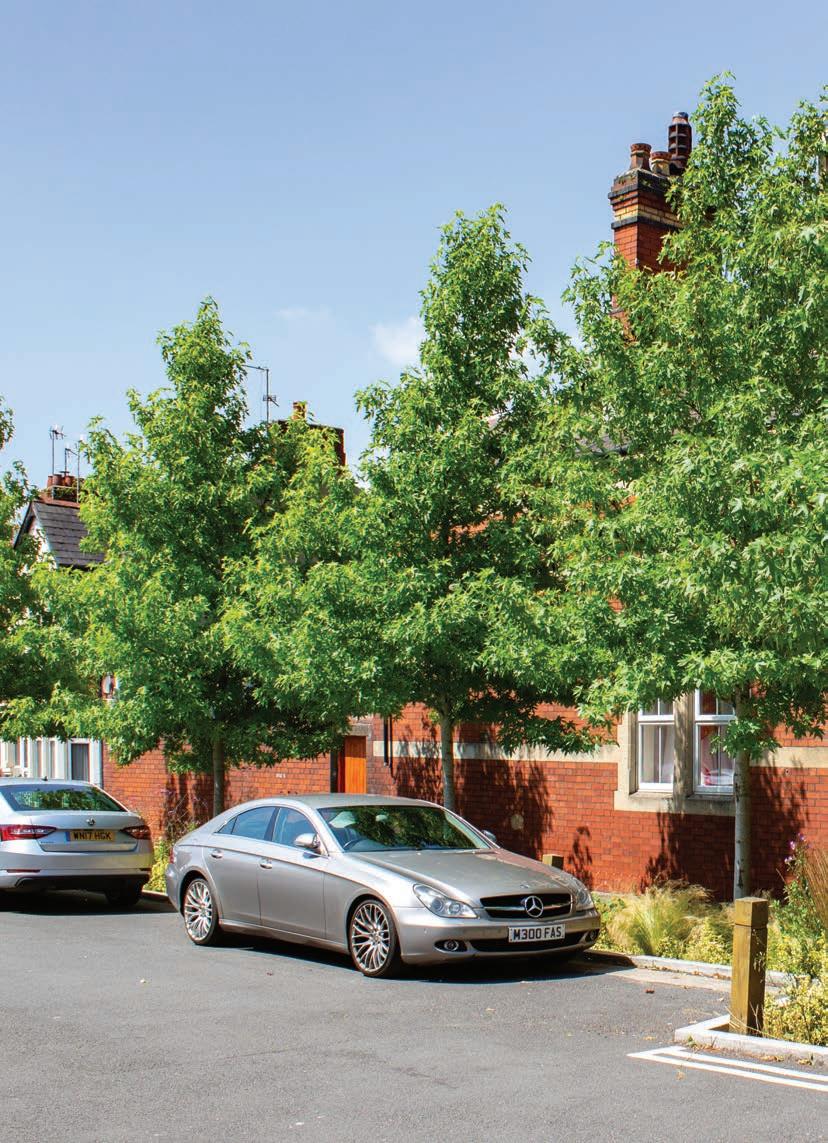
populated wards. The project area runs alongside the infamous River Taff, Wales’ busiest cycle network.
Prior to the commencement of this scheme, the rainwater flowed into the sewer, mixed with wastewater from kitchens and bathrooms, and was pumped around eight miles to the
Vale of Glamorgan, before being treated and released out to sea. By removing this rainwater from the sewer, Dwr Cymru Welsh Water has reduced the energy used for pumping and treating the wastewater. By doing this, they have freed up space in the sewer to help the region adapt to more extreme weather
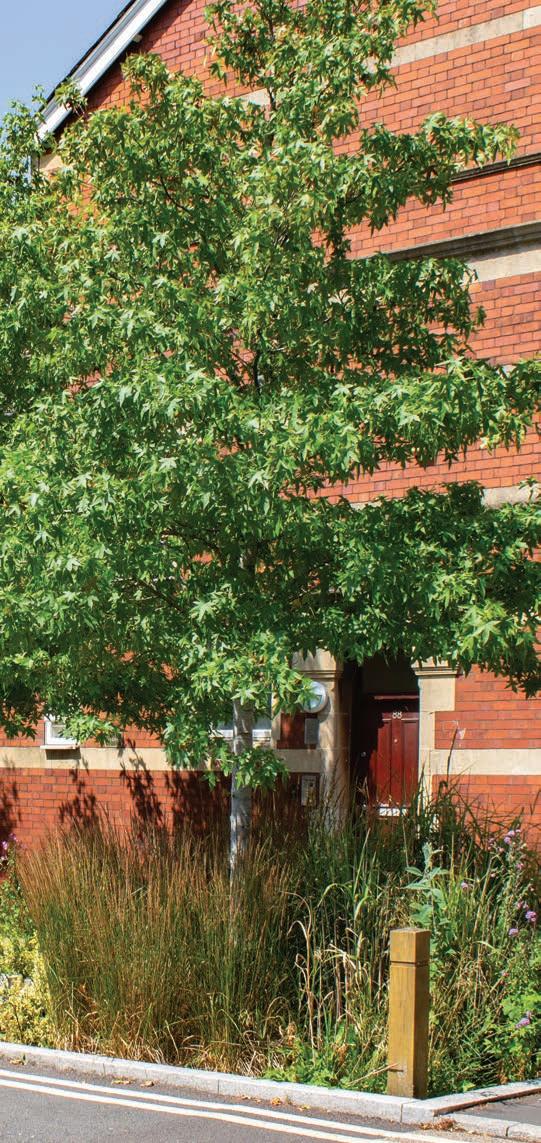
conditions which are caused by climate change.
The Arup design team, working alongside tree officers at the City of Cardiff Council, urban tree and soil science specialists at Natural Resources Wales and GreenBlue Urban Ltd, put a design emphasis on long-term sustainable tree planting for the raingardens and tree pits. Where possible, tree pits were linked below ground, increasing
available soil volume for the trees, and simultaneously increasing water attenuation capacities, a true win-win.

©Arup
Load bearing soil cells from GreenBlue Urban, were used extensively to provide load bearing soil volume and maintain uncompacted aerated soil conditions, perfect for root growth, water attenuation and air supply in the root zone. As well as forming part of the rain garden strategy, the trees and shrubs bring a cohesive identity to the Greener Grangetown area.
The layout, species, shapes and colours of the planting gives each street an individual look throughout the 13 streets. In total, 135 trees have been planted – a total of 19 different species.
The results have been overwhelmingly positive. The multiaward winning scheme was expertly planned and delivered by an hugely enthusiastic team with such a broad spectrum of the physical, ecosystem and social benefits it would bring.
Landscape architect Arup arup.com
Cardiff City Council cardiff.gov.uk
Dwr Cymru Welsh Water dwrcymru.com/en
Natural Resources Wales naturalresources.wales
Installing contractors Gerlad Davies Ltd geralddavies.co.uk
Installing contractors
ERH Communications and Civil Engineering erh.co.uk
Products incorporated into the SuDS Specific raingardens included: GreenBlue Urban’s Soil Cell: StrataCell, ReRoot Root Barrier and ArborGuy Anchor System. greenblue.com/gb
“GreenBlue’s input into the project has been a critical element, in delivering a truly green environment into streets previously largely devoid of such advantages. Working alongside the excellent design team from Arup, they have helped to already transform the street scene and peoples’ perceptions of the area.”
Ian Titherington (Formerly Cardiff Council, now Welsh Government).

Lighting is an important element of garden design, capable of totally transforming outdoor spaces when darkness falls. From highlighting architectural features, to emphasising specific areas of planting and improving safety and security, it is an essential component of any landscaping project.

Implement a variety of lighting techniques
Incorporating a variety of lighting techniques within a garden design creates depth and interest, bringing an outdoor space to life.
Up-lighting, for example – where lights are installed at ground level and light is cast in an upward direction – gives a very dramatic effect and is ideal for highlighting features such as fountains or sculptures and for making trees and foliage stand out. Downlighting, on the other hand, acts like the moon, lighting areas from above it mimics natural light and is great for illuminating doorways, garden beds and patio areas.
Silhouetting is another interesting technique, where lights can be placed behind an object to create a striking effect. This works well with plants that have interesting shapes or structures, adding a touch of artistry to designs.
involves placing lights a short distance away from a wall or fence to create a smooth, even illumination across the surface. It highlights textures and materials, giving a subtle but impactful backdrop. Similarly, grazing sees lights positioned close to the surface they illuminate, accentuating the texture of materials like stone or brick and creating interesting shadows and depth. Mirroring involves placing lights in such a way that they reflect off water surfaces, like ponds or pools, creating beautiful reflections and enhancing the sense of space where as cross-lighting reduces shadows and provides a balanced illumination.
Include smart technology
Other techniques such as wall washing, grazing, cross-lighting and mirroring are also important considerations. Wall washing Antonio Formisano, product manager at 4lite, offers three top tips for achieving the perfect garden lighting design

can be centrally controlled and automated. Every single setting can then be precisely programmed and automated according to the space, its design and use. From the timings of operation to the colour, brightness, intensity and combination of luminaires in use, it allows for an unparalleled level of customisation and control.
It is important that the products selected offer a variety of settings to suit different occasions and preferences
Smart technology is a must in any lighting installation, ensuring better energy efficiency, functionality and delivering heightened aesthetics. Enabling lighting to be controlled, customised and automated to the finest degree, it offers the ideal complement to landscape design.
With wireless technology incorporated into each fitting, luminaires are seamlessly connected, creating a network of lamps that

This automation is also hugely energy efficient as it ensures energy is used only where and when it is needed.
Select products that offer a variety of settings
When darkness falls, lighting plays a huge role in creating mood and ambience and it is important that the products selected offer a variety of settings to suit different occasions and preferences. Smart technology is the number one option for this, delivering customisable lighting options as well as energy optimisation; but if budgets don’t allow, products with dimmable or CCT settings can help to deliver real impact.
By installing lights that can be dimmed to different levels, spaces can be adapted to different needs, whether that’s relaxing on a summer's evening or providing improved visibility for safety and security.
Products that offer adjustable CCT will allow you to change the colour temperature from warm to cool. Warm white lights create a welcoming and intimate atmosphere, perfect for social gatherings whilst cooler white lights provide a more vibrant and energetic feel.



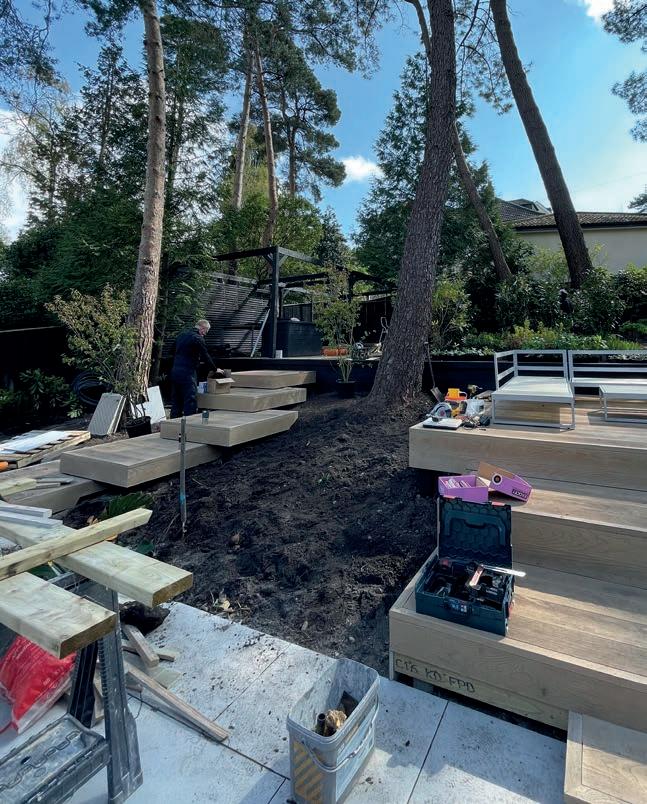
Matt Evans encourages designers to see the opportunities that challenging sloping sites can offer
Asloping site can be a daunting prospect and remove a chunk of a client’s budget before you’ve even started; but approached with care, it can also be a unique opportunity to create drama and structure you’d otherwise lack in a level garden scheme. The beauty of a sloping site is that you have immediate structure to work with. The challenge is managing a client’s expectation of what’s achievable with budget and use of space.
elevation in a less overlooked site is a great way to use a slope, and using a borrowed view from the top of a slope to create a focal point is always a lovely idea
When working with significant level changes, the first thing to note is that if you’re retaining a slope you need to think about loading on the structure and drainage. If in doubt, seek specialist guidance from a structural engineer. This means you can create something that not only looks beautiful, but that will stand the test of time and do the job it’s intended to do.
Retaining walls can look quite utilitarian if left as brickwork or render. There are untold ways to soften a wall – why not plant in front of it to break up the height. Look to interesting materials, stone walling and timber or composite cladding to detail the wall and then bring it to life after dark with lighting. The result can be stunning!
When designing a sloping garden, I always try and think first of where the focal point(s) will be. A steep slope can be quite an imposing feature in a garden, and so there’s always
From a design perspective, we are typically fortunate enough to work from a topographical survey; this gives us a measured drawing to work from on the site providing an accurate plan with existing levels clearly marked. This enables us to calculate everything from retaining wall heights to incremental step changes and reduce dig.


a case for softening and breaking up the elevation with either soft or hardscape elements. Consider using the slope to create elevation or to maximise a borrowed view out of the site. Equally, if the slope runs out of the site into a neighbouring plot, consider how privacy could be affected in your site via the functionality of a neighbour’s land.
Maximising elevation in a less overlooked site is a great way to use a slope, and using a borrowed view from the top of a slope to create a focal point is always a lovely idea. You can then create a journey through the slope to that point with a considered blend of soft and hard landscaping. Paving requires a sub-base and compacted ground, whereas a floating boardwalk on a deck frame can rise above the level change and be designed to work with the topography. This can be particularly useful in areas bound by tree roots and other fixed elements that you need to work around.
Subsoil conditions can often be root bound and free draining, so plant choices should be carefully considered

elevation change; you can then create dramatic elevations for your level area which can be framed with balustrades, handrails and boundaries. This is worth considering, particularly if the site requires building regulations compliance. We always specify a barrier detail on a level change of more 600mm or more. Soft landscaping can be particularly effective on a slope. Subsoil conditions can often be root bound and free draining, so plant choices should be carefully considered. Using trees to naturalise a slope is a nice way to create a less forced and more natural feel. Balance is key, and so ensuring the blend of ground cover, structure and seasonal interest is super important. Retaining walls can cast shadows and create rain shadows for planting, so always consider the aspect before finalising the planting scheme and bolster the area with irrigation should it require it.
solutions. Brands like Straightcurve offer multiple profiles that can retain 400-500mm of level change and make a nice architectural detail of it. Boulders can also be used to great effect to help stabilise and soften small changes in level. This can be a really complementary solution in certain aspects where pairing a local stone with the site creates a project that looks not only considered but seated firmly in the local landscape. Conversely, adding level changes to a relatively level site can create a larger more immersive feeling of space. Regardless of budget restrictions or site constraints, up or down, it doesn’t matter – get creative with levels, and you’ll end up with a more exiting experience for the end user.

Decking part way down a slope can create a place to rest mid-way through the
Small changes in level can be cleverly broken up with simple off-the-shelf
Matt Evans is the managing director and design lead at The Garden Room Living and Landscape Studio, based in Poole, Dorset. The Garden Room is a young, creative design studio founded by partners in life and design, Matt and his wife Elle Evans. Located just a stone’s throw from the shores of Poole Harbour and the Jurassic Coast in Dorset, they operate across Dorset, London and the south of England offering garden design, project management and planting as well as specialist aftercare. thegardenroomstudio.com


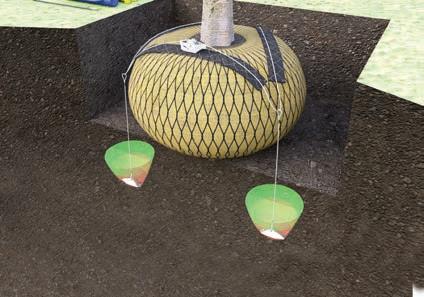


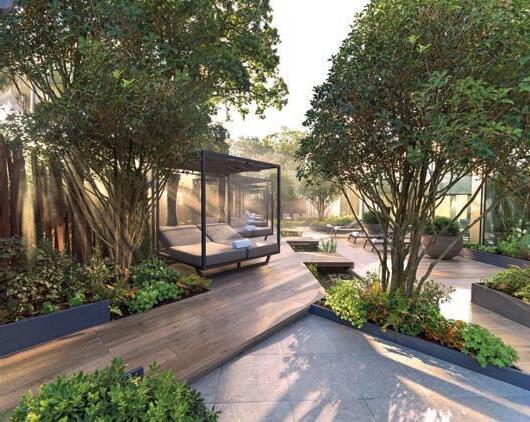









In the face of an escalating climate crisis and ever-growing environmental concerns, the call for expansive tree planting initiatives has become of increasing priority. So, it came as a surprise when planting targets seemingly took a backseat in this year’s government election compared to the bold claims in the 2019 manifestos.
“Throughout the election campaign it was noticeable how little was discussed around the environment,” recalls Adam Dunnet, amenity director at Hillier Nurseries.“It’s pretty concerning how the Labour government seems to have sidelined the environment.” The previous Conservative government established a planting target of 30,000ha of new woodland per year by 2025, a commitment that continues to move forward but has had little acknowledgement in the House of Commons as of late.

Nurseries are stepping up to address the changing demands of tree planting even as government support remains unclear
“The new government really needs to get behind the message of how important tree planting is for our environment,
particularly the focus on increasing the tree canopy cover in our towns and cities.” Dunnet warns that the climate crisis is breathing down the planet’s neck, and says “tree planting is not something the government can throw into the long grass and come back to at a later date – later is too late.”
Tree planting is not something the government can throw into the long grass and come back to at a later date –later is too late
In the wake of tree plantings’ apparent descent from favour, the Labour government has ramped up its housebuilding targets with a promised overhaul of the planning system and a pledge to build 1.5 million new homes over the next parliament, bringing with it mandatory boosts to individual council’s housebuilding. Biodiversity net gain becoming mandatory for developments earlier in the year could be an indirect way of getting more trees into our landscapes.
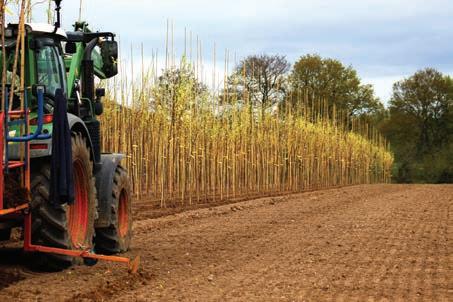

“Biodiversity net gain policy should in theory promote more tree planting in new housing developments and commercial projects”, meaning the two can arguably go hand in hand and tree planting though not the focus can still get a residual incline from housebuilding “but only if it is effectively policed and is not watered down in any future legislation.”
It is safe to say more needs to be done to improve the country’s canopy coverage,
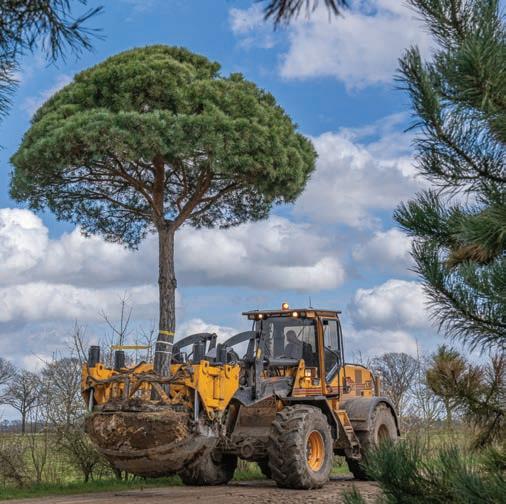
particularly in urban areas; sales manager at Platipus Landscape Solutions Carl Reeders believes a stronger focus on “utilising every available space” is needed to achieve this.“We need more intensive roof gardens where trees are a strong focal point; this would help build up our tree planting numbers and deliver the necessary benefits.”
produce more high-quality trees with less labour input. We speak to a lot of local authority tree officers, and most I would say are fairly positive about street tree planting in the short term, but very uncertain about the medium and longer term,”
Dunnet says that while Hillier’s tree production has risen there remains uncertainty fuelled by a funding shake-up.“Much of the funding for street planting is now based on grant funding rather than direct for local authority budgets, and grant funding can be switched on and off very easily.” He warns that this will lead to a “famine or feast situation for the demand of trees”.

Marko Mouwen of Ebben Tree Nursery believes an informative approach on a community level should be taken,“educate the public about the environmental, economic, and health benefits of trees, and promote local initiatives.” He believes engaging schools, businesses and local organisations in tree-planting activities will be essential to increasing tree planting across the country.
“On a global scale, but certainly also in our own urban environment, trees with their ecosystem services are an answer to the effects of climate change. They contribute to the natural balance in the built environment.”
On a global scale, but certainly also in our own urban environment, trees with their ecosystem services are an answer to the effects of climate change
Despite the lack of updates, the pre-standing targets and looming threat of the climate and biodiversity crisis have prompted companies to increase their own planting productivity, with Hillier being one of them after “significantly increasing its production over the last five years,” Dunnett explains.“We bought over 300 acres of additional land specifically for growing trees and we have expanded our container tree production. Overall our production targets have increased by over 40%. We’re investing in land and infrastructure and finding smarter ways to
Ebben Tree Nursery is another company driving its tree production forward under the banner of tackling climate change.“We envision a future where greenery is not only aesthetic, but also contributes functionally to the wellbeing of people and nature,” explains Mouwen.“We want to reconnect people with nature, to enjoy its characteristic beauty and a sense of connection over several generations.”
Ebben’s approach hinges on fostering environmental stewardship among communities, encouraging a sense of pride and care for an area's greenery is fundamental in ensuring long-term survival of green spaces.
He highlights how the effects of climate change are informing Ebben’s tree growing processes.“By constantly looking closely at nature – how it develops and sustains itself – our know-how to grow also grows. Know-how to grow for us means that we think and look beyond growing and delivering trees. Attention to innovation in colours, textures, shapes and applications is an important principle at our tree nursery.”
With the country’s ecosystem continuously changing as a direct repercussion of the climate crisis, more nurseries are now seeking smarter planting solutions that can withstand fluctuating extreme weather conditions while still meeting the needs of the environments in which they are planted.
So, while tree planting will undoubtedly remain a priority in tackling climate change, the way in which nurseries, local authorities and communities move forward with it will need to continuously evolve, with or without parliamentary assistance.
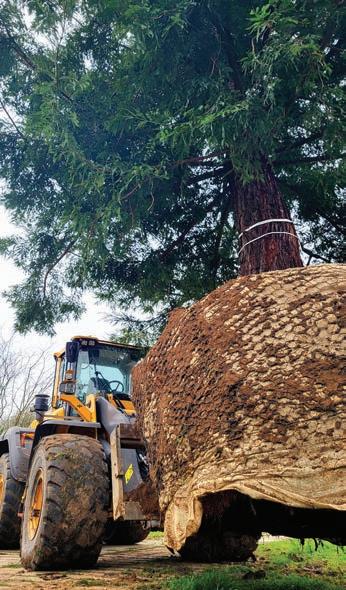
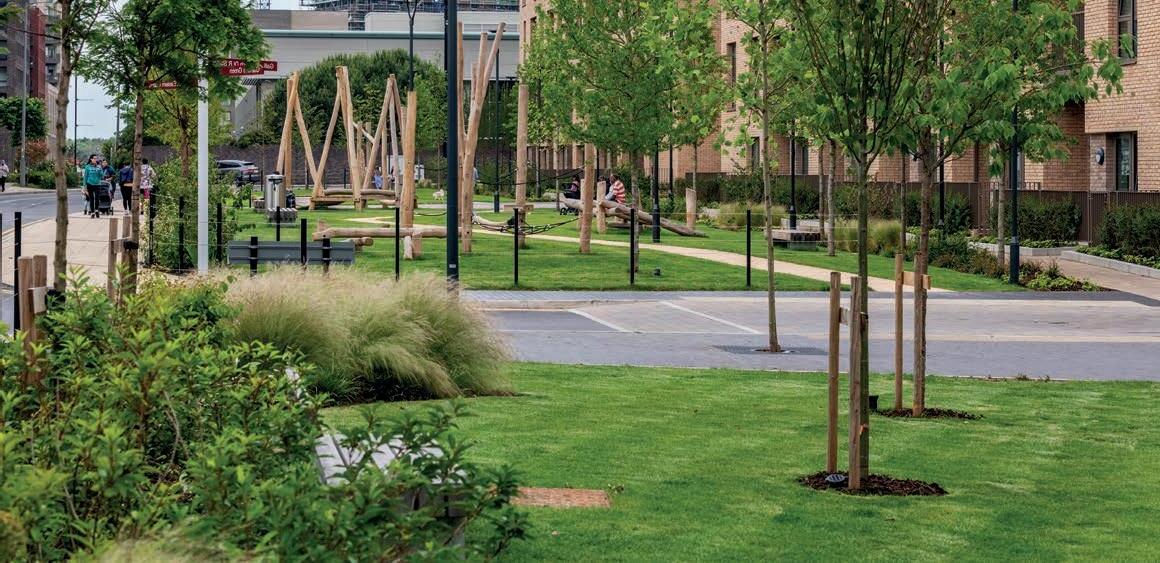


Climate change is putting growers’ resilience to the test –fortunately, Hillier is always striving to be one step ahead
here have been “almost perfect growing conditions” over the last six weeks, says Hillier’s amenity director Adam Dunnett, sounding somewhat relieved. “It has been quite a tough year,” he admits. Last autumn and winter were the worst he can remember.
For five consecutive months, Hillier’s field production site Andlers Ash in Liss, Hampshire, experienced record rainfall since Robert Hillier eagerly purchased the land for its sandy, freedraining soil more than 40 years ago. Up until last November, it hadn’t recorded more than 100mm of rain in a month; it then poured more than 100mm each month until March, with February seeing an unprecedented 175mm. The soggy ground put the nursery two months behind in planting – but the last six weeks have fortunately helped the trees to catch up.
There are around 250,000 trees growing at any one time across its field production and 50,000 container trees
with Myerscough College's Dr Andrew Hirons and Kew Gardens’ Kevin Waters. They have planted different species at Andlers Ash that Hillier doesn’t currently grow but they believe will be good for future climate resilience. For the first three years, at least 50 of each species are being planted each year to ensure that, if successful, Hillier has a commercially viable number to grow on over the next decade or so. After this, they’ll review the range and start to refine it.
What makes it stand out, explains Dunnett, is that it grows trees from seedlings through to being semi-mature trees, some of which have been at the nursery for more than 30 years, whilst many other European nurseries focus solely on one range.
“That’s our point of difference, because we’ve got customers who want the whole range of trees, from small to large.” And when you’re only supplying trees – and not shrubs and herbaceous perennials, for instance – it's important to be able to fulfil
It’s arguably the perfect test for the ‘climate resilient’ range Hillier is trialling
This is one of a few trials Hillier is carrying out to ensure its 160-year legacy continues. It has become one of the largest growers of semi-mature trees in the UK. There are around 250,000 trees growing at any one time across its field production and 50,000 container trees.
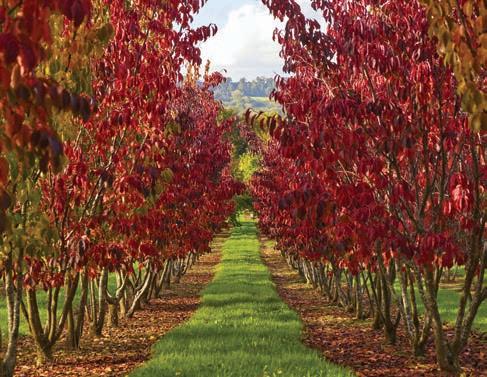

the entire order, says Dunnett. This means that Hillier occasionally has to import. But its focus is on offering British grown. “That’s such an important part of what we do, and we’ve got customers who would not buy from a nursery that is not genuinely producing British grown trees, though there seems to be fewer of those now than a few years ago.”
Other nurseries could grow a tree that size without moving it once and in narrow spacing with less labour involved – but the quality of the tree would be far less.
Transplanting produces more fibrous roots which take up water and nutrients, whereas leaving them produces anchor roots with the fibrous roots moving further away from the tree; so, when the tree is eventually lifted, the fibrous roots are left in the ground.

The “small window” of British grown getting its moment in the spotlight seems to be closing – but those visiting Andlers Ash would no doubt be converts. Hillier is focused on growing trees the “horticulturally correct way”. Take the trees that we’re standing in front of, which have been budded then grown on for three years before being lifted and having their roots trimmed. They’ve then been replanted, grown on for another three years before going through the same process and being replanted in a wider space. Hillier grows these on for another five years in that spacing, pruning the canopy throughout that time. All of this produces a tree that’s 16-18cm in girth.
“Every time you take the tree out the ground and trim the roots, you set the tree back by 12 months, but longer term you get a tree that’s got a much better root system and will establish better in its final landscape.” It also comes down to the soil. “If you’ve got healthy soil, you’ve got healthy trees.” The 16-18cm we’re looking at have been in their spacing for the last three years and will be going on sale this winter, with hopefully around half selling this season, which will create additional spacing for those left and allow in more light for them to increase their canopy. Ideally, the whole field will sell over the next three years, after which there will be a three-year “resting period” – and this is key to the way Hillier grows its trees.
For the first year of this resting period, the field is rented out to a local farmer, who uses it to grow maize. He has a “clever harvesting machine” that goes through the crop and picks off the cobs, leaving behind the plant itself, which is then ploughed
back into the land putting nutrients back into the soil. “It’s impressive, and it’s the only way we will allow a farmer to use our land.”
Every time you take the tree out the ground and trim the roots, you set the tree back by 12 months, but longer term you get a tree that’s got a much better root system and will establish better in its final landscape
Sorghum grass is planted for the second year, which produces organic matter. It’s dense with a “phenomenal” growth rate, shooting up three metres between mid-May and the end of August. When it has been cut and is decomposing, it produces a chemical that destroys nematodes, which can latch onto tree roots, taking water and energy away from the tree and slowing its growth.
In the third and final year, a green compost is added. This “black gold” is produced by several local authorities from household green waste. Some is bagged up for sale in garden centres, but the lower grade is gifted to Hillier, with the nursery just covering the cost of transport to its site.
The focus is then to make sure that the pH of the soil returns to the right levels for growing trees – around 6.5 – as Hillier inflates the pH at the start of the resting period to 7.5 by spreading lime where needed, knowing that it will drop over three years.
All these stages of the resting period are essential, though it does mean that a large

amount of land is unavailable for growing trees for three years. This is where Flexcombe Farm has come in handy. The 200-acre site just down the road from Andlers Ash was purchased three years ago. It was previously a cattle farm which had only grown grass and the occasional maize crop, so the ground was “fresh”, and Hillier has seen “incredible” growth rates – “almost too fast,” says Dunnett. Some are 12 months ahead of those on Andlers Ash, which is “great, but it doesn’t follow the cycle.”
The nursery is also moving Flexcombe Farm onto drip irrigation, something which it recently invested in at Andlers Ash. The more than 700-acre site was on boom irrigation which Hillier had found was “labour intensive and inefficient” thanks to a research project also being run by Dr Andy Hirons, who had received grant funding from the Forestry Commission to look at tree watering regimes. Hillier offered itself for the trials and it’s been a “fascinating three years for us”. The data has allowed Hillier to apply water in a “much more sophisticated way” than it used to, and it will be available to the entire industry after the project comes to an end this year. “We’ve had the advantage of being able to able to learn alongside Andy” and it’s justified the

significant investment – nearly £100k – into switching to drip irrigation.
Peat free “relies more on the skill of the nurseryman to be applying water and feed at the right rates at the right time
Alongside its more recent climate resilient range and watering regime trials, Hillier has also been involved in research for Dutch elm-resistant trees for the last 40 years. It is the only grower of the Resista elm range in the UK, with commercial numbers to sell only in the last 10 years or so, and it’s still building up this number now. The range has become “quite sought after”, appearing more frequently on quotes. As well as being “incredibly disease resistant”, they are also proving to be good for climate resilience.
There are only three varieties at the moment, but Hillier is trialling several cultivars for the breeder based in Germany.
Hillier grows 162 species of trees in total across all its sites, seeing “high demand” for oak trees having become one of few suppliers now that oaks cannot be imported to prevent the spread of oak processionary moth (OPM) in the UK. Despite only being able to sell them in the OPM buffer zone, the trees remain popular, though Hillier only sells to customers purchasing a variety of trees rather than simply oaks.
Poor weather has pushed back a few of its customers’ projects this year, though – Hillier is sending out orders now that were meant to go out in early spring. There’s more uncertainty than last year for the landscape construction side, says Dunnett. And where planning laws are likely to change now that Labour is in power, developers seem to be holding fire too. But this is likely to change when Labour’s housebuilding ambitions start to be met, and Hillier has been increasing its production and sales team to respond to demand.

Around 30 miles down the road from Andlers Ash is its 50-acre container production site in Ampfield, next to the nursery’s head office. There’s another 25 acres of container grown stock a couple of miles

down the road too. Over the last five years or so, Hillier has been building up its 45L stock, from potting around 3,000 a few years ago – with around two years’ worth of stock, so around 6,000 on the ground – to 15,000 this year, so 30,000 on the ground. It’s also been ramping up its production; 93% of the 45L potted this year were homegrown stock, which Dunnett says is a “massive change for us”. It gives Hillier more control over the quality and timeline of what it sells, as opposed to the delays caused by importing.
The 45L stock is grown at Andlers Ash for four to five years until it’s 8-10cm in girth, then it’s lifted in the winter and brought across to Ampfield, where it’s potted in peat-free compost for 12 months and then sellable the following September for the next 18 months. Any longer than that and the root system becomes too coarse, and the establishment rate is reduced, so the trees are chipped to ensure Hillier continues its reputation for quality.
says Dunnett – it makes a grower’s life easier. But peat free “relies more on the skill of the nurseryman to be applying water and feed at the right rates at the right time,” with Hillier finding “little and often Dr Andrew Hirons” to be the best approach. Peat-free mixes are “more complicated to work with when you’ve got extremes with the weather” though, says
Peat-Free Fellowship, for which it’s trialling different mixes from different manufacturers and adding different irrigation regimes to test the reaction. The trial starts in November when it pots new stock, and Hillier will share its findings with the fellowship.

Hillier has been potting in Melcourt’s peat-free compost for around 15 years, carrying out trials throughout this time and learning how to adapt. Peat is “very forgiving”,
Dunnett – even Hillier, with its extensive experience, found this winter the “most challenging in peat free growing”. Fortunately, research into this area has gone “through the roof”, says Dunnett. Hillier is part of the RHS Transition to
It's also running Hiron’s irrigation trial on this site, to a lesser extent, comparing container and field production to inform irrigation zones. The water for its Ampfield site comes from an adjacent housing estate, from which rainwater is collected and pumped into a holding pond. It goes through a filter before being pumped into a ‘settling pond’, where it’s held before going onto the main reservoir. The housing estate is close enough to make this viable, and Hillier has been refining the process over the last 20 years.
It’s yet another way that Hillier is forward-thinking – something which puts it in good stead should this winter be another record breaker. hillier.co.uk

Industry















’S









The class of 2024












Select the ‘Best in Class’ - for Every Paving Project - New & Repointing


GftK Patio Grout by GftK, the best 1-part, air-drying, paving jointing!
‘Best
in Class’

- Unique with big advantages! - EASIER to apply by wet slurry techniques - FASTER because it fully self-compacts into the joints, with no additional finishing or tooling required. - BETTER results with Patio grout: higher & better optimised strengths, with increased resistance, for better durability than any other 1-part material. Suitable for DIY and Professional use.


GftK vdw 400 plus Color, the best cement-based, flowable jointing!
‘Best
in Class’
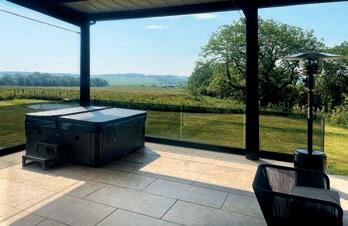
- Very high flow and self-compacting, coloured, polymer-modified cement-based, wet-slurry applied jointing mortar, “with a finish like tile grouting – but work standing-up”. For natural stone & external porcelain, with light to heavy traffic. Fast setting, walkable after a few hours, then achieves high strengths & resistance to frost & de-icing salts. Proven track record >20 years. For Professional use only.
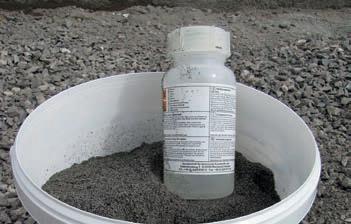
GftK vdw 800, the original and best,1st-Generation, epoxy jointing!

‘Best
in Class’

- The original, 2-part, epoxy-based, paving joint mortar, with pre-coated sand for easy, dust-free use, suitable for trafficked domestic, commercial, and public areas, especially smaller format natural stone paving. Proven track record >40 years. First generation epoxy leaves a colour enhancing sheen on the paving that gradually disappears through natural weathering. Professional use only.


GftK vdw 850 plus, the “State-of-the-Art”, 2-part, epoxy paving jointing!
‘Best in Class’

- The unique, 2nd-generation epoxy, dust-free, fast-curing with no shrinkage cracks, plus a sheen free finish. Can be applied in cold (> 5oC) and wet weather conditions. Easy application as very high flow and self-compacting, resulting in optimum strengths. Fully resistant to traffic, de-icing salts, and jet-washing. Unrivalled and the clear ‘Best-in-Class’ - No more delays + highest performance! GftK vdw 815plus, is a finer grade of the same unique technology, specifically designed for narrow joints from 3mm wide in natural stone and external porcelain tile paving - No more waiting for jointing!
Visit: www.NCCStreetscape.co.uk
Email: sales@NCCinAction.co.uk
Call: 01257 266696


Back in 2015, we realised that more needed to be done to recognise the rising stars in our industry – and hopefully, as a result, to make it more attractive to others too. So, we decided to do something about it. That year, we launched Pro Landscaper’s 30 Under 30: The Next Generation awards, highlighting 30 people aged 30 or under with impressive achievements and ever bolder ambitions. Amongst the inaugural class were some of the most recognisable names in the industry today, including Hugo Bugg and Tom Massey.
The initiative has since, as of this year, celebrated 300 incredible young people from across all sectors of the industry, from garden design to grounds maintenance. Our winners have all had varying ambitions over the years too;

some have strived for an RHS Gold medal, others have worked hard to build their own company, and some are working their way up the ladder. Technology is an increasingly useful catalyst too, it would seem – we have winners this year, for instance, who are growing their reach and therefore their business through video content, and others who are pushing for the development and use of CAD.
What they all seem adamant to do, though, is to make a difference – and we

hope that becoming one of our 30 Under 30 winners has given them a platform to do this. We're incredibly proud to say that the awards are in their tenth year, and we’re looking forward to celebrating this milestone as well as this year’s remarkable winners at the awards ceremony at FutureScape.
We’ll also be celebrating our partner Green-tech, which is marking its 30th anniversary this year and which is recognised not just as a leading supplier in the landscaping industry but also a leading employer.
Thank you for your continued support, and congratulations to the class of 2024!
“Congratulations to all the winners of Pro Landscaper’s 30 Under 30: The Next Generation Awards for 2024. Greentech is proud to sponsor this initiative that celebrates 30 outstanding young professionals who are shaping the future of our industry each year. These awards highlight the diverse and rewarding career opportunities within landscaping, horticulture, arboriculture, and garden design. The 2024 winners exemplify the dedication and passion that drive success in our field. Pro Landscaper continues to provide an unrivalled platform for showcasing your talents and accomplishments, while also inspiring the next generation of industry leaders.


Being named a winner is a remarkable achievement, offering you a unique chance to elevate your profile and advance your career. Congratulations once again on this well-deserved recognition.”
KRIS NELLIST MANAGING DIRECTOR, GREEN-TECH
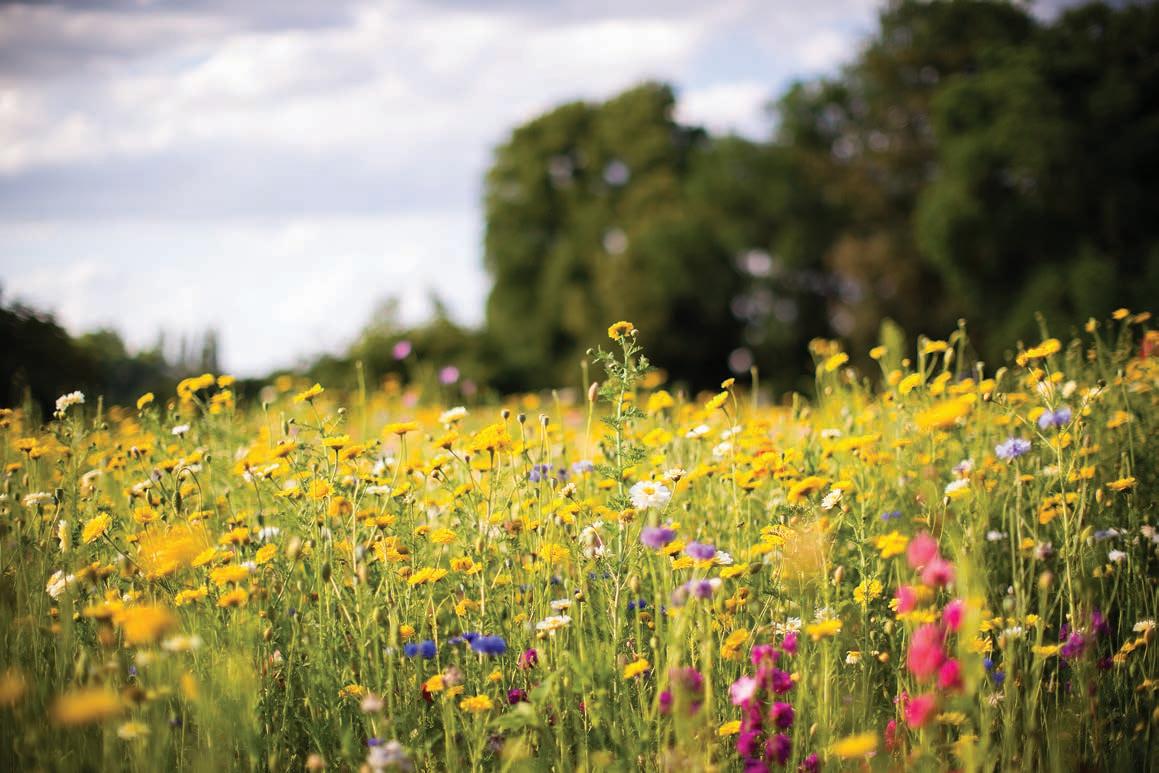






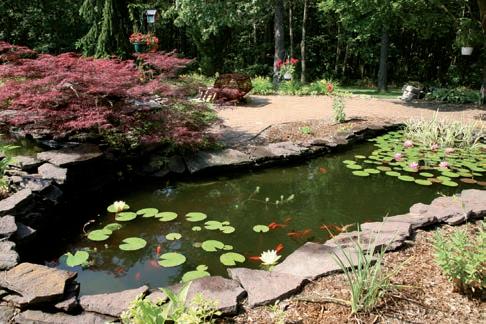








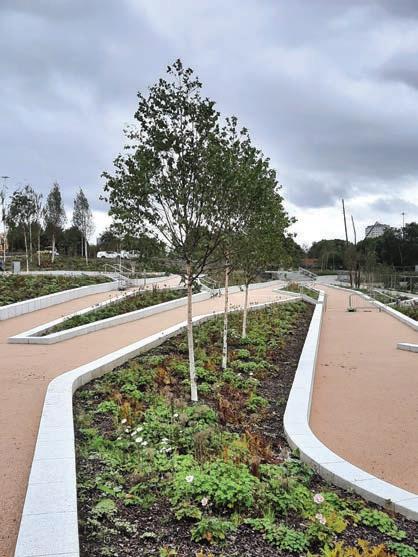

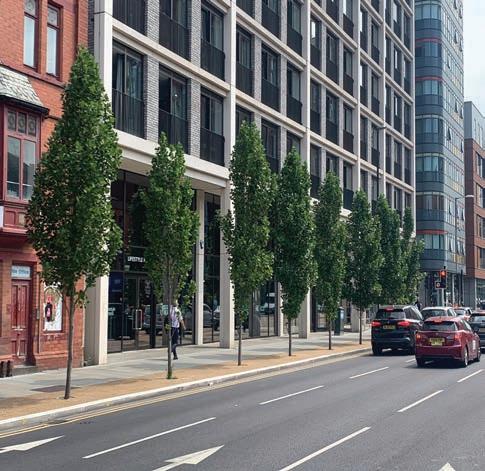


• A trusted supplier to the landscaping, forestry and construction industries for over a quarter of a century
• Over 10,000 product lines with extensive stockholding and a robust supply chain
• Renowned for our professional advice and excellent customer care
• Nationwide, flexible and next day delivery options
• A comprehensive programme of CPD seminars and training seminars


With an aspiration to push the boundaries of garden design, Michael Antonetti’s journey began at 15 when he worked as a hard landscaper at ‘Farmer Will Gardens’.
As he progressed through the ranks, he went on to build award-winning gardens at the RHS Chelsea Flower Show which led him to ponder the challenges associated with designing a garden to show garden calibre. With training in combination arborist tree surgery, a Royal Botanic Garden, Kew Diploma and a Level 3 Professional Gardeners City and Guilds course under his belt, Antonettiis is ready to leave a lasting impression on the horticulture industry.
Presently specialising in high-end public realm designs at Andy Sturgeon Design, Jamie Baker began his journey into landscape architecture in his college years after spending his formative years enamoured by the hybridising of nature, space and concept. After graduating with First Class Honours in Landscape Architecture from the University of Gloucestershire, Baker went on to work at Andy Sturgeon Design for two years before taking a break to pursue a Master’s Degree in Landscape Architecture. Baker is now pursuing a proactive hands-on-approach, building connections and paving the way for a closer connection between landscape architecture and horticulture.


Fueled by his passion for sustainable urban development, Dale Bowie has progressed up the ranks at GreenBlue Urban (GBU) and now oversees the sales team, helping propel them to the next level. Bowie’s work has taken him around the world from America to the Middle East and he has played a role in organising BALI and GBU events nationwide. Under the GBU banner Bowie envisions himself shaping the company’s strategic direction, guiding its corporate values and delivering its missions to create greener and more resilient urban landscapes.

After getting hooked on the constructional components of garden design while working at Urban Earth one summer, Jacob Betts made the switch from video game design to garden design. With his potential evident, Betts went on to complete the Oxford College of Garden Designs Post Graduate Diploma before returning to work for Urban Earth where he now oversees a project's entire design stage. One of Bett’s latest projects was recognised at this year’s BALI awards, after just missing out on a win he is now determined to further his own unique design style that benefits the surrounding environment for the long-run.
After helping his grandfather with a garden project in his youth, Kameron Brindle discovered his passion for landscaping which guided him through his education. At 15 he did work experience at Landeisgns, where he was returned for an apprenticeship course after completing his GCSEs. After the company’s second garden at the RHS Chelsea Flower Show this year, where it built the award-winning World Child Cancer Nurturing Garden, Brindle was promoted to trainee team leader for which he now runs a project’s build process with his team.

22



Completing a First Class Economics and Finance Degree at Reading University and a career Trading in the City left Izaak Butler longing for more. After realising the office life just wasn’t for him he returned to working for Cube 1994, a family business. He has now gone on to build an award-winning show garden at the 2021 RHS Chelsea Flower Shower and recently completed a Level 3 CMI Principles of Management and Leadership diploma to build on his managerial skills. At Cube, Butler leads in-house training schemes providing practical demonstrations to ensure the company’s standard is upheld across all ventures.

Straight after finishing school at 18, Louis Champain started up his own self-employed local gardening service, and before his 20th birthday he had already amassed a small business with a handful of full-time staff. In 2019, Champain was approached by the owner of natural fencing and structure company, Brampton Willows, to take over the company and amalgamate the two. Now, Champain often spends his time bridging the gap between design and build, working with designers and customers to facilitate both business avenues.

SITE ENGINEER, MAYLIM
Driven by a commitment to create spaces that bring people closer to nature, Tom Carter finds value in contributing to the greening of urban spaces. His portfolio includes Exchange Square in London, which won the Grand Award at the 2022 BALI National Landscape Awards. He is aspiring to create green spaces accessible to the younger generation off the back of his own experience in nurturing talent from a young-age. Carter strives to facilitate an environment that encourages growth and exploration, whilst encouraging and providing support which he says is crucial for the advancement of the landscaping industry.
Over the last year, Jake Conway has worked closely with Nicholson’s managing director, Liz Nicholson, to curate the Green Design Audit – a tool to support carbon emission reduction in show garden creation. Straight out of university, Conway delved into work as a hard landscaper at Nicholsons, a far cry from his degree in Mechanical Engineering. He later pursued a two-year master’s degree in quantity surveying and commercial management. The company is now looking to develop its commercial team around Conway’s surveying experience to better-support estimating and surveying functions.
Age 26 Age 27


GARDEN DESIGNER, CALLUM CORRIE GARDEN DESIGN
In the two years since starting up his own company, Callum Corrie has won two RHS Gold medals: the first in 2023 for a long border design at RHS Flower Show Tatton Park, and the next for his ‘Entertaining Meets Nature’ Young Designer Show Garden also at RHS Tatton –the latter also earned him the award for People’s Choice Best Young Designer Garden. Corrie now has his sights set on designing gardens around the world with ambitions to learn how different areas take on design and gardening projects. Age 26

LANDSCAPE MANAGER, JPB LANDSCAPES
After completing a horticultural and landscaping course at Otley College, Matthew Ellis founded his own company with business partner Jack. Now over 10 years later, the two run landscaping and grounds maintenance company JPB Landscapes, working out of Essex, Suffolk and Cambridgeshire. Ellis is now determined to expand the business further into soft landscaping as well as building on his own ecology and plant knowledge in the process.

DIRECTOR, DESIGN ONLY GARDENS Age 31
HEAD OF ARBORICULTURE, TONY BENGER LANDSCAPING
With a passion that extends beyond the workplace, Chris Fry heads up the arboriculture division at Tony Benger Landscaping, guiding its growth and development. Fry found himself up the metaphorical tree of arboriculture after craving a closer connection to nature and subsequently making the transition from the world of culinary arts to arb. From struggling at the hand of external voices throughout his academic journey, Fry has worked hard to amass his current skill set and continues to spread a positive ethos throughout the company.
GARDEN DESIGNER / HARD LANDSCAPER, CHARLES
EDWARD GARDEN DESIGN
After spending his younger years helping his grandparents in the garden and being inspired to transform his own 20 years later during lockdown, it is no surprise Charles Garrick caught the bug for nature.

Garrick’s eyes were opened to the vast world of landscaping when he went to work at Zenscape, where he diversified his portfolio of skills and ultimately prompted him to study landscape design. Armed with a dream to bring people outdoors and find a love for landscapes, Garrick is striving to see the confines of concrete jungles turn green.


Taylor Gee’s journey into garden design began in 2018 when he joined a design and build company situated in Leicester, under which he discovered his passion for the fundamentals of building and the elements of design. In 2023, he went on to found Design Only Gardens, a company that specialises in producing photorealistic visuals and video content for projects to support client company communication, spurred on by his determination to facilitate the delivery of timely and accurate visual designs to clients.
DIRECTOR, HARDWOOD LANDSCAPES
Landscaper turned YouTube director Oliver Gregson didn’t originally plan to stay long in the world of landscapes, but love knows no bounds. Since discovering his passion for landscaping as a means of getting by, Gregson has gone on to become an active member of the APL and has subsequently built several projects across RHS Shows. Most recently, he has taken to sharing his journey online via YouTube, covering everything from the highs and lows of landscaping to industry insights and project fundamentals.


Coming into the industry at a time when it was more heavily male dominated, Tilly Hawkins was determined to excel and become a mentor for fellow women joining the team. Starting out as an estimating assistant and moving her way up to trainee estimator and then to estimator, Hawkins is now working to encourage more women into the world of landscaping as well as promoting the vast range of roles available throughout the industry. Enthralled by the creation of green spaces and their unique properties, Hawkins has thrown herself into the industry boosting her already established skill set.


OPERATIONS MANAGER & DEPUTY HEAD OF PARKS, UNIVERSITY
Taking every opportunity to get stuck into the soil with his grandfather, Paul Hutchinson’s early exposure to the world of horticulture solidified his decision to leave school as early as possible to pursue a Level 3 Extended Diploma in Horticulture. In his current role at the university, he oversees 250 sites, including 14 Oxford Colleges, and is now working to become the youngest superintendent / head of parks within the brand, armed with a dream to have a real lasting effect within the industry.
From honing her skills part-time at a garden centre to meeting their majesties the King and Queen, Anna Mcloughlin’s journey has been a whirlwind thus far. After a stint at Glenarm Castle Walled Garden, Mcloughlin went on to assist in the build for the King’s Coronation Garden and then consequently became the head gardener of the formerly mentioned, as well as the Queen’s Jubilee Garden. After eight months in the position, Mcloughlin transitioned over to her self-proclaimed true passion of landscaping and in 2023, she graduated from her Level 3 in Horticulture from Cafre Greenmount with two distinctions and a distinction star.


After his university closed due to covid, Chester Murch began working at Ellicar’s Southwell pool project, landscaping and pool building before going on to achieve his Chemical Engineering degree two years later at age 21. Throughout his time at the company, Murch has taken the lead on a number of inaugural projects for the brand, including its first pool construction with reinforced stepoc blocks and its first Living Pool project. Playing to his passion for biological water filtration, Murch has also gone on to develop Ellicar’s in-house watering testing methods, allowing for water sampling and efficient maintenance on site.

This year alone, former Young Designer of the Year finalist, Ollie Pike, scooped a hat-trick of awards at the RHS Flower Show Tatton Park.‘This Garden Isn’t Finished Without You’ was awarded a Gold medal. Best Show Garden and the RHS Environmental Innovation Award.
Following Pike’s first RHS Tatton debut in 2023, he went on to found his own business, creating spaces for both private residential dwellings as well as a focus on community green spaces, providing access to nature and its affiliated benefits to everyone.
QUOTED SALES TEAM EXECUTIVE, PROVENDER NURSERIES

James Robson’s introduction into horticulture is a self-admitted stroke of luck after his mother-in-law asked for help renovating her garden. He found himself enthralled by the instant gratification awarded through hard work and being surrounded by nature. Not long after joining Provender Nurseries his eyes were opened to the intricacy of landscaping, unblurring his perception of flora and finding appreciation in it. He now works to foster strong relationships with clients, building trust and personability to ensure a pleasant and fruitful end-to-end experience.
DIRECTOR, SHERRATT GROUP
With a passion and commitment to the industry deeply rooted in her role as a third-generation leader of the family business, Shona Saxon’s dedication is fueled by legacy and a desire to build on the foundations already in place. Saxon continues to use her platform to promote health and wellbeing, reaching out in support of those who feel unable to express themselves. At the helm of Sherratt Group, Saxon strives to leave her mark on the industry, defined by her commitment to best practices that prioritise employees, clients, sustainability & wellbeing.

DESIGNER, GARDENER AND FOUNDER, ROYALL NATURAL LANDSCAPES
Edward Royall’s early volunteer work with The Conservation Volunteers and The Dalston Curve Garden, to name a few, introduced him to the importance of the natural environment in an urban setting. After a stint working for Hackney Council in its ground maintenance division, Royall moved on to work for awardwinning garden designer Harry Holding, to carry out maintenance and builds which featured on at the RHS Chelsea Flower Show and Grand Designs. Now at his own company, Royall employs emerging horticulturists, taking an active role in their development through the funding of courses in heritage crafts to encourage creative outlets.



SITE ENGINEER, MAYLIM LIMITED
With a civil engineer and an architect in the family, Lucas Scofield’s interest in construction began at a young age. Schofield’s first project at Maylim was phase two of the Regents Place project, where his passion was ignited and his appreciation widened for the communal benefits afforded in landscaping. Currently, he is working on a project located in Canary Wharf which will see three large roof terraces installed, a plan that he admits is a great challenge. Moving forward, Schofield aspires to expand his skill set while still delivering higherquality landscaping projects throughout London.
LANDSCAPE ARCHITECT, AS DESIGN
A passion ignited by sheer accident, Aleksandra Slubowska found herself at the start of her journey into landscape architecture while studying interior design. Now four years later, Slubowska is still enamoured by the depth and variety of her role, working across a broad scope of projects and addressing the unique needs of each. She strives to advocate for the importance of landscape architecture, bringing to attention the importance of green spaces and landscaping in the fight after biodiversity loss and climate change.



After leaving school at 16, Kyle Sweet underwent a two-year apprenticeship in building maintenance at Ashley Down City of Bristol College. He later stayed on at the company for a further two years learning the fundamentals of landscaping and construction. Now as a team leader at Artisan Landscapes, Sweet oversees the delivery of end-to-end garden transformations, as well as fostering new talent joining the company, all inspired by his own experience with bad working practices after which he became determined to do better and build gardens that do not compromise on quality.
After a rocky start into the industry, Daniel Taylor’s journey began at Greenfingers Group where he quickly progressed through the ranks before entering his current role after Tivoli acquired Greenfingers. He is now responsible for the smooth running of the company’s Barnsley depot, managing customer communications and the management of six to seven teams at a time. Despite his start in the industry, Taylor now describes his career in it as a non-negotiable, taking every obstacle in his path and converting it into formidable knowledge that powers his drive to continue pushing himself every upwards.


Uninspired by the traditional school system, Cameron Trend found inspiration in horticulture, a decision that still inspires him today. After much work, Trend pivoted into garden design where he was able to transform his garden business into a landscape practice. Over the last three years, Trend has been involved in the design and project management of over 80 gardens, overseeing the completion of more than half of them. Now, he aspires to create an educational green space open to the public that offers interactive gardening advice in a bid to encourage environmental stewardship.

Since joining Green-tech in 2017, James Webster has progressed from the operations and warehouse department to sales advisor and then to account manager last year. Now responsible for overseeing 50 landscapers, foresters and landowners, Webster has excelled in building connections and strong client relations, helping bring their projects to life. As a self-proclaimed ambassador for everything landscape, Webster is proud to represent the Green-tech brand, relying on his wealth of knowledge and charisma to do so.
Equipped with a passion for the natural landscape and perceived general responsibility to conserve and restore the natural environment, Joseph Charry manages the Welwyn Hatfield Borough Council’s owned woodland and nature reserves. Prior to his employment with the council, Charry graduated from the University of East Anglia with a BSc degree in Ecology and Conservation management (land-based sciences). Earlier this year, he took on the additional responsibility of becoming the council's acting ecological consultant, where he reviews small site development applications and associated merits in relation to biodiversity net gain.

A more holistic approach to training – fostering skill diversification allows professionals to tackle a variety of problems.
MICHAEL ANTONETTI

Welcoming and embracing modern tools and technologies can draw in a different range of people who are more interested in the technology side of things.
ANNA MCLOUGHLIN
The jump from graduation to the professional world was substantial. To help mitigate this, a proposal that helps integrate industry placements into university modules; it would only require one to two weeks to get the feel of the position.
JAMIE BAKER
Raising awareness about mental health issues in the landscaping industry is not just important, it's crucial.
TOM CARTER
Having more opportunities for younger people in things like the RHS flower shows. Tatton is the only one that offers for young designers.
CALLUM CORRIE
Licensing and monitoring are without a doubt the most important things to be implemented.
OLIVER GREGSON
There should be more awards available for both companies and individuals...this would be a huge positive within the industry as more would receive recognition and praise.
KAMERON BRINDLE
More bespoke apprenticeships/courses, not just for garden design but also construction, to help fill the skills for all the varied roles of the job rather than the standard route of learning a single trade.
JACOB BETTS
Arb needs more industry representation and media spotlight; it gets very little and is often a bit of an unknown industry that people either know someone in or fall into by chance.
CHRIS FRY
Incorporating sustainable practices is essential. By utilising eco-friendly materials and techniques, we can create breathtaking landscapes while minimising our impact on the environment.
CAMERON TREND
Better support and more guidance for prospective and current business owners.
JOSEPH WILSON CHARRY
Increased earning potential; in landscaping, the ceiling can feel quite low when compared with other trades and career paths.
LOUIS CHAMPAIN
More support for technical product research of unusual technical materials.
CHESTER MURCH
A bigger push to recognise the landscape professionals in the north of England.
Putting landscape professionals in positions where they have more power and can manage the projects... this industry deserves to be more involved in the decision making.
ALEKSANDRA SLUBOWSKA
Increasing access to CAD (Computer-Aided Design) training. CAD is invaluable for creating precise designs and managing complex landscaping projects.
TAYLOR GEE
Increase the visibility of women in construction by focusing on the roles they are doing, how they got into their role, and the impact they have.
TILLY
HAWKINS
Better focus on team health and wellbeing; it’s a physically demanding career and there is little support for physical health beyond health and safety arrangements.
KYLE SWEET



The impacts of climate change are clear and widespread, particularly affecting vulnerable populations. As the crisis intensifies, governments must act now to plan and adapt.
Blue-green infrastructure (BGI) offers numerous benefits –economic, social, cultural, and environmental – making it essential for our communities. Effective long-term BGI implementation relies on collaborative design and planning.
GreenBlue Urban manufactures products from 100% recycled material and has extensive experience in planning climate change adaptation strategies using nature-based solutions. As the leading global
solutions provider, GreenBlue Urban bridges nature and the built environment. Established in 1992 with over 40 years of landscaping expertise, we excel in designing and installing green and blue infrastructure.
Headquartered in East Sussex, England, and a member of the Made in Britain affiliation, GreenBlue Urban resonates as the UK market leader with a commitment to quality and sustainability. Our ArborSystem® products, made from 100% recycled
materials, support the circular economy and reduce our carbon footprint by ensuring high quality and short lead times.
Britain offers a skilled workforce, advanced technology, and a stable business environment

GreenBlue Urban shares its dedication to producing many of its products in Britain

Why choose UK manufacturing? Britain offers a skilled workforce, advanced technology, and a stable business environment. British-made products are known for their quality, safety, and sustainability.
However, manufacturing in Britain faces challenges such as high wages, energy, and raw
material costs, infrastructure issues, and the impacts of Brexit. Despite these, GreenBlue Urban maintains strong stock levels and supports customers in creating healthier urban spaces in harmony with nature.
Due to the company's high quality innovation, GreenBlue Urban's RootSpace system has been nominated for the Pro Landscaper Sustainability and Biodiversity Awards this year in the Sustainable Product of the Year – Hard Landscaping category. greenblue.com


As the CEO of Made in Britain since 2015, I've witnessed firsthand the transformative power of Environmental, Social, and Governance (ESG) principles on the British manufacturing sector in recent years. I’ve also seen remarkable innovation and commitment from UK manufacturing firms to sustainable products and practices.
Our trade association, which brings together more than 2,020 British manufacturing firms by the licensed use of the official Made in Britain collective trademark, has a thriving community of members in the landscaping sector, including dozens of new members that have joined over the past year, from Livingreen, which manufactures fibreglass landscape products including planters, furniture and water features, to outdoor shading manufacturer Retractable Awnings.
The nature of manufacturing – with its large energy requirements, reliance on raw materials and its historically high production of waste – means that the sector faces a particularly challenging path to doing business sustainably, while ensuring profitability at the same time. Made in Britain supports members in this area and also celebrates their achievements via our annual Impact Awards.
At the 2023 Impact Awards, announced in November, Synergy Grill was highly commended in our Green Growth category.

“Synergy impresses because of its clear focus on environmental sustainability throughout the entire life cycle of the product. The company does this by not only tackling several of the most critical environmental issues – air, water, energy and food wastage – of grills and griddles, but also by considering assembly and supply chain implications,” said the judging panel.
UK manufacturers are embracing the necessity of finding balance between sustainability and profitability. I see further evidence of this in the regular new sign-ups to the Made in Britain Green Growth programme – our pioneering environmental initiative devised in alignment with the UN Sustainable Development Goals (SDG).
The Green Growth programme – developed exclusively for the UK manufacturing sector by the Cambridge Judge Business School in collaboration with Made in Britain – provides businesses with clarity over their current activities, so they can identify where and how to improve, followed by tools and resources to advance their sustainable business practices.
More than 100 Made in Britain members have joined the programme, with landscaping among the manufacturing sub-sectors with the most sign-ups.
One such


company is Suffolk-based Caribbean Blinds, which specialises in the design, manufacture and installation of outdoor shading systems that include patio awnings, external blinds and its award-winning louvred roof canopy, the Outdoor Living Pod.
"Through the Made in Britain Green Growth Programme, we have joined a cohort of more sustainably resilient and competitive businesses in becoming more efficient, achieving better growth and keeping up with changing regulations. Our membership has opened doors to new opportunities, whilst allowing us to benefit from an enhanced reputation amongst our customers and other stakeholders,” says managing director of Caribbean Blinds, Stuart Dantzic.
Critics often argue that embracing ESG principles entails higher costs and lower profitability. However, the reality is quite the opposite over the long term – and possibly much sooner, as Footprint Tools recently found out.
Footprint is a British hand tool manufacturer with a heritage of manufacturing in the UK dating back to the 1760s. Before signing up to the Green Growth programme,“We needed to pay more attention to green issues and we weren’t thinking about it enough. We had blind spots that we knew nothing about in relation to the environmental impact of our business,” mentions Footprint Tools director, Timothy Jewitt.
Our membership has opened doors to new opportunities, whilst allowing us to benefit from an enhanced reputation amongst our customers and other stakeholders
Stuart Dantzic, managing director, Caribbean Blinds,
“The environment is now discussed at every investment decision –simple questions, such as ‘Will this reduce energy consumption?’ and ‘Is there a more environmentally friendly option?’ Interestingly, there are financial benefits. By asking ourselves these questions, we have made several investments to reduce our carbon footprint – and the sums add up financially with a healthy ROI,” Jewitt continues. Participation in the Green Growth programme is available to all members of Made in Britain – in the landscaping sector and across the UK manufacturing sector as a whole.

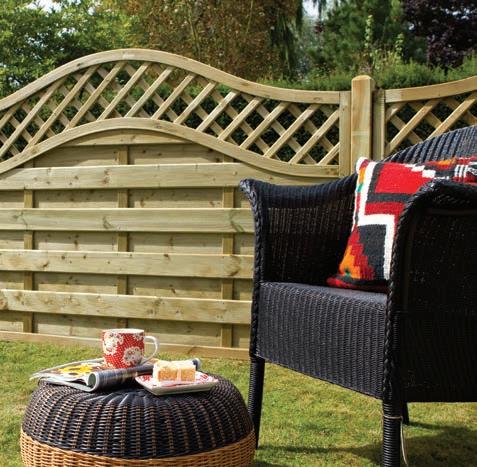






As well as manufacturing products as locally as possible, these Made in Britain members are making a wealth of other strides towards lowering their carbon footprint
Iwish there were more British designed and manufactured products for the garden,” says garden designer David Keegan.
“One of the biggest problems is trying to locate these products – we need an umbrella.”
That umbrella fortunately already exists across most industries. Made in Britain is a trademark that brings together those manufacturing on home soil, including companies in the landscaping sector. For Keegan, the benefits of using these products are vast – from a clear chain of accountability to a high standard of quality, but also from a sustainability perspective.
Made in Britain member GreenBlue Urban, for instance, owns its own manufacturing facility in East Sussex, using 100% recycled materials sourced from within the UK. “By producing most products onsite and domestically, GreenBlue Urban reduces its carbon footprint via shorter supply chains and lower transportation emissions,” says head of marketing, Louise Page.
“Operating within the UK ensures compliance with stringent environmental regulations, fostering high sustainability standards. This strategy also supports local economies and communities by generating jobs and fostering economic growth.”

GreenBlue Urban is undergoing a gradual Life Cycle Assessment for its products, having successfully completed one for its core product RootSpace™ with a pending Environmental Product Declaration (EPDs). It has implemented a closed-loop system where scraps generated during production are recycled onsite and reintegrated into the manufacturing process, reducing waste and minimising environmental impact.
Fellow member Marshalls plc is also publishing EPDs and puts materials back in the cycle wherever possible, says its group head of sustainability, Mike Edwards. “We reuse 100% of the wet clay used in our concrete production processes at our Marley roofing sites and our pallets are reused, refurbished and recycled. We also actively try to reduce our
use of mains water at our sites by utilising harvested rainwater from our roofs, captured waste process water, natural lagoon water, and boreholes whenever possible.”
It recycles and reuses all product samples that it tests at its central laboratory within the same grounds, and all its concrete products are recyclable.“We’re ambitious with our sustainability strategy not only because it’s the right thing to do but because it’s a commitment we make to our customers to play our part and to meet their growing requirement for more sustainable products and suppliers,” says Edwards.

“Overall, though, it just makes good business sense with many of these sustainability activities also having the potential to benefit us as a business. Reducing our consumption of waste, water, packaging and energy will not only lower our carbon footprint, but obviously, it will also reduce our costs as well.”
It makes business sense for products to be Made in Britain too. Edwards says consumers have been paying attention to where their purchases come from and how their products are made in recent years. Keegan, for instance, says his first choice is to use British designed and manufactured products – and he’d like to see more. “If we can show that there is an interest and a demand, hopefully it will mean that more and more products for use in the garden are then manufactured in the UK.”
Based on tonnage, 95% of Marshalls’ landscaping, roofing and building products combined are British made, says Edwards.“By manufacturing most of our products in sites across Britain, we’re keeping fuel emissions to a minimum whilst delivering to customers more quickly. We can keep a close eye on working practices and quality standards.” In other words, manufacturing in Britain is a win-win: for business and the environment.











These products are manufactured right here in Britain by quality-focused brands

Bioclimatic pergolas are revolutionising outdoor spaces, and when they’re made in Britain, the advantages are clear. Designed specifically for the unpredictable British weather, Morvelle pergolas offer durability and adaptability. From frequent downpours to rare heatwaves, British-made bioclimatic pergolas are engineered to handle it all. Moreover, opting for a UK-manufactured pergola means significantly shorter lead times. With Morvelle’s production facilities located domestically, there's no need to worry about long shipping delays or international supply chain disruptions.
Landscapers and architects can contact Morvelle for expert advice quickly and easily, all in the English language. This eliminates misunderstandings and provides confidence that any issue can be swiftly resolved, ensuring the highest standards of service and satisfaction. morvelle.com
BSW TIMBER
IRO TIMBER
IRO Timber is manufactured by the UK’s largest timber business, BSW Timber. A unique range of charred timber cladding products, IRO is not just Made in Britain, but in fact grown in Britain too – as the timber is taken from sustainably sourced, certified British woodlands.
A natural product with three unique colourways, IRO – which is Japanese for ‘colour’ – is inspired by the ancient Japanese process of Yakisugi, which involves charring timber to protect it from the elements. Crafting IRO means charring the timber, brushing out the earlywood and coating it in a unique wood cream, which combines to create a stunning product with an enhanced grain finish. A natural product with endless applications, IRO is suited to a wide array of environments. bsw.co.uk



GreenBlue Urban acts as the interface between nature and the built environment. Established in 1992, with over 30 years of experience, GreenBlue is a global leader, providing expertise and solutions in the planning, design, and installation of green and blue infrastructure.
With headquarters in East Sussex, GreenBlue fully owns its on-site manufacturing facility, and is a member of the Made in Britain affiliation. Gaining the trusted mark seemed fitting as the principal UK manufacturer of said products.
Customers can rest assured that ArborSystem® products are of the highest quality, made from 100% recycled and recyclable materials, and always in stock for shorter lead times – supporting the circular economy and reducing carbon footprints. Being a Made in Britain affiliate is more than just products; it is a way of thinking and a lifestyle. greenblue.com/gb

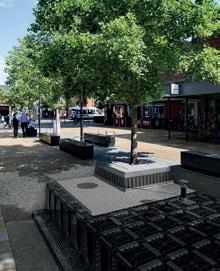





KönigOutdoor manufactures outdoor kitchen cabinetry to the very highest specification, with external surfaces made from Sintered Stone, chosen for its extreme durability, high-end finish and minimal maintenance.
Each kitchen is made to order at the KönigOutdoor workshop in Northamptonshire. The internal cabinetry is made using a weather-proof composite board, cut to size and painted for a durable wipe clean finish. The sintered stone external surfaces are then fabricated from a large slab to create the end panels, worktops and door fronts.
The finishing touches are adding the cladding, fixing on doors and drawers, then inserting the appliances ready for a quality control inspection before being packed up and prepared for installation. konigoutdoor.co.uk






At BSW Timber, we take pride in offering the widest range of responsibly sourced timber products in the UK. With innovation as our driving force, we constantly bring the latest developments to market, ensuring we always have the perfect solution for your needs. Experience the excellence of British timber for all your landscaping endeavours. Our top-quality fencing and landscaping timbers are ideal for all applications. Craft your dream garden with our meticulously finished timber components and turn your vision into reality.
bsw.co.uk

BSW Group diversifies into other areas within the supply chain and forestry services, reinforcing its extensive list of home grown and British manufactured produce

Whether it’s producing more raw materials, the products themselves or offering services, there is a lot of good work that goes on in the country that Made in Britain helps to showcase, including that behind the scenes at BSW Group.
It started as a traditional sawmill business that over the last 10 years has spread and diversified over all areas within the supply chain. It provides a large variety of landscaping products from fence boards, posts and rails to deck boards and timber railway sleepers. The process to create these products spans over decades, though. "It goes from the tree nursery, into a forest which grows over 35 to 40 years and is harvested in this country, manufactured into a product and then sold in Britain,” says James Brennan, head of marketing.“The process is a pretty powerful message to be sold against.”
With BSW officially becoming Made in Britain certified in February 2023, Brennan wanted to do more to promote the fact that BSW is a supply chain, controlled pretty much entirely within one country.


Having acquired the likes of a tree nursery, harvesting business, and further manufacturing businesses, BSW went from being a sole member to a more fully integrated timber and forestry business, and a member of the largest timber processor in Europe, Binderholz. “As a business now, we turn over around £900m annually and have about 3,000 employees and that's mostly here in the UK,” says Brennan.
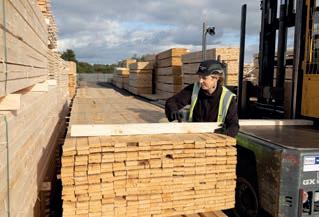
selling the product and identifying as a great product,” says Brennan.
It’s a great initiative to draw attention to what we can do within this country
James Brennan, head of marketing, BSW GROUP
The majority of BSW operations take place within Great Britain, and at least 90% of its products are certified as Made in Britain – in actual fact, they are not just made but also grown in Britain too.
“With something like timber especially, I don't think you tend to think of where that product has come from. So, anything we could do to promote the fact that it was made in Britain would really help us in
Having seen the Made in Britain mark and being familiar with it, Brennan applied online within just 20 minutes. “You may think that there will be hundreds of steps to go through and it will take months, when in actual fact it was a really easy, straightforward process. They got back to us pretty quickly, verified a few details about the business and within a matter of days we had the accreditation. So, I would say to anyone who is considering it, just take a look and go for it,” says Brennan. “It’s a great initiative to draw attention to what we can do within this country.”
Continuing to raise awareness for home made products, BSW is proud to be Made in Britain certified and works to encourage its community to follow in its footsteps.





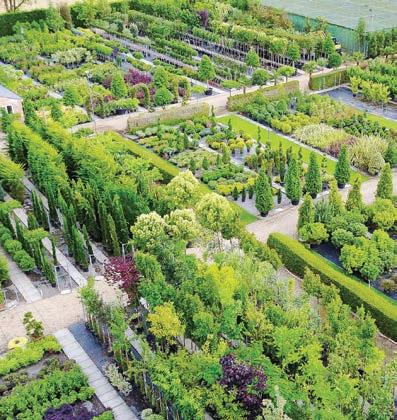



Events such as Chelsea took the media by storm earlier this year, and BBC2’s Your Garden Made Perfect has taken a fresh approach to showcasing what the industry can do. So, is garden design getting its moment on the small screen ? And how accurate is its portrayal?
Garden design might not be new to those already working in the landscaping industry, but those on the outside are arguably just learning about the profession and what it entails. Gardening programmes in the past have perhaps made the process look easy – and cheap. But this appears to be changing, with new programmes hitting our television screens which show exactly what goes into bringing a client brief to life, and why it’s worth paying for.
“The reality is you cannot design and build a garden in £5k,” says garden designer Manoj Malde, who features on BBC2’s Your Garden Made Perfect. “If design, plants, materials and labour are provided for free, how is this realistic?”
With this kind of budget, the workmanship also needs to be questioned. “This was why, when I was approached for Your Garden Made Perfect, the first thing I asked the producers is, are they going to be honest and are the budgets realistic,”

When designing gardens for TV, like with domestic gardens, the designer still has to create a masterplan, setting out plan, planting plan and lighting plan, complete with 3D sketches, explains Malde.
When I was approached for Your Garden Made Perfect, the first thing I asked the producers is, are they going to be honest and are the budgets realistic
Manoj Malde
says Malde. “Only then did I agree to be part of the programme.”
Having always been interested in gardening and looking for a career change from working in the fashion industry, Malde felt that he had the transferrable skills to study and practice garden design. His husband had already started his own business maintaining gardens too.
Now an award-winning garden designer, Malde also works as a TV and radio presenter, as well as being an accomplished author after publishing his first book earlier this year. He has appeared in series such as Your Garden Made Perfect, Garden of the Year and Secrets of the Royal Gardens.
“These then go to the VR company with as much information and images as possible so they can start developing the VR presentation,” says Malde, referring to the process for Your Garden Made Perfect, which uses VR to showcase the design to the client.“At this stage, there is a lot of back and forth between the VR company and the designer but, ultimately, the designer guides the development of the VR.” The timescale for designing the garden is dictated by the filming schedule, though – and these can be tight deadlines.“The design work is done within a maximum of five days. The VR then takes longer,” says Malde. Although the development of the design work is not captured on camera, the site visit and consultation with clients are, as well as a visit to an inspirational garden and the presentation of the VR design to the clients.
Garden designer Lucy Willcox recently appeared as the garden design expert on new show Alan Titchmarsh’s Garden Club, after being contacted by Titchmarsh and his team.
On the show, Willcox was able to feature two gardens she had designed, one being a courtyard garden, providing tips on how to design small spaces, and the other feature was on her own garden,


giving a guide on how to design larger spaces by creating zones.
“It was an absolute privilege to be part of this programme. The producers pulled together a great team of experts and presenters to highlight the different aspects of gardening and to showcase some great community projects.
“When the programmes are considerately produced and thoroughly executed, it highlights the skill of top designers and landscapers, especially when they provide realistic budgets – then it's hugely beneficial to the industry. It can be greatly informative for the public on the entire process and expected costs.”
for taking on landscapes that nobody else wanted to tackle that eventually led to his first TV appearance.
As a child, Donegan was drawn to planting – even though the Yellow Pages had less than a page for garden designers and the listed gardener was a man with a beard wearing a woolly jumper in a potting shed, he says.
When the programmes are considerately produced and thoroughly executed, it highlights the skill of top designers and landscapers, especially when they provide realistic budgets
Lucy Willcox
Willcox had been producing television commercials before joining the industry back in 2005 after an “epiphany moment” in her own garden. Since then, her studio has come into fruition, offering a complete garden design service; from initial consultation to design, implementation, and beyond.
“I have been incredibly lucky to have had some brilliant clients who gave me a free reign on the design and trusted my judgement, which meant I’ve been able to produce a great variety of design schemes,” says Willcox.
In 2012, Willcox returned to the world of TV, having met Alan Titchmarsh when he was filming one of Willcox’s gardens as an inspirational space for the ITV show Love Your Garden.
“We had some great conversations and discussed what a difference gardens and horticulture can make to people's lives,” says Willcox.
“Soon after he asked me to present a section on Britain’s Best Back Gardens about my own garden; on how to design family friendly gardens without giving the garden over to the kids!”
For garden designer Peter Donegan, it was his reputation

Nevertheless, he grew up studying horticulture, and aged 17 was one of a few qualified horticulturists doing work experience and managing the construction of rooftop gardens on top of a multi-story car park.
His practice, Peter Donegan Garden Design, was officially launched in 2001, offering garden design and landscape architecture to those across the public and private sectors. He started to pick up work, and not just in Ireland.
“As I remember it, this particular garden I designed was about 30ft below street level in an old dried-up moat as part of a 13th century castle in Northern France,” says Donegan. “It had just been inaugurated when I realised that I was one of 14 designers selected globally to create these show garden builds and this, combined with my redesign of a 17th century 27-acre estate, led to a radio interview where one producer phoned another and eventually, I got the call.” From there, Donegan went on to feature in a series of
programmes including The Brennan Brothers, The Afternoon Show and most recently DIY SOS The Big Build Ireland, as the series’ garden designer.
Although, as Malde highlighted, not much of the design process makes it into the final cut, the process for Donegan follows the same steps as in his day-to-day work: making sure to design for the client, designing to complement the architecture, and making sure to really visualise the space when drawing.
“Timelines restrictions and budgets invariably decide what happens or doesn’t happen in any project and a good designer and landscape architect should be able to see past all of that so what is drawn can actually be built within those constraints,” says Donegan.
A little like show gardens, designing for TV is an opportunity where something good is bound to come from it – you just don't know what or when, says Donegan. And inevitably, using modern platforms such as TV is what inspires the next generation or horticulturists and designers.
Timelines, restrictions and budgets invariably decide what happens or doesn’t happen in any project and a good designer and landscape architect should be able to see past all of that
Peter Donegan
Currently in the middle of recording alongside contractors Maylim, Donegan is once again making the impossible, possible; working on the rear garden of a 150-year-old Victorian house where the access is under the house. All in all, television presents a great way for businesses and industry professionals to raise their profile. For the garden design sector in particular, it presents another platform for reaching potential clients and showing exactly what they can do and how the end result is really achieved.




Manufactured from durable aluminium grade 6005A, AluExcel is recognised as the highest quality and strongest proven aluminium edge in the market.
AluExcel won’t rust, is lightweight and built to last. It is fast to install and perfect for creating a sleek, defined look to your landscape.
10 different heights

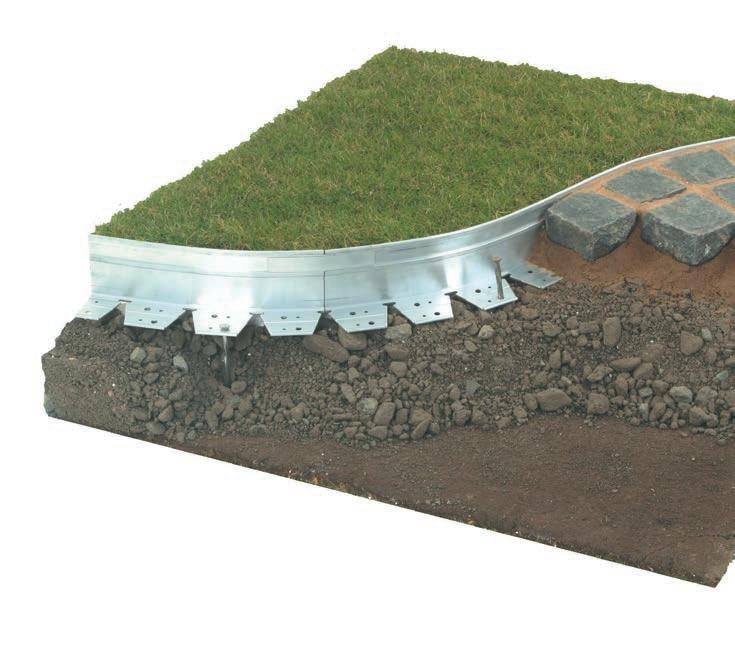
Sustainably sourced, guaranteed quality, exceptional design.

Ecoscape UK is a manufacturer of long lasting, low maintenance timber alternatives. We boast the largest collection of wood plastic composites on the market and aim to be at the forefront of the industry through innovation and continually developing products of the highest standard. Contact us today or visit our stand at Futurescape to speak to our team of composite experts.


Paving failures are often jointing related
One of the most common reasons for the failure and dissatisfaction with paved areas of all types is inadequate paving jointing. This may be due to the wrong type of materials being used for the type and area of paving, or the wrong weather and site conditions when it was applied – the latter being the most common, as nowadays most manufacturers do not make bad products, but the market understanding of the limitations for different materials technologies is unfortunately much lower than it should be. There are also several myths and a tendency to follow a ‘one size fits all’ approach, which is a big mistake.
Avoiding paving failures
To avoid joint breakdown and premature failure, successful new paving and paving refurbishment work must include qualified assessment of the key project requirements, followed by selection of the right paving jointing technology and products. There are big variations in different materials technologies between their application limitations, technical performance, and hence their durability.

The key paving jointing criteria
These should include review of the type and size of the paving elements, the substructure build-up and permeability, the proposed joint dimensions and variation, the type of paved area, the anticipated
traffic and exposure, the site application conditions, the method of application, the permitted downtime and protection, plus length of service and durability required.

Paving jointing project checklist
We have prepared a detailed summary and explanation of these criteria, plus a ‘Paving Jointing –Project Checklist’ PDF, to help ensure you have the necessary information to make the right decisions. This review may take a little more time in planning, but it is always much cheaper to use the right material first time and avoid repointing costs.
For more information and to download the Paving Jointing Checklist, visit:

The most recent explosion in domestic paving came with the covid lockdowns, when a lot of ‘paving’ contractors appeared, and shall we just say that their ‘learning curves’ are still being addressed.
The NCC website also has Paving Repointing pages for domestic and commercial/public authority areas, and if you are considering paving repointing works, these are intended to help you save time and money. There’s also been a surge in paving jointing products on the market, so we strongly advise ‘Buyer Beware’.

Four main paving jointing technologies Today, there are four main material technologies used for paving jointing in the UK, and these are all supplied prebatched and ready-to-use as supplied, or prebatched and ready to be mixed on site. At NCC Streetscape, our primary business and focus is paving jointing, and we are the exclusive UK agents and distributors of the GftK range of paving jointing materials with more than 40 years successful track record, 17 years in the UK, and which are designed and produced to be the ‘Best-in-Class’ in all four of these paving jointing material technologies, which are:
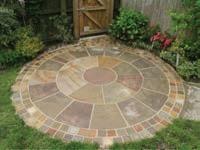

• One-part, air-drying, vacuum packed, polymeric compounds (supplied prebatched, in vacuum-sealed bags in tubs, ready-to-use, just open and brush/apply slurry directly from the bag). Best-in-Class: Patio Grout by GftK
• Cement-based, wet-slurry applied, mortars (supplied as prebatched powders in bags, ready to add to a measured quantity of clean water for mixing on site).
Best-in-Class: GftK vdw 400plus
• First-generation, two-part, epoxy resin-based (supplied as two or three components – resin and hardener to be premixed, then added to the sand/filler component, or as resin coated sand and hardener, to be premixed, then a measured quantity of water added and further mixed in the pail on site). Best-in-Class: GftK vdw 800
• Second-generation, two-part epoxy resin-based (supplied completely prebatched as resin coated sand and hardener for total control, and with no additional water or sand required). Best-in-Class: GftK vdw 850plus


There is a detailed description and summary of the characteristics and properties for each of these paving jointing material technologies on our website, including their performance and limitations, both in application and service, for you to consider when making the selection for your paving projects.
For any additional information and support, you can also talk direct to our paving jointing specialists: 01257 266696, or email us: sales@nccstreetscape.co.uk nccstreetscape.co.uk




IWhat are the main differences between contracts in the South vs in the North of England? Jason Knights of Ground Control delves into the matter...
n England, grounds maintenance contracts can vary greatly between the North and South of the country. These disparities are shaped by many factors such as, scope and scale of contracts, economic factors, service requirements, regulatory and environmental considerations, customer expectations, and workforce dynamics. Failure to understand these differences can have a significant impact on service delivery and providing the right environmental outcomes. So, what have we learnt from our 50 years creating and maintaining landscapes across Great Britain, Northern Ireland, and Ireland?

Understanding the differences
Climate and topography vary across regions , affecting our strategies. Different grasses, shrubs, and trees grow at different rates, necessitating varied management plans. Biodiversity recovery rates differ, soil type can be an influencing factor. Expectations on provider interaction with local communities vary. Variations exist in planning and requirements, which may increase with new government policies. Interpreting and adapting to regional regulations require careful consideration and effective engagement.
Similarities provide opportunities
Every community we work in wants better connections with nature, highlighting the importance of reliable, high quality service at a fair price. Respecting local preferences, rather than overshadowing them with central procurement, is essential. Providers are expected to contribute to social value,
ensuring their efforts benefit the community. Utilising data effectively is crucial for forming plans that enhance nature gain. Balancing national reach with local needs is imperative to meet these goals.
As a national provider, our field team model ensures we remain connected to understanding regional differences. This means we use local people, businesses and suppliers and show respect for local preference, especially in areas such health and safety, social value, nature gain, and carbon emission reduction.
We believe everyone values and prioritises human safety, and there is a collective aspiration to witness the recovery of nature and understand its contributions to people’s wellbeing. Taking an integrated approach to managing internal and external spaces, with data-driven decisions offers the best roadmap and foundation for environmental improvement plans. People are seeking ways to reduce carbon emissions; despite the daunting challenge it presents.
Our in-house tech platform and apps utilise collected data to provide local solutions with regional and national benefits. For instance, we have mapped the entire county of Essex to pinpoint priority areas for nature enhancement. Collaborating with Network Rail in the West of England and Wales, we develop plans to boost ecological and biodiversity gains along railways. Whether using our latest app to quickly assess habitat improvement plans around supermarket car parks in Newcastle and Edinburgh or deploying drones for larger, remote areas, data and technology is central to all our operations.
As a B Corp, we’re dedicated to learning how to reduce our carbon emissions, setting ambitious targets that exceed our stated goals for Scope 1 and Scope 3 emissions. Collaborating with our customers, we aim to develop a comprehensive carbon emission reporting ecosystem, which would benefit local business parks and shopping centres from Newcastle to Penzance. Regardless of the differences in the North and South, approaching delivery with genuine local understanding and leveraging shared aspirations provide opportunities to innovate and push boundaries, leading to tangible environmental efforts. Having a shared commitment to environmental stewardship inspires hope for a positive and sustainable future for us all.
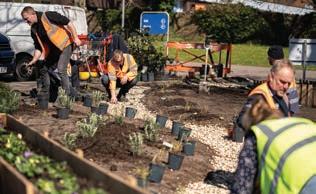
Jason Knights joined Ground Control as managing director in 2020, following 10 years in leadership roles at Wates. His last role was as managing director of SES Engineering Services, now a division of Wates Construction Group. Prior to this, he was managing director of Wates Building Services, and helped to grow the company from a start-up to a £120m-turnover business. ground-control.co.uk

Lewis Normand on advocating for horticulture: challenges, opportunities, and the path forward

This General Election was one of those monumental change votes that happens every 20 or so years. I think the appetite for a general election was very high, despite what politicians were suggesting and the number of PM changes we have experienced in recent years. I commented on my July Pro Landscaper opinion piece that we have difficulty vocalising our wants and needs from government; not because we don’t have much to ask, but because horticulture and landscape offer so much to the economy, wellbeing, the environment, ornament, and value to the UK.
We actually suffer with too many areas where we bring advantages to the country, and so our asks of government are often diffuse, as they are aimed at myriad Cabinet Ministers. I hope that in the Westminster government, the Defra Minister will seek to include horticulture and landscape more clearly as part of their remit and engage accordingly with the industry, which has economic value only second to agriculture.
I
significantly more costly and time consuming since Brexit and as a direct result of the UK government and not from Europe. Finally, I would like to see commitment to a green economy –Net Zero targets being reaffirmed rather than abandoned. Expansion of the Biodiversity Net Gain laws. Tree Planting targets being met annually. Significant changes to the laws on

will continue to lobby in Holyrood as I have in Westminster to showcase our offering and request support for this industry, we all love so dearly
In Scotland, where the Labour landslide observed elsewhere in the UK has also been reflected in votes for MPs, I hope that the more diverse make-up of party representation within Westminster will continue to support horticulture and landscape as we have seen with the majority SNP representation. In Holyrood, there are no immediate changes with MSPs not being affected by the GE.
I personally believe that regardless of your party beliefs, it is important to have representation from the breadth of parties within government and opposition. This represents an opportunity to find individuals on both sides of the house who will champion horticulture and value landscape.
I would like to see government investment in UK Nursery businesses through grant schemes, especially for technological improvements as we see in Europe. I would like to see horticulture being specifically named within the remit of the Defra Secretary. I would like to see a completely revised approach to reduction in administration costs and time in import/export, which have become
sewage dumping into rivers and the seas – possible future for nationalisation of water companies. A workable peat ban, which must include peat cut for burning, not just the villainisation of the compost industry. We need government investment in peat-free compost research and development. Commitment to increased water storage, especially in Southern England to mitigate hose pipe bans. It is difficult to ask for a joined-up approach to support our industry, but attitudinally, it needs to be primed to allow the government to understand us and to value our contribution to the UK as a whole. These are just some of the things we need the new Labour government to understand and to value so that we can grow the industry as well as benefit the UK.
I will continue to lobby in Holyrood as I have in Westminster to showcase our offering and request support for this industry, we all love so dearly.
Lewis
Normand
CHort MCIHort FLS BA (Hons) Garden Design PGCE TQFE QTLS
hello@luxunique.co.uk








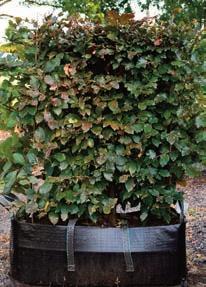
To buy yourself, and your clients, time you could use a pre-grown instant hedge. Practical Instant Hedge™ is available in various species and sizes, up to 2m high.
Evergreen hedges maintain their foliage throughout the year. This provides screening, privacy and shelter all year round.
Deciduous hedges shed their leaves in the winter. They offer year-round seasonal interest from flowers, coloured foliage, or autumn fruits.
Our mature hedge is easy to handle, can be planted all year round with no transplant shock. There are many varieties of Practical Instant Hedge™ that will suit your garden projects.
Tree & Hede Nursery
As well as Practical Instant Hedge™ we have a range of attractive screening trees at the nursery in Iver. You are welcome to visit to view both trees and hedges.
Book a visit or chat to our Horticultural team to find out more.

Contact us for details email hede@pracbrown.co.uk or call 01753 652022 for more information www.pracbrown.co.uk
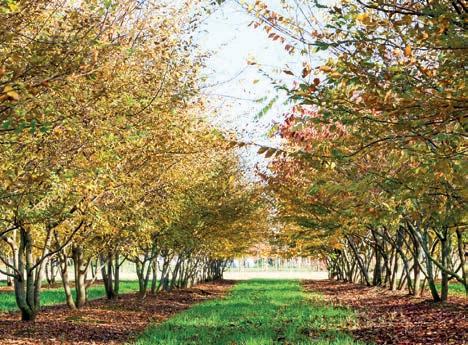

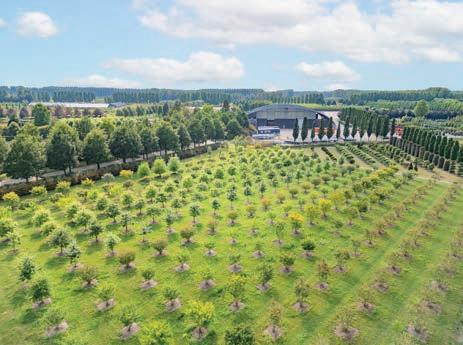


Like the rest of the UK, we’re seeing an increase in temperatures across all seasons, leading to mild, wet winters and drier, warmer summers with an increase in proportion of heavy rainfall events all year. In Scotland, the change in the climate has been far quicker than predicted.1,2 Last February (2023) saw temperatures in some areas already 2.5oC warmer and rainfall at levels forecast for 2050.2 The impact of the warmer, wetter winters is the spread of disease and pests, that would have been controlled by cold winters. The wetter winters are also causing plants to remain in wet soil f or longer periods of time.
In Scotland, the change in the climate has been far quicker than predicted
Anecdotally (I cannot find records of this), there seems to be an increase in easterly wind events bringing cold, drying air that is affecting trees that otherwise would have been sheltered from westerlies. Trees such as Acer sp., widely planted in the west of Scotland due to the previously favourable climate, are now affected by cold drying winds unless suitably planted in a very sheltered spot. Windy weather in the summer has also increased, causing damage to leaves and bringing down trees due to the sail effect outside the normal storm seasons.
ornamental industries that could become invasive. Species such as Anemanthele lessoniana, Vaccinium corymbosum and freshwater plants Hydrocotyle ranunculoides and Myriophyllum aquaticum are at high risk of arriving, establishing and impacting biodiversity and ecosystems in Scotland in the next 10 years from 20213. Since the workshop in 2021, reports of Anemanthele lessoniana have been made in four locations in Scotland: two in the South West and two in the North/North East.

On the west coast of Scotland, we are accustomed to rainy weather, especially during winter. However, these conditions have been worsening with prolonged periods of heavy rainfall and localised flooding, which have been observed throughout Scotland. This means we need to know the soil we are working with and plant accordingly, with a greater degree of diversity to provide resilience to the planting scheme. In an urban environment where no topsoil exists, perhaps consider using a free draining recycled sand or post-construction waste substrate as a planting media, and planting appropriately for the conditions. Plant sources that we often use are The Essential Tree Selection Guide, and Rain Gardens4,5 for selecting plants for varying conditions.

In previous years, (2024 is an exception probably due to El Niño), we’ve seen extensive dry periods from late March through to June, which effects the timing of planting and the effect on plants in subsequent years. We find that a combination of the right plant for the soil and location, soil amendments, such as compost if applicable to the site, and thick mulching helps regulate water during times of extreme weather. Planting in layers, with plants taking over as a living mulch will help regulate soil moisture conditions too and reduce ongoing work in mulching and resource use.
The rapidly changing climate has impacted the locations where we plant certain plants, which we would have been able to do only five years ago. For example, Actaea simplex. On the west of Scotland, we could get away with planting this in full sun, providing the soil was reliably moist; however, this is no longer the case. The other consideration is the increasing number of ‘non-native’ plants (and other species including pests and diseases) used in the horticultural and
With the rapidly changing climate, we can know our soil/ planting substrate, plant correctly for the conditions, mulch well, and use a variety of species to build resilience into our planting schemes.


We can also be mindful of where we plant and what we plant, especially near areas that could be prone to flooding, near water courses and on the boundary to natural environments to prevent inadvertent spread of plant species. We must ensure that our planting designs are adjusting to the changing climate, and adapt in the same way nature is evolving around us.
References
1 environment.gov.scot/our-environment/climate/changing-climate/
2 hutton.ac.uk/blog/how-is-scotlands-climate-changing/
3 gov.scot/publications/provision-horizon-scanning-analysis-pathways-spreadinvasive-species-scotland/pages/11/
4 The Essential Tree Selection Guide. Henrik Sjoman and Arit Anderson
5 Rain Gardens, Nigel Dunnett and Andy Clayden

How did the Welsh government’s U turn on artificial grass laws affect the supply and demand? Andy Driver of Evergreens UK Group

The Welsh Government minister’s challenge to ban artificial grass – and its subsequent U-turn – has caused little to no detriment on the supply of or demand for the Group’s products. With the artificial turf market estimated to be worth in excess of £2.5bn and still enjoying steady growth over the last 10 years, the significant demand spikes at the height of the pandemic home improvement wave saw sales of artificial grass more than double. A couple of sustained sunny summers also extended the appeal for outdoor living.
With artificial grass often taking the negative rap for the whole landscape sector, a UK leading supplier and specialist Evergreens UK has developed significant new products that offer genuine, invaluable propositions for the transformation of otherwise unloved and unmanageable spaces in gardens, urban, public and commercial areas.


In some circumstances, artificial grass can be the most practical and effective remedy for an outdoor space where otherwise natural grass or plants could simply not survive. Encouraging outdoor activity and play has well-documented benefits for health and wellbeing, and artificial grass can transform previously unusable spaces into functional areas for just that purpose. Any governmental restrictions would mean options for schools, play and uninhabitable areas would be limited or unfeasible. In these instances, an artificial lawn does not only provide vital outdoor spaces but it can extend and enhance the overall landscape, complemented by surrounding natural planting without compromising the biodiversity of the outdoor space.
Whilst most suppliers can fend off arguments regarding flood risk (superior products allow free-draining ingress of water) as well as its heat absorption (superior products are no hotter in high temperatures than other landscape surfaces and can be eased with kiln-dried sand infills), there is one aspect that is still a challenge for most – its recyclability.
The threat of a governmental blanket ban seems extreme and unnecessary. It is often more about making the best and most responsible product choice here – just like choosing decking instead of gravel; patio instead of turf; artificial grass instead of barren or muddy ground. The industry as a whole might have been lagging behind in its environmental conscience, but conscientious specialist suppliers like Evergreens UK have not. Its important strides forward in the development of single polymer products means that 100% circularity is already here, in the range of ONE-DNA™ artificial grass products. These next-generation products complete the recyclability circle; one polymer (PE); one recycling process; minimised waste and raw material usage; reduced CO2 emissions with improved production efficiencies and independently verified with Environmental Product Declarations (EPD). This next-level development assures landscape professionals that artificial grass still has an important place and future. It can continue to make a positive contribution as a viable, future-proofed remedy for troublesome outdoor spaces and innovative outdoor and indoor design. Evergreens UK Group is leading these environmental conversations, heading the development and supply of products where circularity and sustainability is of top importance and to dissuade and counter the often unfair or unfounded arguments levelled against the industry. evergreensukgroup.com/one-dna
Any governmental restrictions would mean options for schools, play and uninhabitable areas would be limited or unfeasible
Andy Driver has been driving and shaping the commercial programme across the Evergreens UK Group since 2005. Working with his sales and administrative team, Driver is at the spearhead of an established and respected 35 year-old business that has been an artificial grass pioneer from its infancy. The Rutland-based company incorporates LazyLawn, ArtificialGrass.com and EverRoof divisions, and is now part of The Tencate Group, global leaders in the manufacture and supply of synthetic turf.
evergreensukgroup.com

Upton Specialised Tree Services Ltd is a long established specialist arboricultural contractor based in Dorset, with a depot in Devizes, central Wiltshire.
We specialise in large complex jobs that require a great level of organisation, compliance, specialist equipment and efficient work practices. We are committed to delivering products, services, and support that consistently surpass those of our competitors. We employ 64 multi-skilled staff and are able to deliver a wide range of large projects on time and tailor our pricing to suit our clients' budgets.
We pride ourselves on employing a skilled and highly qualified team and continuously invest in up-skilling our staff, enabling them to forge strong careers in the arboricultural industry.
We are always on the lookout for new talent, and if you feel we could be the next step in your career, please visit the jobs page on our website.
Over the last five years, we have experienced constant year-on-year growth and have taken full advantage of the government’s generous capital expenditure allowance. We have a large fleet of new specialist

machinery which includes a state-of-the-art arboricultural specification Magni RTH 6.30 roto telehandler fitted with a Westtech CS750 Smart Grip saw, three forestry specification Valtra T Series tractors with Botex roof mounted timber cranes, two Heizohack whole tree chippers and a fleet of modern specialist arboricultural and agricultural equipment.
These investments have allowed us to seek out larger work opportunities and in 2021 we were awarded a prestigious six-year £18m contract for Wiltshire Council highways.


completed extensive, relevant training – including most recently, a course on Business and Climate Change at the Cambridge Institute for Sustainability Leadership –ensuring we are well equipped to manage relevant projects and initiatives.
We have a large fleet of new specialist machinery
We are a member of SME Climate Hub, a commitment to a governmentbacked pathway to net zero status.
As a member organisation we have committed to halving our greenhouse gas emissions before 2026 and reaching net zero emissions before 2030.

relevant certifications, including CHAS/SMAS accreditations and Construction Line Gold accreditation. We are an Arboricultural Association Approved Contractor and a ROSPA Silver Award Winner. We employ an in-house health and safety manager who holds a NEBOSH level 6 in Occupational Health and Safety. This commitment and culture to safety, coupled with our extensive experience, positions us as leading contender in the field of arboriculture.
Our commitment to green and sustainable outcomes is evidenced by third-party certification of our Environmental Management System to the ISO 14001 standard, and Energy Management System ISO 50001 standard.
We employ a full time environmental lead, who has



We are dedicated to the safe delivery of all our projects. All work is controlled by our management systems which is third-party certified to the ISO 9001, ISO14001 and ISO 45001 standards, ensuring robust management of safety, and integrating best practice defined and iterated over many years of operation.
The effectiveness of our approach to health and safety is further demonstrated by our


We are the go-to company for many of the local authorities and various government bodies, national home builders, housing associations, golf clubs, high net-worth individuals and we have an enviable client retention rate.
We have the capacity to engage with all types of new clients across the South, so if you require a fresh and reliable approach to your arboricultural need, please get in touch.
Tel: 01202 824 369 uptonltd.co.uk


M&M Timber incised green pressure-treated softwood sleepers offer a modern contemporary natural solution for various landscaping projects including earth retention, edging and straight line designs.
The incisions allow a deep penetration of preservative protection that meets Use Class 4 (UC4) BS8417 ground contact zone requirements, and the 2400 x 200 x 100mm sleepers are supplied with a 15 year warranty.

In the English garden architecture, formal shapes and forms still have their place. At Boom & Bonheur we have a large variety of assortment to fulfill these needs. The classics like Taxus, Fagus, Tilia, and fruits are present, but also shapes of Ginkgo, Larix and Carpinus are part of the assortment. You can find some of our Hornbeam hedge plants in the Garden of the Future at FutureScape 2024. You can also find us at stand Q74
Boom & Bonheur – because trees give life and bring happiness


Unilog Pro machine round pine timbers provide an attractive, practical and cost-effective solution for landscaping projects including earth retention or retaining wall systems.
The kiln dried timbers are pressure treated with wood preservative and supplied in diameters 100mm,125mm,150mm and 200mm; and lengths from 300mm to 3600mm.

Andrew Duff is starting from a blank canvas to ensure his designs are truly

Bespoke’ is a word which is often used in our profession. We include the word in our sales pitch, advocating that the design is bespoke to the client. Whilst clients are different, so much of the brief is habitually the same: parking for two cars, a space for pre-dinner drinks and somewhere for a morning coffee. Of course, clients’ tastes vary enormously, and it is this area of the brief which should be bespoke.
I sometimes feel that the house, site and surroundings are what make the design process truly bespoke. A designer friend of mine has spoken about ‘gently turning down the client’, by which he means listening to the brief but not allowing it to diminish the design process or indeed crush creativity.
We have all been in the overwhelming position where we are asked to include so many things in our designs that we become blind to the process.
Just like writers’ block, when the pressure is on, it effects the way in which we design
Just like writers’ block, when the pressure is on, it effects the way in which we design. I have seen designers procrastinate in the most amazing ways. If I’m uncertain about a design, I’ll do everything possible to avoid starting;
I’ll force the dog out on another walk, wash up everything which isn’t nailed down and then, finally, the great studio tidy.
We have tools to help us get started, though. I embrace the grid method developed by John Brookes as this ensures that a) I start drawing, and b) the grid lines are bespoke to the architecture of the house. Yes, bespoke! Don’t just draw a grid; the lines must come from the house, doors and windows – that’s why it works so well.
Recently, I have been seeking ways to ensure everything I design is truly bespoke, incorporates the clients wishes, but also respects the vernacular. I have resorted to drastic solutions. This month I cleansed
my studio of all inspirational images – you know the sort: corners ripped from magazines featuring that planting combination which I had thought of, that round reflective pool in a forest I should have designed, and so on.
With clear walls before me, I ensure all my books are in the correct place i.e. back on the shelves. This avoids reaching for the obvious and forces me to investigate and seek out other volumes. Next, and perhaps the more ruthless, is the material library cull. When I say cull, I have quite literally recycled and donated my entire collection. This is so liberating; I have shelf space that I have not seen for years and more space to put all the new books that I have yet to home.
All of this may seem like abstention. However, I started this rant talking about bespoke design, and once again I am having to look at the materials on site, how the house is built and what the local methods of building and material selection are. I can no longer simply glance up to see my favourite planting; I must investigate and research. “This is a waste of time,” I hear you shout. But try it –it is liberating for designer and design alike.


Wednesday 16 October, 2pm Inspire Theatre
Giving Back: A Sustainable Approach
Andrew Duff hosts a panel which will underline the SGD’s sustainability commitments
ANDREW DUFF
An internationally recognised garden designer, Andrew Duff MSGD has been designing gardens for over 30 years. In addition to running his practice, he is managing director of the world renowned Inchbald School of Design and is Chair of the Society of Garden Designers. sgd.org.uk
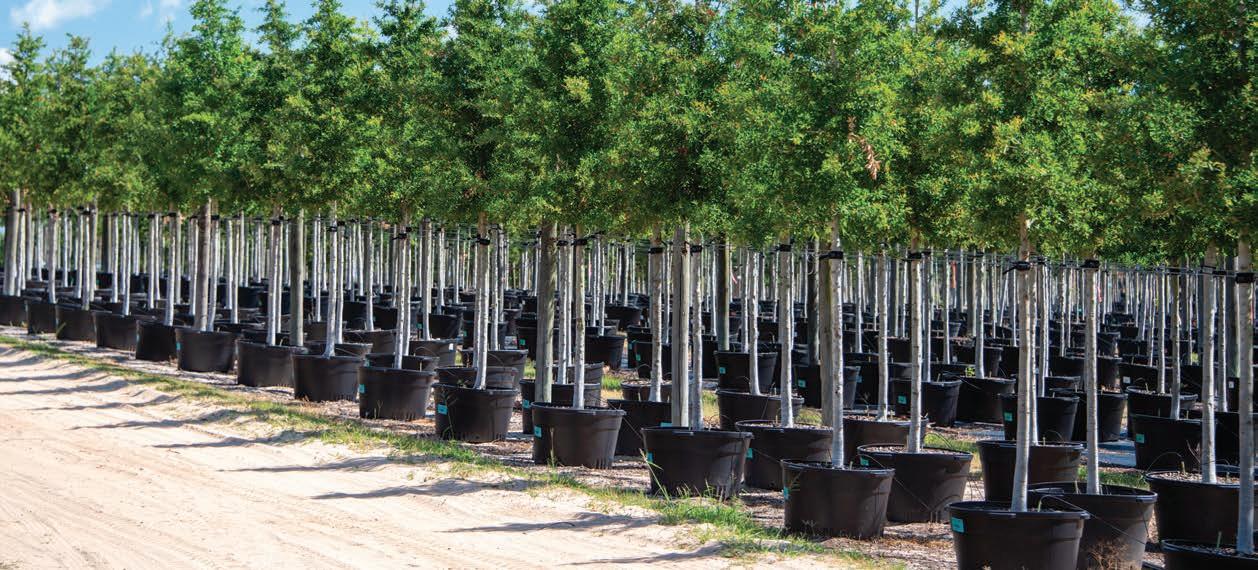
November is around the corner, and we all know what that means: tree-lifting season is nearly here! Summers are getting warmer, and our landscapes need trees more than ever before. The shade under a tree is always 10-15°C cooler and that difference can be a lifesaver during heatwaves, especially when temperatures hit 40°C! So please, let’s go forth and plant as many trees as possible this year.
While most of us know that planting the right tree in the right place is crucial, we still see people getting this wrong. For example, we would see lots of Amelanchier growing in sunny courtyards, chosen because they are small, ornamental and have good seasonal interest. Yet these woodland shrubs prefer semi-shade, so being in a hot courtyard would often lead to mildew and early leaf loss when the weather turns.
Factoring in watering commitments for newly planted trees is also incredibly important. We know of a county council that planted 200,000 trees last year but forgot to put a watering plan in place, so all the trees died, which was a shocking waste. So, careful planning and watering are the keys to success with trees.
Mark Straver shares a few tips ahead of the tree planting season to ensure they have the best chance of success – and impact
extended summers we have now. Non-native trees like Heptacodium miconioides ‘Seven Son Flower Tree’, Lagerstroemia 'Natchez’ and Tetradium daniellii ‘Bee-Bee Tree’ grow happily here and provide wildlife with food throughout the warmer autumns.
While you're planning your trees, also consider embracing a messier approach to your gardens next year. Decades ago, manicured hedges, tidy perennial borders, and short lawns were the gold standard for beautiful gardens. When I lived in my old cul-de-sac, I remember admiring the perfectly kept gardens; but in reality, they were barren of wildlife. The hedges were cut too short, so they grew dense, making them impregnable for the birds. The weed-free grass would turn brown by August because it couldn't shade itself. On the other side of the road were the rented houses – and perhaps for the wrong reasons, their gardens were wild and messy, but still buzzing with life!
While most of us know that planting the right tree in the right place is crucial, we still see people getting this wrong
• Don’t forget to double check the basics: Understand the light exposure and soil conditions of the garden and ensure they are a good match for the tree.
• Size really does matter: Trees come in three categories: small, medium, and large growing. Remember to choose the right size for the space to avoid underpowering or overpowering the garden.
• As always, remember seasonal interest: What will a tree bring to the garden throughout the year – spring blossoms, summer foliage, autumn colours, or interesting winter bark? Most trees fall into one or two categories, so consider how the garden will look each season.
• Don't always go native: Our native trees have shorter flowering seasons, as they have yet to catch up with the earlier springs and
Hedges full of berries with birds perched in the branches, long grass teeming with insects, and wildflowers keeping the pollinators happy.
Our industry has done so much to raise awareness of how gardens can support our environment since those days – but even now, we still see plenty of those neatly trimmed 'barren wastelands'. I want to see everyone ditching the clippers, getting messy, and letting nature take its course!
Always be in the know and subscribe to Hortus Loci’s weekly stock availability list. You’ll get an updated stock list sent straight to your inbox every week.

MARK STRAVER
Mark Straver is a third-generation nurseryman based in Hampshire and has worked with plants since the age of 16. He is joint owner and director at Hortus Loci, which he founded with Robin Wallis in 2011. He’s known in the gardening world for his ability to source the best wholesale plants internationally, using his extensive knowledge, connections, and experience in the industry.
hortusloci.co.uk

With OASE waterfalls
Whatever space you have to work with, adding moving water always improves the sense of relaxation. And you can create the perfect atmosphere using OASE’s stainless steel waterfalls.
With three sizes of waterfall available (30, 60 and 90 cm) you can be sure there’s one that will fit in the space you have to work with. They come with a threaded hosetail and can be recessed into a wall or screwed onto it.
If you’re not working with a pool or a pond, you can use OASE’s selfcontained reservoirs. These mean you don’t need to worry about open water. The pump and all the technology are hidden away meaning your water feature can be enjoyed from any angle.
All OASE features are available with optional LED lighting to ensure the space looks great at any time of the day or night.
OASE makes all the equipment needed to keep these features running, including energy efficient pumps with high quality German engineering. Find OASE technology, including Waterfalls at your local retailer today.
Discover more at oase.com





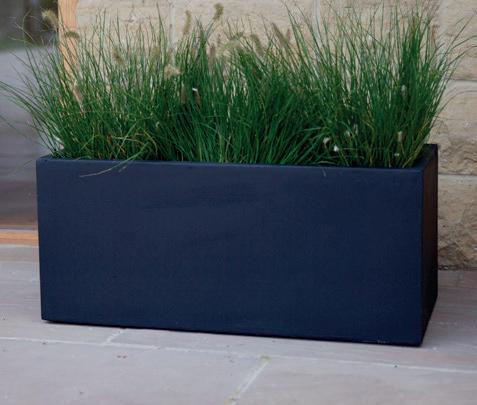



Plan your turfing projects with confidence.
Flexbility
Extended shelf-life to help accommodate on-site delays
Availability
Field-fresh turf when you need it
Reliability
99% customer satisfaction rate
Order direct for the freshest turf for your projects. Call 01904 757300
rolawn.co.uk


For all your Autumn planting projects and beyond why not give Spring Reach Nursery a try. Based in Surrey with over 25 years growing experience supplying leading garden designers and domestic landscapers you can expect a top quality service from initial enquiry through to delivery to site or collection. We have a superb choice of hardy nursery stock including some varieties that are not freely available.
• Always holding good stocks of those ever popular lines for immediate impact from large evergreen screening trees pleached panelled trees and multi-stems and specimen shrubs for immediate impact
• Thousands of Herbaceous perennials, Roses and Grasses for giving your design the wow in Summer and Autumn
• Conveniently situated just 10 Minutes from Junction 10 of the M25
• Deliveries made using own transport up to 150 miles or further a field by the pallet network.
Contact 01483 284769 | email info@springreachnursery.co.uk Long Reach Ockham Surrey Gu23 6PG www.springreachnursery.co.uk

Dave Strows offers insight into the new British Standard 7533-102, dispelling myths along the way
Bound, unbound, rigid, flexible, podium, block or beam? Type 1, type 3, concrete, hoggin, crushed or mot? Then there’s slip resistance, flexural strength and permeability to take into account. And metamorphic, igneous, or sedimentary?
With so many things to consider, it can be difficult to know where to start when deciding which product to use and the appropriate method of construction to apply.
Thankfully, the new British Standard 7533-102 sets out to make things a little easier.
What is the new standard?
The new standard is an installation guide for pavements of all traffic categories constructed using clay, concrete or natural stone paving units in all traffic categories. The document follows a similar format to the BS7533 101, which provides design guidance for all traffic categories, but this new standard contains a very important addition in the form of clause 4. Clause 4 provides both design and installation guidance for traffic categories 3 and below which are categorised as domestic in their use. Its purpose is to provide straight forward,
practical guidance for projects that have not been created with a design that is in accordance with the BS 7533-101.
If a project is deemed to fall within traffic category 4 and above, the user would refer to the BS 7533-101 for design guidance.
So, why bother including design guidance within the 102 when the 101 already provides design guidance?
The BS 7533-101 was primarily created to fulfil the requirements of the commercial sector and, as a result, it requires a degree of engineering experience to use effectively. The clause 4 within the new standard delivers guidance in a way that is more accessible to the less experienced user of a standard and increases the efficiency of the design process.
As with all things new, there is a transitional learning period and sometimes this faces resistance. Commonly held beliefs and historic practices are hard to move away from
An example of this would be when specifying natural stone. In order to find the appropriate thickness of stone for use in a particular traffic category in relation to its aspect profile and strength, the user of the 101 may be required to carry out an equation to achieve the result. The 102 breaks natural stone down into three commonly found strength ratings and uses a table to provide the required stone thickness for each aspect profile and particular traffic category. If the stone strength falls below the strength range, it is deemed that the design requires more technical evaluation, and the user would refer to the equations in the 101.
The clause 4 also delivers guidance on site evaluation and assessment in a way that is more accessible to the contractor working on
a domestic project. For example, elements such as the process of evaluating the strength of the subgrade can be carried out using a simple boot test, the depth of the impression left can be related to a CBR value.
When dealing with projects of traffic category 4 and above, however, a more technical assessment would be required, and the user would refer to the 101 for the design guidance.
What other benefits does it bring?
Apart from being a fit for purpose source of specification, one obvious benefit of the new standard is that it raises awareness of various construction options. During my work as a mediator, I often deal with construction failures that are a result of a contractor’s preference for a particular type of construction method, rather than them having evaluated the requirements of the subgrade and choosing the most suitable approach. Permeable and unbound construction options are often overlooked, despite in many cases being excellent alternatives to bound construction and highly relevant to current sustainability and biodiversity concerns.
“trader” associations serves to blur the lines between a professional landscaper and an odd job person, and the introduction of a standard helps to define expectations.
What are the potential issues?
The BS 7533-102 is not designed to be a tool to make our job harder; it is the beginning of a better future of our industry
Of course, as with all things new, there is a transitional learning period and sometimes this faces resistance. Commonly held beliefs and historic practices are hard to move away from, especially when we are dealing with an industry within which those operating have largely gained knowledge by putting together nuggets of advice from varied sources or by learning on the job.
Our industry is moving forward, and this new document provides a sound basis upon which we can create a structured career path. This is the first step toward an industry that recognises one source of fit for purpose specification, upon which we can not only provide our clients with the confidence that we are achieving construction excellence, but also come together as an industry to create a comprehensive structured route of learning for vocational qualifications and career progression.
In the same way that an electrician or heating engineer is required to undergo regular inspections and CPD to retain their status, a similar process could then be applied to our industry.
Aesthetic decisions can often be the focus of a project, leading to the construction element becoming a secondary concern and potentially compromised. This new standard helps us to focus on the correct process of evaluation and approach our design from the bottom up rather than the top down.
Another huge benefit to our industry of adopting the standard is our ability to elevate our status within the perception of the public, from that of a trade to a profession. The constant media advertising from certain
I say this as someone who has been in the industry for three decades and began their career in the same way as many others, with no qualifications in the subject, just the experience gained from working as a labourer and moving my way through the trades until eventually becoming a landscaper. When I look back at some of those early gardens, I shudder at the thought of my lack of knowledge and I’m all too aware that in some instances, like many others, I was charging my clients whilst learning on the job. The knowledge I had gained prior to starting out as a sole trader was largely based on the opinion or preferred working practice of the person who employed me at the time, and this often led to confusion around which approach was the correct one. It also delayed my career progression by a decade by not enabling me to achieve qualifications within my industry that would have acknowledged my level of knowledge and skills.
As I’m sure we will all agree, landscaping is not an easy profession and for many it is a vocation; the skills and knowledge required to successfully navigate all of the requirements and demands faced by the modern landscaper are already extensive, and will no doubt be ever increasing as new materials and installation techniques are added to the market. The presence of a document that supports us in our evaluation and installation practice, enables due diligence, provides fit for purpose specification and assurance to the client of our professional credentials can only be a benefit.
On a personal note, I am always proud to say that I am a member of the Association of Professional Landscapers (APL) due to its commitment to providing unrivalled support and guidance to its members and the industry. As such, the APL is fully committed to the new standard, and will be supporting its members by providing education, seminars and ongoing training to ease the transition.
The BS 7533-102 is not designed to be a tool to make our job harder; it is the beginning of a better future of our industry. It opens new possibilities and removes uncertainty. The standard delivers far more than it requires from us and is a benefit to us all.

David Strows is the current vice chair of the Association of Professional Landscapers (APL) and a member of the BS7533 committee. Based in Buckinghamshire, he owned a design and build landscaping company for 30 years and is now an independent consultant and mediator. artformlandscapes.co.uk






• Everything built-in, behind the cover.
• Ready-to-control, 8 zone irrigation system with WiFi connectivity.
• Manages multiple locations remotely with real-time alerts.
• Fast set up with Quick Pair Technology & Schedule Templates.
Simply the most advanced smart controller technology. Learn more at RainBird.com/RC2





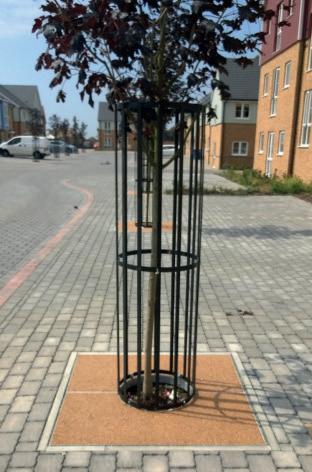
CIS Street Furniture offer a diverse range of
As a result of the built environment compaction can inhibit or prevent natural root growth of trees. CIS SUDs compliant resin bound tree grilles are a great way of enhancing the sustainability of your project for future generations. Find out more at our website below.
www.cis-streetfurniture.co.uk





















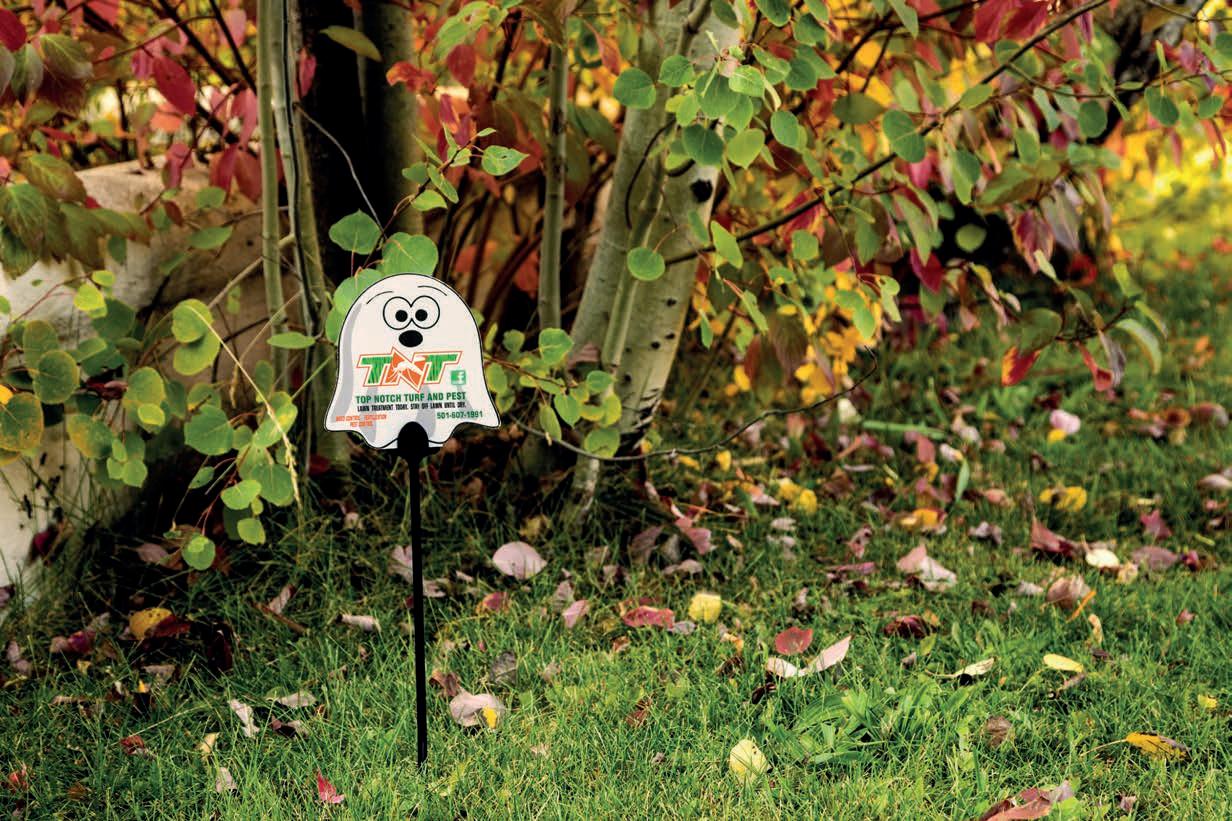

Wyevale Nurseries’ new sales and marketing director, Kersten Catella embraces a new challenge with her recent appointment to the BALI Board of Directors
What drew you into the industry?
Having worked in the ornamental sector for 20 years where I served on the NFU Horticulture Board, I was looking for a new challenge in a sector that I had not yet explored to add my value into. There’s a lot of synergy across all the horticulture sectors but landscaping offered a whole new experience, new groups of people and I wanted to jump in.
Can you tell us a bit about your new role at BALI?
What are you most looking forward to while on the board?
Being seated next to a team of incredibly talented and experienced board of directors and learning from them, there's a wealth of experience around that table and a lot of people I admire.
It is about sharing our experiences and mentoring the younger generation, and being available to help and add value wherever we can
We're a governing body of the association, responsible for providing strategic leadership and ultimately the direction of the organisation. Although the board works together for the best interests of the association and its members, each director has their own focus and passion within the wider industry. We have our first board meeting in October, so we'll see what's on the table when we get there.
What prompted you to apply for the position?
Having also served the ornamental sector as chairperson on the BPOA (British Protected Ornamentals Association), I have always enjoyed being outwardly focussed on sharing industry issues, changes and challenges. It has always been important to me to give back.
I am incredibly proud to have an MD and CEO who support this. So thank you to Andy Johnson and Heather Williamson for allowing me to do this.
But really it is about sharing our experiences and mentoring the younger generation, and being available to help and add value wherever we can. We're mindful that our sector has a lot of very experienced people, and a gap between experienced people and the younger generation, and we want to help bridge that gap.
If you had any words of wisdom for the future generations joining the industry, what would they be?
For anyone stepping into the landscaping industry, always stay curious and adaptable. This work isn’t just about cutting grass or planting trees; it’s about creating living art, transforming spaces, and improving the environment.
The future of landscaping isn’t just in aesthetics; it's about sustainability, resilience, and harmony with the environment

harmony with the environment. It’s on you to lead in shaping landscapes that don’t just look beautiful today but thrive in the years to come.
Wyevale Nurseries
And understand that the future of landscaping isn’t just in aesthetics; it's about sustainability, resilience, and
Email: info@wyevalenurseries.co.uk
Phone: 01432 845200
wyevalenurseries.co.uk
